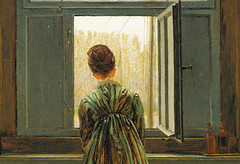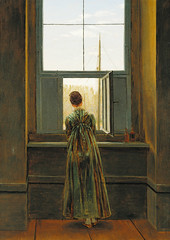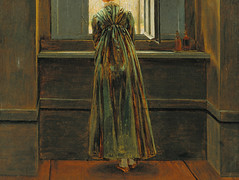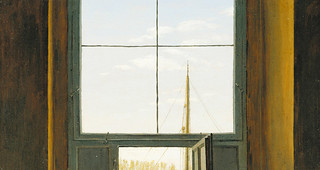8.2: Romanticism
- Page ID
- 67082
\( \newcommand{\vecs}[1]{\overset { \scriptstyle \rightharpoonup} {\mathbf{#1}} } \)
\( \newcommand{\vecd}[1]{\overset{-\!-\!\rightharpoonup}{\vphantom{a}\smash {#1}}} \)
\( \newcommand{\dsum}{\displaystyle\sum\limits} \)
\( \newcommand{\dint}{\displaystyle\int\limits} \)
\( \newcommand{\dlim}{\displaystyle\lim\limits} \)
\( \newcommand{\id}{\mathrm{id}}\) \( \newcommand{\Span}{\mathrm{span}}\)
( \newcommand{\kernel}{\mathrm{null}\,}\) \( \newcommand{\range}{\mathrm{range}\,}\)
\( \newcommand{\RealPart}{\mathrm{Re}}\) \( \newcommand{\ImaginaryPart}{\mathrm{Im}}\)
\( \newcommand{\Argument}{\mathrm{Arg}}\) \( \newcommand{\norm}[1]{\| #1 \|}\)
\( \newcommand{\inner}[2]{\langle #1, #2 \rangle}\)
\( \newcommand{\Span}{\mathrm{span}}\)
\( \newcommand{\id}{\mathrm{id}}\)
\( \newcommand{\Span}{\mathrm{span}}\)
\( \newcommand{\kernel}{\mathrm{null}\,}\)
\( \newcommand{\range}{\mathrm{range}\,}\)
\( \newcommand{\RealPart}{\mathrm{Re}}\)
\( \newcommand{\ImaginaryPart}{\mathrm{Im}}\)
\( \newcommand{\Argument}{\mathrm{Arg}}\)
\( \newcommand{\norm}[1]{\| #1 \|}\)
\( \newcommand{\inner}[2]{\langle #1, #2 \rangle}\)
\( \newcommand{\Span}{\mathrm{span}}\) \( \newcommand{\AA}{\unicode[.8,0]{x212B}}\)
\( \newcommand{\vectorA}[1]{\vec{#1}} % arrow\)
\( \newcommand{\vectorAt}[1]{\vec{\text{#1}}} % arrow\)
\( \newcommand{\vectorB}[1]{\overset { \scriptstyle \rightharpoonup} {\mathbf{#1}} } \)
\( \newcommand{\vectorC}[1]{\textbf{#1}} \)
\( \newcommand{\vectorD}[1]{\overrightarrow{#1}} \)
\( \newcommand{\vectorDt}[1]{\overrightarrow{\text{#1}}} \)
\( \newcommand{\vectE}[1]{\overset{-\!-\!\rightharpoonup}{\vphantom{a}\smash{\mathbf {#1}}}} \)
\( \newcommand{\vecs}[1]{\overset { \scriptstyle \rightharpoonup} {\mathbf{#1}} } \)
\( \newcommand{\vecd}[1]{\overset{-\!-\!\rightharpoonup}{\vphantom{a}\smash {#1}}} \)
\(\newcommand{\avec}{\mathbf a}\) \(\newcommand{\bvec}{\mathbf b}\) \(\newcommand{\cvec}{\mathbf c}\) \(\newcommand{\dvec}{\mathbf d}\) \(\newcommand{\dtil}{\widetilde{\mathbf d}}\) \(\newcommand{\evec}{\mathbf e}\) \(\newcommand{\fvec}{\mathbf f}\) \(\newcommand{\nvec}{\mathbf n}\) \(\newcommand{\pvec}{\mathbf p}\) \(\newcommand{\qvec}{\mathbf q}\) \(\newcommand{\svec}{\mathbf s}\) \(\newcommand{\tvec}{\mathbf t}\) \(\newcommand{\uvec}{\mathbf u}\) \(\newcommand{\vvec}{\mathbf v}\) \(\newcommand{\wvec}{\mathbf w}\) \(\newcommand{\xvec}{\mathbf x}\) \(\newcommand{\yvec}{\mathbf y}\) \(\newcommand{\zvec}{\mathbf z}\) \(\newcommand{\rvec}{\mathbf r}\) \(\newcommand{\mvec}{\mathbf m}\) \(\newcommand{\zerovec}{\mathbf 0}\) \(\newcommand{\onevec}{\mathbf 1}\) \(\newcommand{\real}{\mathbb R}\) \(\newcommand{\twovec}[2]{\left[\begin{array}{r}#1 \\ #2 \end{array}\right]}\) \(\newcommand{\ctwovec}[2]{\left[\begin{array}{c}#1 \\ #2 \end{array}\right]}\) \(\newcommand{\threevec}[3]{\left[\begin{array}{r}#1 \\ #2 \\ #3 \end{array}\right]}\) \(\newcommand{\cthreevec}[3]{\left[\begin{array}{c}#1 \\ #2 \\ #3 \end{array}\right]}\) \(\newcommand{\fourvec}[4]{\left[\begin{array}{r}#1 \\ #2 \\ #3 \\ #4 \end{array}\right]}\) \(\newcommand{\cfourvec}[4]{\left[\begin{array}{c}#1 \\ #2 \\ #3 \\ #4 \end{array}\right]}\) \(\newcommand{\fivevec}[5]{\left[\begin{array}{r}#1 \\ #2 \\ #3 \\ #4 \\ #5 \\ \end{array}\right]}\) \(\newcommand{\cfivevec}[5]{\left[\begin{array}{c}#1 \\ #2 \\ #3 \\ #4 \\ #5 \\ \end{array}\right]}\) \(\newcommand{\mattwo}[4]{\left[\begin{array}{rr}#1 \amp #2 \\ #3 \amp #4 \\ \end{array}\right]}\) \(\newcommand{\laspan}[1]{\text{Span}\{#1\}}\) \(\newcommand{\bcal}{\cal B}\) \(\newcommand{\ccal}{\cal C}\) \(\newcommand{\scal}{\cal S}\) \(\newcommand{\wcal}{\cal W}\) \(\newcommand{\ecal}{\cal E}\) \(\newcommand{\coords}[2]{\left\{#1\right\}_{#2}}\) \(\newcommand{\gray}[1]{\color{gray}{#1}}\) \(\newcommand{\lgray}[1]{\color{lightgray}{#1}}\) \(\newcommand{\rank}{\operatorname{rank}}\) \(\newcommand{\row}{\text{Row}}\) \(\newcommand{\col}{\text{Col}}\) \(\renewcommand{\row}{\text{Row}}\) \(\newcommand{\nul}{\text{Nul}}\) \(\newcommand{\var}{\text{Var}}\) \(\newcommand{\corr}{\text{corr}}\) \(\newcommand{\len}[1]{\left|#1\right|}\) \(\newcommand{\bbar}{\overline{\bvec}}\) \(\newcommand{\bhat}{\widehat{\bvec}}\) \(\newcommand{\bperp}{\bvec^\perp}\) \(\newcommand{\xhat}{\widehat{\xvec}}\) \(\newcommand{\vhat}{\widehat{\vvec}}\) \(\newcommand{\uhat}{\widehat{\uvec}}\) \(\newcommand{\what}{\widehat{\wvec}}\) \(\newcommand{\Sighat}{\widehat{\Sigma}}\) \(\newcommand{\lt}{<}\) \(\newcommand{\gt}{>}\) \(\newcommand{\amp}{&}\) \(\definecolor{fillinmathshade}{gray}{0.9}\)Romanticism
In Romanticism, humanity confronted its fears and proclivity for violence.
c. 1800 - 1848
A beginner's guide
A beginner’s guide to Romanticism
by DR. BETH HARRIS and DR. STEVEN ZUCKER
19th century stylistic developments
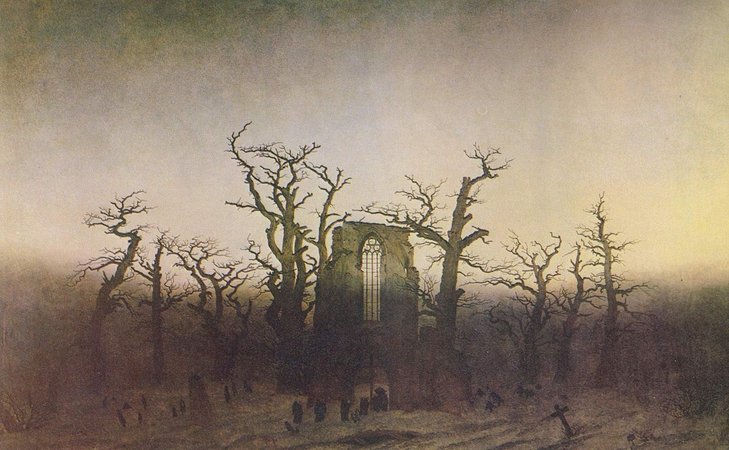
As is fairly common with stylistic rubrics, the word “Romanticism” was not developed to describe the visual arts but was first used in relation to new literary and musical schools in the beginning of the 19th century. Art came under this heading only later. Think of the Romantic literature and musical compositions of the early 19th century: the poetry of Lord Byron, Percy Shelley, and William Wordsworth and the scores of Beethoven, Richard Strauss, and Chopin—these Romantic poets and musicians associated with visual artists. A good example of this is the friendship between composer and pianist Frederic Chopin and painter Eugene Delacroix. Romantic artists were concerned with the spectrum and intensity of human emotion.


Even if you do not regularly listen to classical music, you’ve heard plenty of music by these composers. In his epic film, 2001: A Space Odyssey, the late director Stanley Kubrick used Strauss’s Thus Spake Zarathustra (written in 1896, Strauss based his composition on Friedrich Nietzsche’s book of the same name, listen to it here). Kubrick’s A Clockwork Orange similarly uses the sweeping ecstasy and drama of Beethoven’s Ninth Symphony, in this case to intensify the cinematic violence of the film.
Romantic music expressed the powerful drama of human emotion: anger and passion, but also quiet passages of pleasure and joy. So too, the French painter Eugene Delacroix and the Spanish artist Francisco Goya broke with the cool, cerebral idealism of David and Ingres’ Neo-Classicism. They sought instead to respond to the cataclysmic upheavals that characterized their era with line, color, and brushwork that was more physically direct, more emotionally expressive.
Additional resources:
Romanticism on The Metropolitan Museum of Art’s Heilbrunn Timeline of Art History
Romanticism as a literary movement from Mount Holyoke College
From NPR: The ‘Ode To Joy’ [Beethoven’s Ninth Symphony] As A Call To Action
Smarthistory images for teaching and learning:
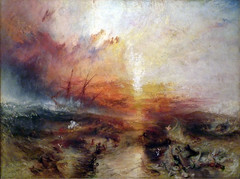
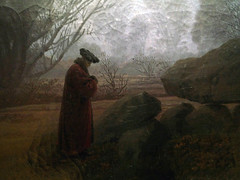
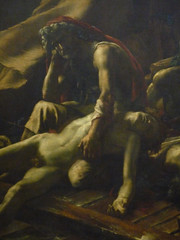
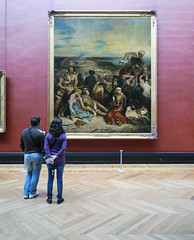
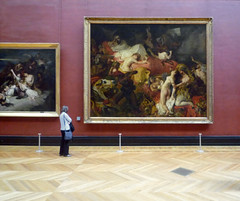
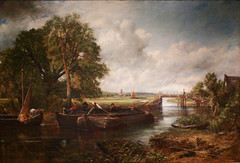

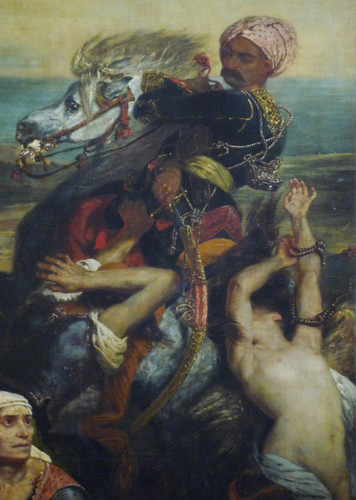
Orientalism

The origins of Orientalism
Snake charmers, carpet vendors, and veiled women may conjure up ideas of the Middle East, North Africa, and West Asia, but they are also partially indebted to Orientalist fantasies. To understand these images, we have to understand the concept of Orientalism, beginning with the word “Orient” itself. In its original medieval usage, the “Orient” referred to the “East,” but whose “East” did this Orient represent? East of where?

We understand now that this designation reflects a Western European view of the “East,” and not necessarily the views of the inhabitants of these areas. We also realize today that the label of the “Orient” hardly captures the wide swath of territory to which it originally referred: the Middle East, North Africa, and Asia. These are at once distinct, contrasting, and yet interconnected regions. Scholars often link visual examples of Orientalism alongside the Romantic literature and music of the early nineteenth century, a period of rising imperialism and tourism when Western artists traveled widely to the Middle East, North Africa, and Asia. We now understand that the world has been interconnected for much longer than we initially acknowledged and we can see elements of Orientalist representation much earlier—for example, in religious objects of the Crusades, or Gentile Bellini’s painting of the Ottoman sultan (ruler) Mehmed II (above), or in the arabesques (flowing s-shaped ornamental forms) of early modern textiles.
The politics of Orientalism
In his groundbreaking 1978 text Orientalism, the late cultural critic and theorist Edward Saïd argued that a dominant European political ideology created the notion of the Orient in order to subjugate and control it. Saïd explained that the concept embodied distinctions between “East” (the Orient) and “West” (the Occident) precisely so the “West” could control and authorize views of the “East.” For Saïd, this nexus of power and knowledge enabled the “West” to generalize and misrepresent North Africa, the Middle East and Asia. Though his text has itself received considerable criticism, the book nevertheless remains a pioneering intervention. Saïd continues to influence many disciplines of cultural study, including the history of art.
Representing the “Orient”
As art historian Linda Nochlin argued in her widely read essay, “The Imaginary Orient,” from 1983, the task of critical art history is to assess the power structures behind any work of art or artist.[1] Following Nochlin’s lead, art historians have questioned underlying power dynamics at play in the artistic representations of the “Orient,” many of them from the nineteenth century. In doing so, these scholars challenged not only the ways that the “West” represented the “East,” but they also complicate the long held misconception of a unidirectional westward influence. Similarly, these scholars questioned how artists have represented people of the Orient as passive or licentious subjects.

For example, in the painting The Snake Charmer and His Audience, c. 1879, the French artist Jean-Léon Gérôme’s depicts a naked youth holding a serpent as an older man plays the flute—charming both the snake and their audience. Gérôme constructs a scene out of his imagination, but he utilizes a highly refined and naturalistic style to suggest that he himself observed the scene. In doing so, Gérôme suggests such nudity was a regular and public occurrence in the “East.” In contrast, artists like Henriette Browne and Osman Hamdi Bey created works that provide a counter-narrative to the image of the “East” as passive, licentious or decrepit. In A Visit: Harem Interior, Constantinople, 1860, the French painter Browne represents women fully clothed in harem scenes. Likewise, the École des Beaux Arts-trained Ottoman painter Osman Hamdi Bey depicts Islamic scholarship and learnedness in A Young Emir Studying, 1878.

Orientalism: fact or fiction?
Orientalist paintings and other forms of material culture operate on two registers. First, they depict an “exotic” and therefore racialized, feminized, and often sexualized culture from a distant land. Second, they simultaneously claim to be a document, an authentic glimpse of a location and its inhabitants, as we see with Gérôme’s detailed and naturalistic style. In The Snake Charmer and His Audience, Gérôme constructs this layer of exotic “truth” by including illegible, faux-Arabic tilework in the background. Nochlin pointed out that many of Gérôme’s paintings worked to convince their audiences by carefully mimicking a “preexisting Oriental reality.”[2]

Surprisingly, the invention of photography in 1839 did little to contribute to a greater authenticity of painterly and photographic representations of the “Orient” by artists, Western military officials, technocrats, and travelers. Instead, photographs were frequently staged and embellished to appeal to the Western imagination. For instance, the French Bonfils family, in studio photographs, situated sitters in poses with handheld props against elaborate backdrops to create a fictitious world of the photographer’s making.

In Orientalist secular history paintings (narrative moments from history), Western artists portrayed disorderly and often violent battle scenes, creating a conception of an “Orient” that was rooted in incivility. The common figures and locations of Orientalist genre paintings (scenes of everyday life)—including the angry despot, licentious harem, chaotic medina, slave market, or the decadent palace—demonstrate a blend of pseudo-ethnography based on descriptions of first-hand observation and outright invention. These paintings created visions of a decaying mythic “East” inhabited by a controllable people without regard to geographic specificity. Artists operating in this vein include Jean-Léon Gérôme, Eugène Delacroix, Jean-Auguste-Dominique Ingres, and others. In the visual discourses of Orientalism, we must systematically question any claim to objectivity or authenticity.
Global imperialism and consumerism
We also must consider the creation of an “Orient” as a result of imperialism, industrial capitalism, mass consumption, tourism, and settler colonialism in the nineteenth century. In Europe, trends of cultural appropriation included a consumerist “taste” for materials and objects, like porcelain, textiles, fashion, and carpets, from the Middle East and Asia. For instance, Japonisme was a trend of Japanese-inspired decorative arts, as were Chinoiserie (Chinese-inspired) and Turquerie (Turkish-inspired). The ability of Europeans to purchase and own these materials, to some extent confirmed imperial influence in those areas.

The phenomenon of World’s Fairs and cultural-national pavilions (beginning with the Crystal Palace in London in 1851 and continuing into the twentieth century) also supported the goals of colonial expansion. Like the decorative arts, they fostered the notion of the “Orient” as an entity to be consumed through its varied pre-industrial craft traditions.
We see this continually in the architectural imitations built on the grounds of these fairs, that sought to provide both spectacle and authenticity to the fair goer. For instance, at the 1867 Exposition Universelle in Paris, the designers of the Egyptian section Jacques Drévet and E. Schmitz topped what was supposed to represent the residential khedival (Ottoman Empire ruler’s) palace with a dome typical of mosque architecture.[3] Yet, they also attached to this building a barn (not typical of a khedival palace) that housed imported donkeys brought in to give visitors the impression of reality.[4] The fairs objectified the otherness of non-Western peoples, cultures, and practices.
Orientalism constructs cultural, spatial, and visual mythologies and stereotypes that are often connected to the geopolitical ideologies of governments and institutions. The influence of these mythologies has impacted the formation of knowledge and the process of knowledge production. In this light, as Saïd and Nochlin remind us, when we see Orientalist works like Gérôme’s Snake Charmer, we should ask what idea of the “Orient” we see, and why?
- Linda Nochlin, “The Imaginary Orient,” Art in America, vol. IXXI, no. 5 (1983), pp. 118–31.
- Ibid., 37.
- Zeynep Çelik, Displaying the Orient: Architecture of Islam at Nineteenth-Century World’s Fairs (Berkeley: University of California Press, 1992).
- Timothy Mitchell, Colonizing Egypt, (Berkeley: University of California Press, 1991).
Additional resources:
Roger Benjamin, Orientalist Aesthetics: Art, Colonialism, and French North Africa 1880–1930 (Berkeley: University of California Press, 2003).
Zeynep Çelik, “Colonialism, Orientalism, and the Canon” The Art Bulletin 78, no. 2 (June 1996): pp. 202-205.
Zeynep Çelik, Displaying the Orient: Architecture of Islam at Nineteenth-Century World’s Fairs (Berkeley: University of California Press, 1992).
Oleg Grabar, “Europe and the Orient: An Ideologically Charged Exhibition.” Muqarnas VII (1990): pp. 1-11.
Robert Irwin, Dangerous Knowledge: Orientalism and its Discontents (Woodstock, NY: Overlook Press, 2006).
J.M. MacKenzie, Orientalism: History, Theory, and the Arts (Manchester, NY: Manchester University Press, 1995).
Linda Nochlin, “The Imaginary Orient,” A. America, IXXI/5 (1983): pp. 118–31.
Edward Saïd, Orientalism (New York: Vintage Books, 1978).
Edward Saïd, “Orientalism Reconsidered,” Race & Class 27, no. 2 (Autumn 1985): pp. 1-15.
Nicholas Tromans, ed. The Lure of the East: British Orientalist Painting (London: Tate, 2008).
Stephen Vernoit and D. Behrens-Abouseif, eds. Islamic Art in the Nineteenth Century: Tradition, Innovation, and Eclecticism (Leiden; Boston: Brill Publishers, 2006).
Smarthistory images for teaching and learning:
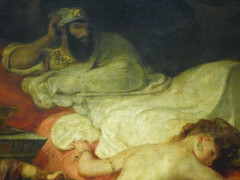
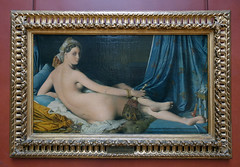
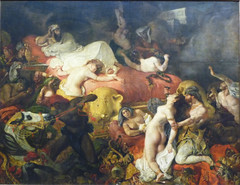
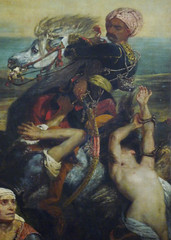

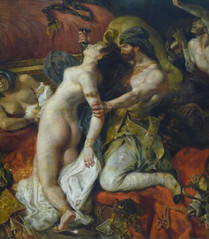

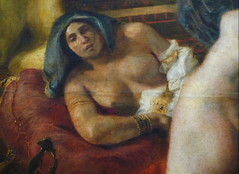

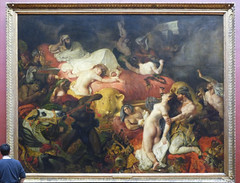
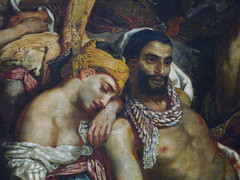
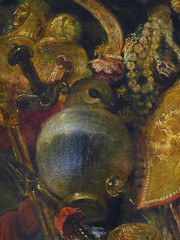
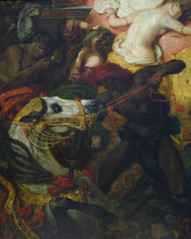

Romanticism in France
“Romanticism lies neither in the subjects that an artist chooses nor in his exact copying of truth, but in the way he feels…."
—Charles Baudelaire
Romanticism in France
In the decades following the French Revolution and Napoleon’s final defeat at Waterloo (1815) a new movement called Romanticism began to flourish in France. If you read about Romanticism in general, you will find that it was a pan-European movement that had its roots in England in the mid-eighteenth century. Initially associated with literature and music, it was in part a response to the rationality of the Enlightenment and the transformation of everyday life brought about by the Industrial Revolution. Like most forms of Romantic art, nineteenth-century French Romanticism defies easy definitions. Artists explored diverse subjects and worked in varied styles so there is no single form of French Romanticism.
Intimacy, spirituality, color, yearning for the infinite
Even when Charles Baudelaire wrote about French Romanticism in the middle of the nineteenth century, he found it difficult to concretely define. Writing in his Salon of 1846, he affirmed that “romanticism lies neither in the subjects that an artist chooses nor in his exact copying of truth, but in the way he feels…. Romanticism and modern art are one and the same thing, in other words: intimacy, spirituality, color, yearning for the infinite, expressed by all the means the arts possess.”

One might trace the emergence of this new Romantic art to the painting of Jacques-Louis David who expressed passion and a very personal connection to his subject in Neoclassical paintings like Oath of the Horatii and Death of Marat. If David’s work reveals the Romantic impulse in French art early on, French Romanticism was more thoroughly developed later in the work of painters and sculptors such as Theodore Gericault, Eugène Delacroix and François Rude.
In 1810, Germaine de Staël introduced the new Romantic movement to France when she published Germany (De l’Allemagne). Her book explored the concept that while Italian art might draw from its roots in the rational, orderly Classical (ancient Greek and Roman) heritage of the Mediterranean, the northern European countries were quite different. She held that her native culture of Germany—and perhaps France—was not Classical but Gothic and therefore privileged emotion, spirituality, and naturalness over Classical reason. Another French writer Stendhal (Henri Beyle) had a different take on Romanticism. Like Baudelaire later in the century, Stendhal equated Romanticism with modernity. In 1817 he published his History of Painting in Italy and called for a modern art that would reflect the “turbulent passions” of the new century. The book influenced many younger artists in France and was so well-known that the conservative critic Étienne Jean Delécluze mockingly called it “the Koran of the so-called Romantic artists.”
The direct expression of the artist’s persona
The first marker of a French Romantic painting may be the facture, meaning the way the paint is handled or laid on to the canvas. Viewed as a means of making the presence of the artist’s thoughts and emotions apparent, French Romantic paintings are often characterized by loose, flowing brushstrokes and brilliant colors in a manner that was often equated with the painterly style of the Baroque artist Rubens. In sculpture artists often used exaggerated, almost operatic, poses and groupings that implied great emotion. This approach to art, interpreted as a direct expression of the artist’s persona—or “genius”—reflected the French Romantic emphasis on unregulated passions. The artists employed a widely varied group of subjects including the natural world, the irrational realm of instinct and emotion, the exotic world of the “Orient” and contemporary politics.

Man and nature
The theme of man and nature found its way into Romantic art across Europe. While often interpreted as a political painting, Théodore Géricault’s remarkable Raft of the Medusa (1819) confronted its audience with a scene of struggle against the sea. In the ultimate shipwreck scene, the veneer of civilization is stripped away as the victims fight to survive on the open sea. Some artists, including Gericault and Delacroix, depicted nature directly in their images of animals. For example, the animalier (animal sculptor) Antoine-Louis Barye brought the tension and drama of “nature red in tooth and claw” to the exhibition floor in Lion and Serpent (1835.)

Not solely reason, but also emotion and instinct

Another interest of Romantic artists and writers in many parts of Europe was the concept that people, like animals, were not solely rational beings but were governed by instinct and emotion. Gericault explored the condition of those with mental illness in his carefully observed portraits of the insane such as Portait of a Woman Suffering from Obsessive Envy (The Hyena), 1822. On other occasions artists would employ literature that explored extreme emotions and violence as the basis for their paintings, as Delacroix did in Death of Sardanapalus (1827-28.)
Eugène Delacroix, who once wrote in his diary “I dislike reasonable painting,” took up the English Romantic poet Lord Byron’s play Sardanapalus as the basis for his epic work Death of Sardanapalus (below) depicting an Assyrian ruler presiding over the murder of his concubines and destruction of his palace. Delacroix’s swirling composition reflected the Romantic artists’ fascination with the “Orient,” meaning North Africa and the Near East—a very exotic, foreign, Islamic world ruled by untamed desires. Curiously, Delacroix preferred to be called a Classicist and rejected the title of Romantic artist.
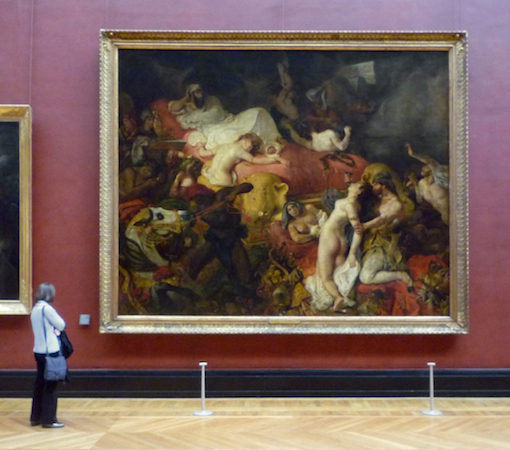
Whatever he thought of being called a Romantic artist, Delacroix brought his intense fervor to political subjects as well. Responding to the overthrow of the Bourbon rulers in 1830, Delacroix produced Liberty Leading the People (below, 1830). Brilliant colors and deep shadows punctuate the canvas as the powerful allegorical figure of Liberty surges forward over the hopeful and despairing figures at the barricade.


That intensity of emotion, so characteristic of French Romantic art, would be echoed if not amplified by the sculptor François Rude’s Departure of the Volunteers of 1792 (La Marseillaise) (1833-6). Its energetic winged figure of France/Liberty, a modern Nike, seems to scream out as she leads the native French forward to victory in one of the very few Romantic public monuments.
Today, French Romanticism remains difficult to define because it is so diverse. Baudelaire’s comments from the Salon of 1846 may still apply: “romanticism lies neither in the subjects that an artist chooses nor in his exact copying of truth, but in the way he feels.”
Additional resources:
Romanticism on The Metropolitan Museum of Art’s Heilbrunn Timeline of Art History
Smarthistory images for teaching and learning:

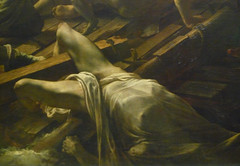
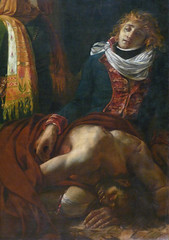
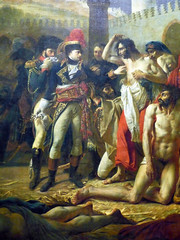
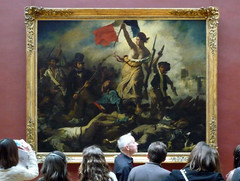


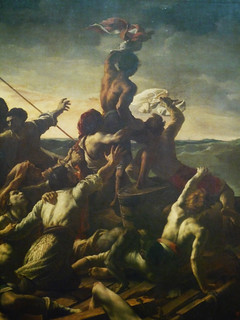
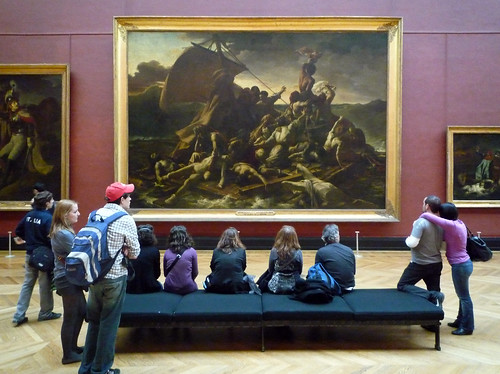
Baron Antoine-Jean Gros, Napoleon Bonaparte Visiting the Pest House in Jaffa
by DR. BETH HARRIS and DR. STEVEN ZUCKER
Video \(\PageIndex{1}\): Baron Antoine-Jean Gros, Napoleon Bonaparte Visiting the Pest House in Jaffa, 1804, oil on canvas, 209 x 280″ (Musée du Louvre, Paris)
Gros was a student of the Neo-Classical painter Jacques-Louis David. However, this painting, sometimes also titled Napoleon Visiting the Pest House in Jaffa, is a proto-Romantic painting that points to the later style of Gericault and Delacroix. Gros was trained in David’s studio between 1785-1792, and is most well known for recording Napoleon’s military campaigns, which proved to be ideal subjects for exploring the exotic, violent, and heroic. In this painting, which measures more than 17 feet high and 23 feet wide, Gros depicted a legendary episode from Napoleon’s campaigns in Egypt (1798-1801).
On March 21, 1799, in a make-shift hospital in Jaffa, Napoleon visited his troops who were stricken with the Bubonic Plague. Gros depicts Napoleon attempting to calm the growing panic about contagion by fearlessly touching the sores of one of the plague victims. Like earlier neoclassical paintings such as David’s Death of Marat, Gros combines Christian iconography, in this case Christ healing the sick, with a contemporary subject. He also draws on the art of classical antiquity, by depicting Napoleon in the same position as the ancient Greek sculpture, the Apollo Belvedere. In this way, he imbues Napoleon with divine qualities while simultaneously showing him as a military hero. But in contrast to David, Gros uses warm, sensual colors and focuses on the dead and dying who occupy the foreground of the painting. We see the same approach later in Delacroix’s painting of Liberty Leading the People (1830).
Napoleon was a master at using art to manipulate his public image. In reality he had ordered the death of the prisoners whom he could not afford to house or feed, and poisoned his troops who were dying from the plague as he retreated from Jaffa.
Smarthistory images for teaching and learning:
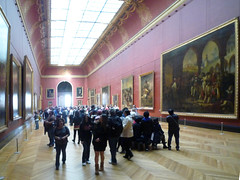




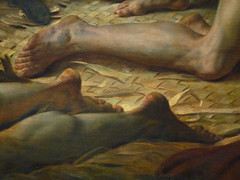

Jean-Auguste-Dominique Ingres
Jean-Auguste-Dominique Ingres, Portrait of Madame Rivière
by BEN POLLITT
Not to Invent but to continue…
“Everything has been done before” Ingres once wrote. “Our task is not to invent but to continue what has already been achieved.” Hardly any wonder then, being so suspicious of innovation, that his work is often set against the more radical painting styles of his age.

The conflict between Ingres and Delacroix, master of the nouvelle école (new school), is the stuff of art historical legend; in one corner, Ingres the Neoclassicist, all finesse, the consummate draughtsman, upholding the primacy of line; in the other, Delacroix the Romantic, all passion, a master of the virtuosic brushstroke, whose work abounds with expressive color.
And yet, to polarize them in this way, does an injustice to both artists. Certainly, as this painting demonstrates, Ingres was more than capable of bending the rules of academic practice and as such perhaps has more in common with his great rival than one might at first suspect.
Wealth and status
The subject of the painting is Madame Philibert Rivière, the wife of a high-ranking government official in the Napoleonic Empire. Framed within an oval, the sitter reclines on a divan, her left arm resting on a velvet cushion. She looks out, her gaze meeting us, though obliquely, as if lost in her own thoughts. Comfortable with her beauty, surrounded by ample evidence of her wealth and high social standing, she does not need to seek our approval.
Her clothes signal her status. Dressed in a white satin dress, around her shoulder is draped a voluminous cashmere shawl which swirls rhythmically around her shoulders and right arm. Gold links shimmer on her neck and wrists. Even her carefully coifed raven black hair, bound in curls, as was the fashion, attests to her affluence, being held in place by the application of huile antique, an extremely expensive scented oil that only the rich could afford.
Textures
As with so many of his portraits, Ingres delights in capturing surface textures: the plush velvet; the crisp brightness of the silk, tanning the flesh; the twisted tassel of the cushion; the polished finish on the wood grain, all weave around and animate the figure. Note the way, for example, the shawl directs us to her face or the white muslin frames her hair, billowing off to the right so as to counterbalance the thrust of her left arm. Note too, the relationship between her corkscrew curls and the tendril decorations on the wooden base of the divan. Everything, it would appear, seems designed to harmonize the figure within the setting.
Contemporary critics, reflecting the taste of the time, thought that Ingres had taken things too far, describing the sitter as “so enveloped in draperies that one spends a long time in guesswork before recognizing anything.” In Ingres’ defense, though, despite the richness of surface the figure still dominates the canvas. This is achieved, among other things, by that central vertical axis, running down from her right eye to the ring on her right hand. The imagined line is bisected by a pool of light – the brightest passage of the painting and one that also marks its central axis—reflected off the ribbon sash on her Empire Line dress. These subtle interplays of color and line create harmonious forms which some critics have likened to music.
The oval frame
The carefully worked out substructure is a response to the challenges created by the oval shaped frame. In order not to have the figure topple one way or another, the picture’s dimensions need to be accommodated to ensure the parts relate to the whole. Ingres manages this repeatedly in the painting. The supple arabesques formed by her shawl, for example, echo the pictorial space, as of course does the oval of her face. This is also true of the treatment of the body itself; most dramatically, Madame Rivière’s right arm has been deliberately elongated so as to rhyme with the curve of the frame.
At home in her imperial finery
In the end, we are left with the impression of an individual who is very much at home in her surroundings. So much so, in fact, as to be almost fortified by them. They compliment and flatter her too. Notice, for example, the way that muslin serves to veil her left shoulder, concealing any awkwardness in the passage between her arm and her torso kindly negating any signs of aging. In her mid-thirties, she looks ageless, a woman in the prime of her life secure in her Imperial finery. We are reminded of those Roman and Etruscan matrons reclining on their sarcophagi, unaffected by the ravishes of time, death and decay.
Jean-Auguste-Dominique Ingres, Napoleon on His Imperial Throne
by DR. BRYAN ZYGMONT

Napoleon, art and politics

Few world leaders have had a better understanding of the ways in which visual art can do political work on their behalf than did Napoleon Bonaparte. From the time he ascended to power during the French Revolution until his ultimate removal from office in 1815, Napoleon utilized art (and artists) to speak to his political (and sometimes his military) might. One of the best-known images that serves this exact end is Jean-Auguste-Dominique Ingres’s 1806 painting Napoleon on His Imperial Throne. In this painting, Ingres shows Napoleon not only as a emperor of the French, but almost as if he were a divine ruler.
Shortly after the turn of the nineteenth century, Ingres was one of the rising stars and fresh voices of the French neoclassical movement, an artistic style that was in part founded by Ingres’s prestigious teacher, Jacques-Louis David. By 1806, David had painted Napoleon many times. Two of the most famous of these works are Napoleon Crossing the Alps (1801) and The Coronation of Napoleon (1805-1807), the latter, a painting that is contemporary with Ingres’s portrait. In both of these images, David went out of his way to glorify his patron. This too was one of Ingres’s primary goals, and the portraitist utilized furniture, attire, and setting to transform Napoleon from mere mortal to powerful god.
Transforming Napoleon


Throne and armrest
Napoleon sits on an imposing, round-backed and gilded throne, one that is similar to those that God sits upon in Jan van Eyck’s Flemish masterwork, the Ghent Altarpiece (1430-32) (comparison above). Its worth noting that, as a result of the Napoleonic Wars, the central panels of the Ghent Altarpiece that include the image of God upon a throne, were in the Musée Napoléon (now the Louvre) when Ingres painted this portrait. The armrests in Ingres’s portrait are made from pilasters that are topped with carved imperial eagles and highly polished ivory spheres (left).
Rug
A similarly spread-winged imperial eagle appears on the rug in the foreground. Two cartouches can be seen on the left-hand side of the rug (below). The uppermost is the scales of justice (some have interpreted this as a symbol for the zodiac sign for Libra), and the second is a representation of Raphael’s Madonna della Seggiola (1513-14), an artist and painting Ingres particularly admired.

Crest

One final ancillary element should be mentioned. On the back wall over Napoleon’s left shoulder is a partially visible heraldic shield. The iconography for this crest, however, is not that of France, but is instead Italy and the Papal States. This visually ties the Emperor of the French to his position—since 1805—as the King of Italy.
Robes and accessories
It is not only the throne that speaks to rulership. He unblinkingly faces the viewer. In addition, Napoleon is bedazzled in attire and accouterments of his authority. He wears a gilded laurel wreath on his head, a sign of rule (and more broadly, victory) since classical times.

In his left hand Napoleon supports a rod topped with the hand of justice, while with his right hand he grasps the scepter of Charlemagne. Indeed, Charlemagne was one of the rulers Napoleon most sought to emulate (one may recall that Charlemagne’s name was incised on a rock in David’s earlier Napoleon Crossing the Alps). An extravagant medal from the Légion d’honneur (like the one below, right) hangs from the Emperor’s shoulders by an intricate gold and jewel-encrusted chain.
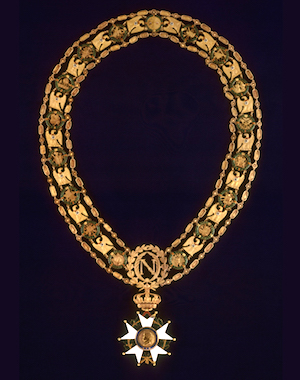
Although not immediately visible, a jewel-encrusted coronation sword hangs from his left hip (image below). The reason why the sword—one of the most recognizable symbols of rulership—can hardly be seen is because of the extravagant nature of Napoleon’s coronation robes. An immense ermine collar is under Napoleon’s Légion d’honneur medal. Ermine—a kind of short-tailed weasel—have been used for ceremonial attire for centuries and are notable for their white winter coats that are accented with a black tip on their tail. Thus, each black tip on Napoleon’s garments represents a separate animal. Clearly, then, Napoleon’s ermine collar—and the ermine lining under his gold-embroidered purple velvet robes—has been made with dozens of pelts, a certain sign of opulence. The purple color of the garment was a deliberate choice, and has a long tradition as a hue restricted for imperial use. Indeed, Roman emperors had exclusive right to wear purple, and it was through this tradition that Jesus also came to wear violet robes. All these elements—throne, scepters, sword, wreath, ermine, purple, and velvet—speak to Napoleon’s position as Emperor.


Position
But it is not only what Napoleon wears. It is also how the emperor sits. In painting this portrait, Ingres borrowed from other well-known images of powerful male figures. Perhaps the most notable was a long-since-destroyed but still well known image of Zeus (the ancient Greek God, king of the gods of Mount Olympus) that Phidias, one of the most famous of Greek sculptors, made around 435 B.C.E. This ‘type’ showed Zeus seated, frontal, and with one arm raised while the other was more at rest. Indeed, this is the posture Jupiter takes in a slightly later Ingres painting, Jupiter and Thetis (1811). Thus, Ingres is working in yet another rich visual tradition, and in doing so, seems to remove Napoleon Bonaparte from the ranks of the mortals of the earth and transforms him into a Greek or Roman god of Mt. Olympus. Never once accused of modesty, there is no doubt that Napoleon approved of such a comparison.
Looking at Ingres’s Napoleon on His Imperial Throne is a visually overwhelming experience. Its colossal size (it measures 8’6” x 5’4”) and neoclassical precision eloquently speak to Napoleon’s political authority and military power. The low eye level—about that of Napoleon’s knees—also indicates that the viewer is looking up at the seated ruler, as if kneeling before him. The sum total of this painting is not just the coronation of Napoleon, but almost his divine apotheosis. Ingres shows him not just as a ruler, but as omnipotent immortal.
Additional resources:
This painting at the Musée de l’Armée, Paris
Ingres, Napoleon on His Imperial Throne from learner.org
Jean-Auguste-Dominique Ingres, Apotheosis of Homer
by DR. BETH HARRIS and DR. STEVEN ZUCKER

A student of the past
Jean-Auguste-Dominique Ingres (pronounced: aah-n Gr-ah) was Jacque-Louis David’s most famous student. And while this prolific and successful artist was indebted to his teacher, Ingres quickly turned away from him. For his inspiration, Ingres, like David in his youth, rejected the accepted formulas of his day and sought instead to learn directly from the ancient Greek as well as the Italian Renaissance interpretation of this antique ideal.
Ingres exhibited Apotheosis of Homer (1827) in the annual Salon. His grandest expression of the classical ideal, this nearly seventeen foot long canvas reworks Raphael’s Vatican fresco, The School of Athens (1509-1511) and thus pays tribute to the genius Ingres most admired.

As Raphael had done three hundred years earlier, Ingres brought together a pantheon of luminaries. Like secular sacra-conversaziones, the Raphael and the Ingres bring together figures that lived in different eras and places.
But while Raphael celebrated the Roman Church’s High Renaissance embrace of Greek intellectuals (philosophers, scientists, etc.), Ingres also includes artists (visual and literary).
Homage to artists

Set on a pedestal at the center of the Apotheosis of Homer, the archaic Greek poet is conceived of as the wellspring from which the later Western artistic tradition flows. The entire composition functions somewhat like a family tree. Homer is framed by both historical and allegorical figures and an Ionic temple that enforces the classical ideals of rational measure and balance. Nike, the winged Greek goddess of the running shoe (ahem, of victory) crowns Homer with a wreath of laurel, while below him sit personifications of his two epic poems, The Odyssey (in green and holding an oar) and The Illiad (in red and seated beside her sword).

Note the following figures (please consider their implied importance according to their placement relative to Homer):
- Dante, the Medieval poet and humanist stands at the extreme left wearing a red scull cap and cape;
- Phidias, the greatest of ancient sculptors is standing to the right of Homer, in red, holding a mallet;
- Raphael, third from the left edge, top row, is in profile and wears Renaissance garb; Ingres (he’s put himself in rather good company don’t you think?) is the young face looking out at us beside Raphael;
- Poussin, points us toward Homer from the lower left of the canvas; and
- Michelangelo is the bearded figure at lower right.
Additional resources:
Smarthistory images for teaching and learning:
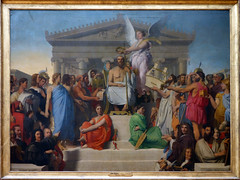
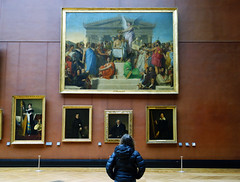
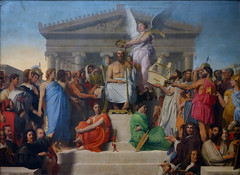
Between Neoclassicism and Romanticism: Ingres, La Grande Odalisque
by DR. BRYAN ZYGMONT

A quick study

Jean-Auguste-Dominique Ingres was an artist of immense importance during the first half of the nineteenth century. His father, Jean-Marie-Joseph Ingres was a decorative artist of only minor influence who instructed his young son in the basics of drawing by allowing him to copy the family’s extensive print collection that included reproductions from artists such as Boucher, Correggio, Raphael, and Rubens. In 1791, at just 11 years of age, Ingres the Younger began his formal artistic education at the Académie Royale de Peinture, Sculpture et Architecture in Toulouse, just 35 miles from his hometown of Montauban.
Ingres was a quick study. In 1797—at the tender age of 16 years—he won the Académie’s first prize in drawing. Clearly destined for great things, Ingres packed his trunks less than six months later and moved to Paris to begin his instruction in the studio of Jacques-Louis David, the most strident representative of the Neoclassical style. David stressed to those he instructed the importance of drawing and studying from the nude model. In the years that followed, Ingres not only benefitted from David’s instruction—and the prestige and caché that such an honor bestowed—but also learned from many of David’s past students who frequented their former teacher’s studio. These artists comprise a “who’s who” of late-eighteenth-century French neoclassical art and include painters such as Jean-Germain Droais, Anne-Louis Girodet, and Antoine Jean-Gros.
The Rome Prize—a bright future

The Prix de Rome—the Rome Prize—was the most prestigious fellowship that the French government awarded to a student at the Paris École des Beaux-Arts (School of Fine Arts), the leading art school in France from its founding in 1663 until it was finally dissolved in 1968. The recipient of the Prix de Rome was provided with a living stipend, studio space at the French Academy in Rome, and the opportunity to immerse themselves in Rome’s classical ruins and the works of Renaissance and Baroque masters. It promised to be a great five years for any aspiring artist. Joseph-Marie Vien, David’s own teacher, had won the award in 1743. David won the award in 1774—after four unsuccessful attempts. Ingres was formally admitted to the painting department of the École des Beaux-Arts in October 1799. The following year—in only his first attempt—Ingres tied for second place. In 1801, his painting of The Ambassadors of Agamemnon in the Tent of Achilles won him the Prix de Rome. He turned 21 years old that August. Ingres had a bright future indeed.
Hierarchy of subjects
The Prix de Rome—to say nothing of the instruction Ingres received within David’s studio and at the École des Beaux-Arts—reinforced the hierarchy of the subjects of painting that had been a foundational element of French art instruction for more than a century. Artists with the greatest skill aspired to complete grand manner history paintings. These were immense compositions often depicting narratives from the classical past or from the Jewish and Christian Bibles. In addition to being large—and expensive—these works allowed the most accomplished and intellectually engaged artists to provide the art-viewing public with an important moral message—an exemplum virtutis (an example of virtue). David’s 1784 masterwork Oath of the Horatii is one such example.


The nude (and not the classical past)
Due to the financial woes of the French government in the first years of the nineteenth century, Ingres’s Prix de Rome—which he won in 1801—was delayed until 1806. Two years later, Ingres sent to the École three compositions—intended to demonstrate his artistic growth while studying at the French Academy in Rome. Interestingly, all three of these works—The Valpinçon Bather, the so-called Sleeper of Naples, and Oedipus and the Sphinx—depict elements of the female nude (to be fair, however, the sphinx is not human). The first two, however, do not depict a story from the classical past. Instead, nearly the entire focus of each composition is on the female form. While Ingres has retained the formal elements that were so much a part of his neoclassical training—extreme linearity and a cool, “licked’ surface” (where brushwork is nearly invisible)—he had begun to reject neoclassical subject matter and the idea that art should be morally instructive. Indeed, by 1808, Ingres was beginning to walk on both sides of the neoclassical/romantic divide. In few works is a Neoclassical style fused with a romantic subject matter more clearly than in Ingres’s 1814 painting La Grande Odalisque.
Ingres completed his time at the French Academy in Rome in 1810. Rather than immediately return to Paris however, he remained in the Eternal City and completed several large-scale history paintings. In 1814 he traveled to Naples and was employed by Caroline Murat, the Queen of Naples (who also happened to be Napoleon Bonaparte’s sister). She commissioned La Grande Odalisque, a composition that was intended to be a pendant to his earlier composition, Sleeper of Naples.

At first glance, Ingres’s subject matter is of the most traditional sort. Certainly, the reclining female nude had been a common subject matter for centuries. Ingres was working within a visual tradition that included artists such as Giorgione (Sleeping Venus, 1510), Titian (Venus of Urbino, 1538) and Velazquez (Rokeby Venus, 1647-51). But the titles for all three of those paintings have one word in common: Venus. Indeed, it was common to cloak paintings of the female nude in the disguise of classical mythology.

Ingres (and Goya, who was working within a similar vein with his La Maja Desnuda—see below) refused to disguise who and what his female figure was. She was not the Roman goddess of love and beauty. Instead, she was an odalisque, a concubine who lived in a harem and existed for the sexual pleasure of the sultan.

In his painting La Grande Odalisque (below), Ingres transports the viewer to the Orient, a far-away land for a Parisian audience in the second decade of the nineteenth century (in this context, “Orient” means Near East more so than the Far East). The woman—who wears nothing other than jewelry and a turban—lies on a divan, her back to the viewer. She seemingly peeks over her shoulder, as if to look at someone who has just entered her room, a space that is luxuriously appointed with fine damask and satin fabrics. She wears what appears to be a ruby and pearl encrusted broach in her hair and a gold bracelet on her right wrist. In her right hand she holds a peacock fan, another symbol of affluence, and another piece of metalwork—a facedown bejeweled mirror, perhaps?—can be seen along the lower left edge of the painting.

Along the right side of the composition we see a hookah, a kind of pipe that was used for smoking tobacco, hashish and opium. All of these Oriental elements—fabric, turban, fan, hookah—did the same thing for Ingres’s odalisque as Titian’s Venetian courtesan being labeled “Venus”—that is, it provided a distance that allowed the (male) viewer to safely gaze at the female nude who primarily existed for his enjoyment.


And what a nude it is. When glancing at the painting, one can immediately see the linearity that was so important to David in particular, and the French neoclassical style more broadly. But when looking at the odalisque’s body, the same viewer can also immediately notice how far Ingres has strayed from David’s particular style of rendering the human form—look for instance at her elongated back and right arm. David was largely interest in idealizing the human body, rendering it not as it existed, but as he wished it did, in an anatomically perfect state. David’s commitment to the idealizing the human form can clearly be seen in his preparatory drawings for his never completed Oath of the Tennis Court(left). There can be no doubt that this is how David taught Ingres to render the body.
Students often stray from their teacher’s instruction, however. In La Grande Odalisque, Ingres rendered the female body in an exaggerated, almost unbelievable way. Much like the Mannerists centuries earlier—Parmigianino’s Madonna of the Long Neck (c. 1535) immediately comes to mind—Ingres distorted the female form in order to make her body more sinuous and elegant. Her back seems to have two or three more vertebrae than are necessary, and it is anatomically unlikely that her lower left leg could meet with the knee in the middle of the painting, or that her left thigh attached to this knee could reach her hip. Clearly, this is not the female body as it really exists. It is the female body, perhaps, as Ingres wished it to be, at least for the composition of this painting. And in this regard, David and his student Ingres have attempted to achieve the same end—idealization of the human form—though each strove to do so in markedly different ways.

A brief comparison between teacher and student makes clear how far Ingres had strayed from the neoclassical path David had laid. In some ways, La Grande Odalisque is based upon David’s 1800 portrait of Madame Récamier.

Both images show a recumbent woman who peers over her shoulder to look at the viewer. David and Ingres utilize line in a similar way. However, David depicts Récamier at the height of neoclassical fashion, wearing an Empire waistline dress and an à la grecque hairstyle. One gets the sense that there is real a body underneath that dress. In contrast, Ingres’s odalisque is a naked “other” from the Orient, and no clothing could disguise the elongations and anatomical inaccuracies of her body. David remained a committed neoclassicist, while his former student retained his neoclassical line to embrace, in this case, a geographically distant and romantic subject. This tension between Neoclassicism and Romanticism will continue throughout the first half of the nineteenth century as painters will tend to side with either Ingres and his precise linearity or the painterly style of the younger painter Eugène Delacroix.
Additional resources:
The French Academy in Rome on The Metropolitan Museum of Art’s Heilbrunn Timeline of Art History
The Prix de Rome
Smarthistory images for teaching and learning:

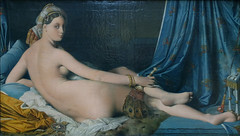




Painting colonial culture: Ingres’s La Grande Odalisque
by DR. BETH HARRIS and DR. STEVEN ZUCKER
Video \(\PageIndex{2}\): Jean-Auguste-Dominique Ingres, La Grande Odalisque, 1814, Oil on canvas, 36″ x 63″ (91 x 162 cm), (Musée du Louvre, Paris)

Early Romantic tendencies
It would be easy to characterize Ingres as a consistent defender of the Neoclassical style from his time in Jacques Louis David’s studio into the middle of the 19th century. But the truth is more interesting than that.
Ingres actually returned to Neoclassicism after having first rejected the lessons of his teacher David. He could even be said to have laid the foundation for the emotive expressiveness of Romanticism (the new style of Gericault and the young Delacroix that Ingres would later hold the line against). Ingres’s early Romantic tendencies can be seen most famously in his painting La Grande Odalisque of 1814.

La Grande Odalisque
Here a languid nude is set in a sumptuous interior. At first glance this nude seems to follow in the tradition of the Great Venetian masters, see for instance, Titian’s Venus of Urbino of 1538 (left). But upon closer examination, it becomes clear that this is no classical setting. Instead, Ingres has created a cool aloof eroticism accentuated by its exotic context. The peacock fan, the turban, the enormous pearls, the hookah (a pipe for hashish or perhaps opium), and of course, the title of the painting, all refer us to the French conception of the Orient. Careful—the word “Orient” does not refer here to the Far East so much as the Near East or even North Africa.

In the mind of an early 19th century French male viewer, the sort of person for whom this image was made, the odalisque would have conjured up not just a harem slave—itself a misconception—but a set of fears and desires linked to the long history of aggression between Christian Europe and Islamic Asia (see the essay on Orientalism). Indeed, Ingres’ porcelain sexuality is made acceptable even to an increasingly prudish French culture because of the subject’s geographic distance. Where, for instance, the Renaissance painter Titian had veiled his eroticism in myth (Venus), Ingres covered his object of desire in a misty, distant exoticism.

Some art historians have suggested that colonial politics also played a role. France was at this time expanding its African and Near Eastern possessions, often brutally. Might the myth of the barbarian have served the French who could then claim a moral imperative? By the way, has anyone noticed anything “wrong” with the figure’s anatomy?
Additional resources:
Extra vertebrae in Ingres’ La Grande Odalisque, Journal of the Royal Society of Medicine
Orientalism at the Heilbrunn Timeline of Art History, Metropolitan Museum of Art
Smarthistory images for teaching and learning:






Théodore Géricault
Théodore Géricault, Raft of the Medusa
by DR. BETH HARRIS and DR. STEVEN ZUCKER
Video \(\PageIndex{3}\): Théodore Géricault, Raft of the Medusa, 1818-19, oil on canvas, 4.91 x 7.16m (Musée du Louvre, Paris)
Smarthistory images for teaching and learning:
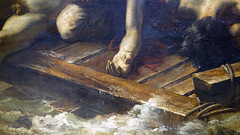


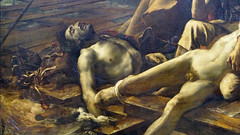
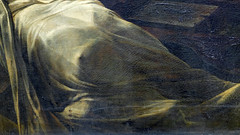
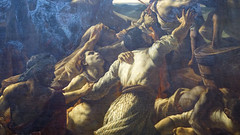
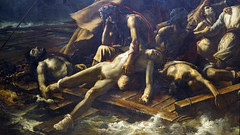
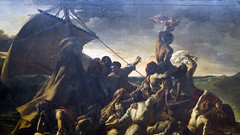
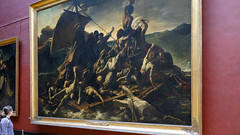
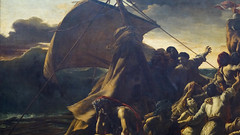

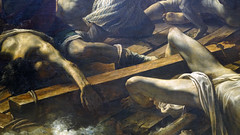

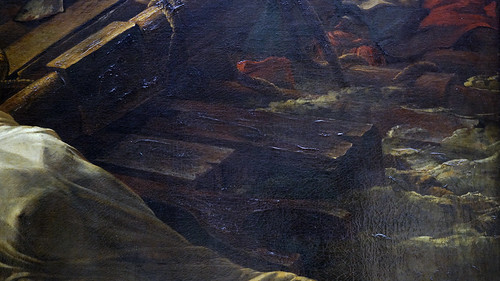
Théodore Géricault, Portraits of the Insane
by BEN POLLITT
After The Raft of the Medusa
At the end of 1821 the leading Romantic painter in France, Théodore Géricault, returned from a year-long stay in England where crowds had flocked to see his masterpiece The Raft of the Medusa displayed in the Egyptian Hall in Pall Mall, London. Despite the success of the exhibition, the French government still refused to buy the painting and his own prodigious spending meant that he was strapped for cash and in no position to embark on another ambitious and expensive large scale project like The Raft. His health too was soon to suffer. On his return to France, a riding accident led to complications, causing a tumor to develop on the spine that proved fatal. He died, aged 32, in January 1824.

Perhaps the greatest achievement of his last years were his portraits of the insane. There were ten of them originally. Only five have survived: A Woman Addicted to Gambling, A Child Snatcher, A Woman Suffering from Obsessive Envy, A Kleptomaniac; and A Man Suffering from Delusions of Military Command.
No information is available for those that have been lost. According to the artist’s first biographer, Charles Clément, Géricault painted them after returning from England for Étienne-Jean Georget (1795-1828), the chief physician of the Salpêtrière, the women’s asylum in Paris. The paintings were certainly in Georget’s possession when he died.
Three theories for the commission
How the two men met is not known for sure. Possibly Georget treated Géricault as a patient, or perhaps they met in the Beaujon Hospital, from whose morgue Géricault had taken home dissected limbs to serve as studies for his figures in The Raft. What is more debated though, is Georget’s role in the production of the paintings. There are three main theories. The first two link the portraits to the psychological toll taken out of Géricault whilst producing his great masterpiece and the nervous breakdown he is believed to have suffered in the autumn following its completion in 1819. The first theory runs that Georget helped him to recover from this episode and that the portraits were produced for and given to the doctor as a gesture of thanks; the second puts forward that Georget, as the artist’s physician, encouraged Géricault to paint them as an early form of art therapy; and the third is that Géricault painted them for Georget after his return from England to assist his studies in mental illness.
It is this last that is generally held to be the most likely. Stylistically, they belong to the period after his stay in England, two years after his breakdown. Also, the unified nature of the series, in terms of their scale, composition and color scheme suggest a clearly defined commission, while the medical concept of “monomania” shapes the whole design.
Early modern psychiatry

A key figure in early modern psychiatry in France was Jean-Etienne-Dominique Esquirol (1772-1840), whose main area of interest was “monomania,” a term no longer in clinical use, which described a particular fixation leading sufferers to exhibit delusional behavior, imagining themselves to be a king, for example. Esquirol, who shared a house with his friend and protégé Georget, was a great believer in the now largely discredited science of physiognomy, holding that physical appearances could be used to diagnose mental disorders. With this in mind, he had over 200 drawings made of his patients, a group of which, executed by Georges-Francoise Gabriel, were exhibited at the Salon of 1814. As an exhibitor himself that year, it seems highly likely that Géricault would have seen them there.
Georget’s work developed on Esquirol’s. An Enlightenment figure, Esquirol rejected moral or theological explanations for mental illness, seeing insanity, neither as the workings of the devil nor as the outcome of moral decrepitude, but as an organic affliction, one that, like any other disease, can be identified by observable physical symptoms. In his book On Madness, published in 1820, following Esquirol, Georget turns to physiognomy to support this theory:
In general the idiot’s face is stupid, without meaning; the face of the manic patient is as agitated as his spirit, often distorted and cramped; the moron’s facial characteristics are dejected and without expression; the facial characteristics of the melancholic are pinched, marked by pain or extreme agitation; the monomaniacal king has a proud, inflated expression; the religious fanatic is mild, he exhorts by casting his eyes at the heavens or fixing them on the earth; the anxious patient pleads, glancing sideways, etc.
The clumsy language here—“the idiot’s face is stupid”—seems a world away from Géricault’s extraordinarily sensitive paintings, a point that begs the question whether Géricault was doing more than simply following the good doctor’s orders in producing the series, but instead making his own independent inquiries.

Géricault had many reasons to be interested in psychiatry, starting with his own family: his grandfather and one of his uncles had died insane. His experiences while painting The Raft must also have left their mark. The Medusa’s surgeon, J.B. Henry Savigny, at the time Géricault interviewed him, was writing an account of the psychological impact the experience had had on his fellow passengers and, of course, there was Géricault’s own mental breakdown in 1819. It seems only natural then that he would be drawn to this new and exciting area of scientific study.
Alternatively, some critics argue that Géricault’s work is a propaganda exercise for Georget, designed to demonstrate the importance of psychiatrists in detecting signs of mental illness. In their very subtleties they show just how difficult this can be, requiring a trained eye such as Georget’s to come to the correct diagnosis. According to Albert Boime, the paintings were also used to demonstrate the curative effects of psychiatric treatment. If the five missing paintings were ever found, he argues, they would depict the same characters—but after treatment—showing their improved state, much like ‘before and after’ photographs in modern day advertising.
This, of course, is impossible to prove or disprove. What is more challenging is Boime’s general criticisms of early psychiatry which, he argues, by classifying, containing and observing people was effective only in silencing the voices of the mentally ill, rendering them invisible and therefore subject to abuse. The fact that the sitters of the paintings are given no names, but are defined only by their illnesses would seem to confirm this view and, for that reason, many modern viewers of the paintings do feel disconcerted when looking at them.
The portraits

The five surviving portraits are bust length and in front view, without hands. The canvases vary in dimensions but the heads are all close to life-size. The viewpoint is at eye level for the three men but from above for the women, indicating that the paintings were executed in different places. It seems likely that the women were painted in the women’s hospital Salpêtrière, while the men were selected from among the inmates of Charenton and Bicȇtre. None of the sitters is named; they are identified by their malady. None look directly at the viewer, contributing to an uneasy sense of distractedness in their gazes that can be read as stillness, as though they are lost in their own thoughts, or as disconnectedness from the process in which they are involved. These are not patrons and have had no say in how they are depicted.
Each is shown in three-quarter profile, some to the left, some to the right. The pose is typical of formal, honorific portraits, effecting a restrained composition that does not make it apparent that they are confined in asylums. There is no evidence of the setting in the backgrounds either, which are cast in shadow, as are most of their bodies, drawing the focus largely on their faces.

The dark coloring creates a sombre atmosphere, evocative of brooding introspection. Their clothing lends them a degree of personal dignity, giving no indication as to the nature of their conditions, the one exception being the man suffering from delusions of military grandeur who wears a medallion on his chest, a tasseled hat and a cloak over one shoulder, which point to his delusions. The medallion has no shine to it and the string that it hangs from looks makeshift and worn.
The paintings were executed with great speed, entirely from life and probably in one sitting. Critics often remark on the painterly quality of the work, the extraordinary fluency of brushwork, in contrast with Géricault’s early more sculptural style, suggesting that the erratic brushwork is used to mirror the disordered thoughts of the patients. In places it is applied in almost translucent layers, while in others it is thicker creating highly expressive contrasts in textures.
Romantic scientists
What perhaps strikes one most about the portraits is the extraordinary empathy we are made to feel for these poor souls, who might not strike us immediately as insane, but who certainly exhibit outward signs of inward suffering.

In bringing the sensitivity of a great artist to assist scientific inquiry, Géricault was not alone among Romantic painters. John Constable’s cloud studies, for example, were exactly contemporary with the portraits and provide an interesting parallel.
Both artists capture brilliantly the fleeting moment, the shifting movements in Constable’s cumulus, stratus, cirrus and nimbus, in Géricault the complex play of emotions on the faces of the insane.
Not since the Renaissance has art illustrated so beautifully the concerns of the scientific domain; in Géricault’s case teaching those early psychiatrists, we might be tempted to think, to look on their patients with a more human gaze.
Additional resources:
The Woman with Gambling Mania at the Louvre
Portrait of a Kleptomaniac at the Museum of Fine Arts, Ghent
“Portraying Monomaniacs to Service the Alienist’s Monomania: Géricault and Georget” by Albert Boime
Man with the ‘Monomania’ of Child Kidnapping, Théodore Géricault in The Guardian
Eugène Delacroix
Eugène Delacroix, an introduction
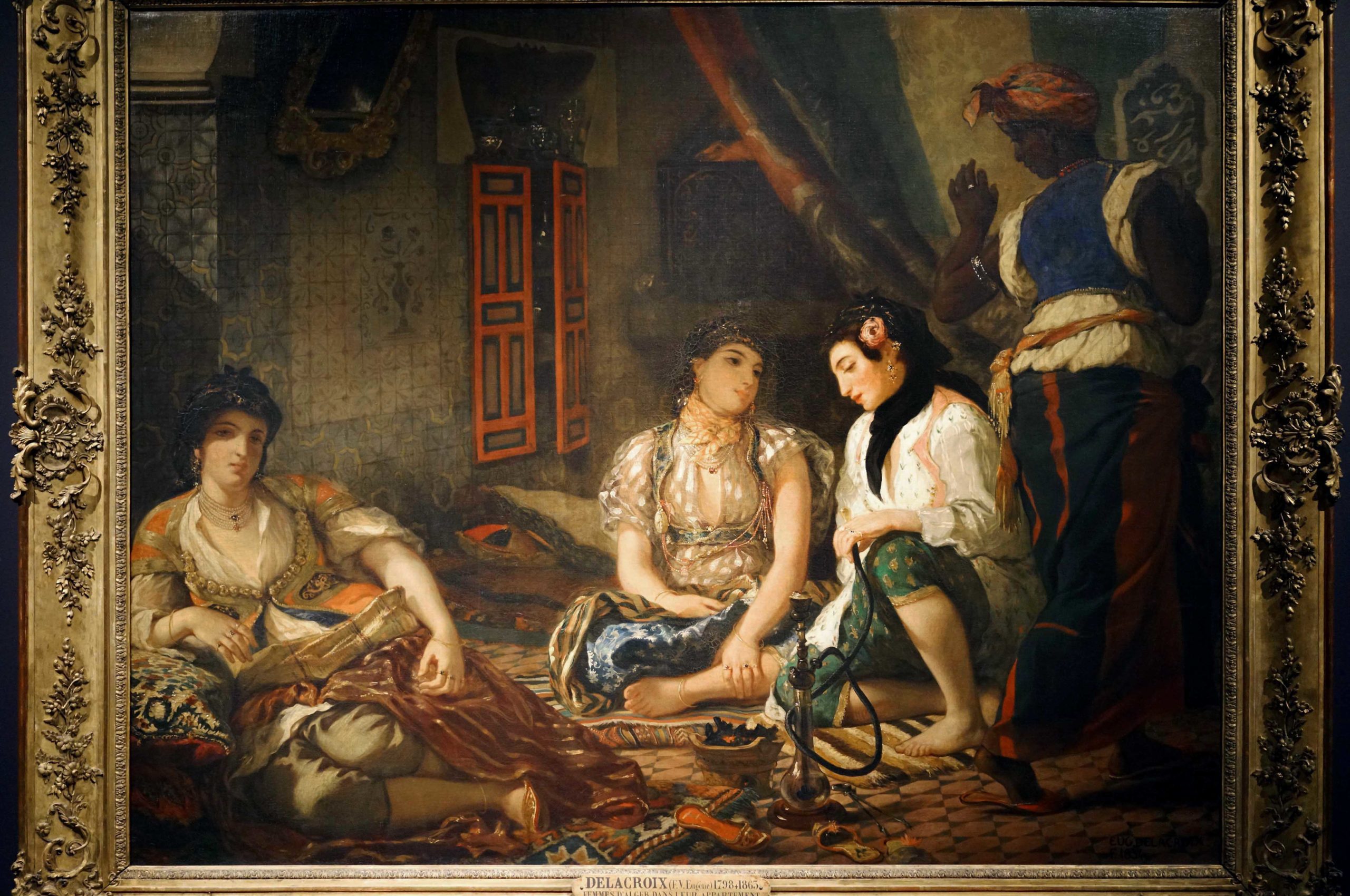
Born in 1798, the French Romantic painter Eugène Delacroix began life as child of privilege and grew up during the age of Napoleon. The funny thing is, he didn’t like being called a Romantic artist. Instead, Delacroix saw himself as a painter who carried on the tradition of French painting at its best, not as someone who wanted to overturn it. “Glory is not a vain word for me,” [1] he once wrote, and Delacroix imagined his name spoken in the same breath with the other “great” French painters such as Charles Lebrun and Jacques-Louis David. For nineteenth-century viewers, Delacroix seemed fearless in his ability to create dramatic images painted with an intensity of color and expression that no one else could match.
A young man in Paris
As a young man, Delacroix was at the heart of creative life in Paris and later became a hero of progressive artists and writers such as Baudelaire, Manet, and Monet, but he retained all of the elegance and ambition of his family’s aristocratic background. His father, Charles, found great success as a landowner and government official before his death in 1803. Delacroix’s brothers and other relatives served as soldiers and ambassadors in the Napoleonic government. Delacroix’s mother Victoire died in 1814, when Eugène was just sixteen. Although his father had left a fortune to his family, it had been poorly managed, and by 1822 there was nothing left. Delacroix would have to make his way in the world with just his talent and a few family connections.
Delacroix’s art owed much to his education and the company he kept as a young man in Paris. He attended the Lycée Louis-le-Grand, a prestigious school that is still associated with the French elite. There, and later in the company of his friends, he came to love Greek drama, Shakespeare, and modern literature. When he was seventeen, Delacroix entered the studio of the conservative painter Pierre-Narcisse Guérin and, as importantly, he began to study in the Louvre, copying the paintings of Veronese, Titian, and Rubens with other young painters.
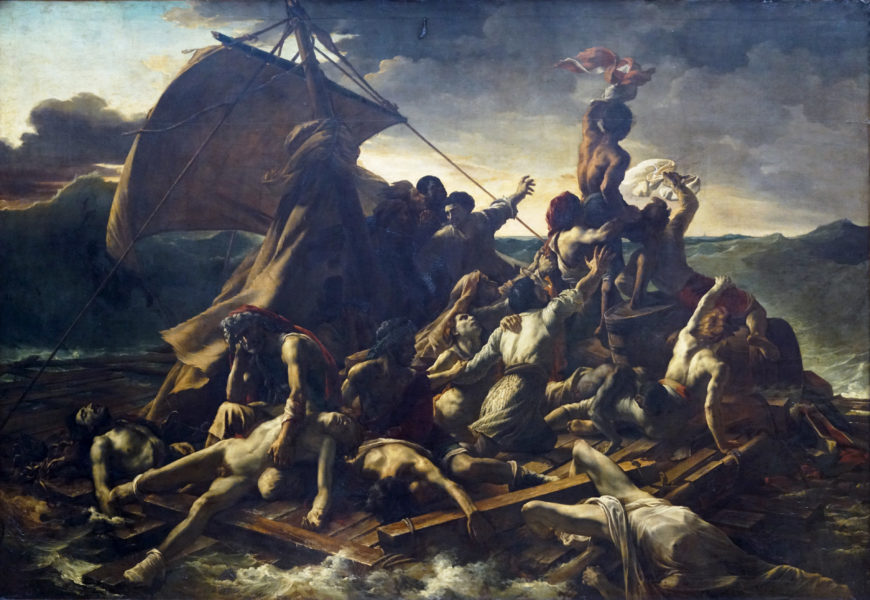
In Guérin’s studio, Delacroix met the painter Théodore Géricault, who would have an important influence on Delacroix’s first major canvas (The Barque of Dante). Géricault’s dramatic brushwork and daring compositions made a deep impression on young Delacroix. In 1818, Géricault began to work independently on The Raft of the Medusa, in a studio rented specifically for that purpose. There Delacroix watched Géricault work quickly and expressively on the massive canvas. We know that Delacroix served as a model for one of the figures in the foreground, and he vividly recalled feeling completely overwhelmed with admiration and emotion when he saw the near-finished painting.
A dramatic debut
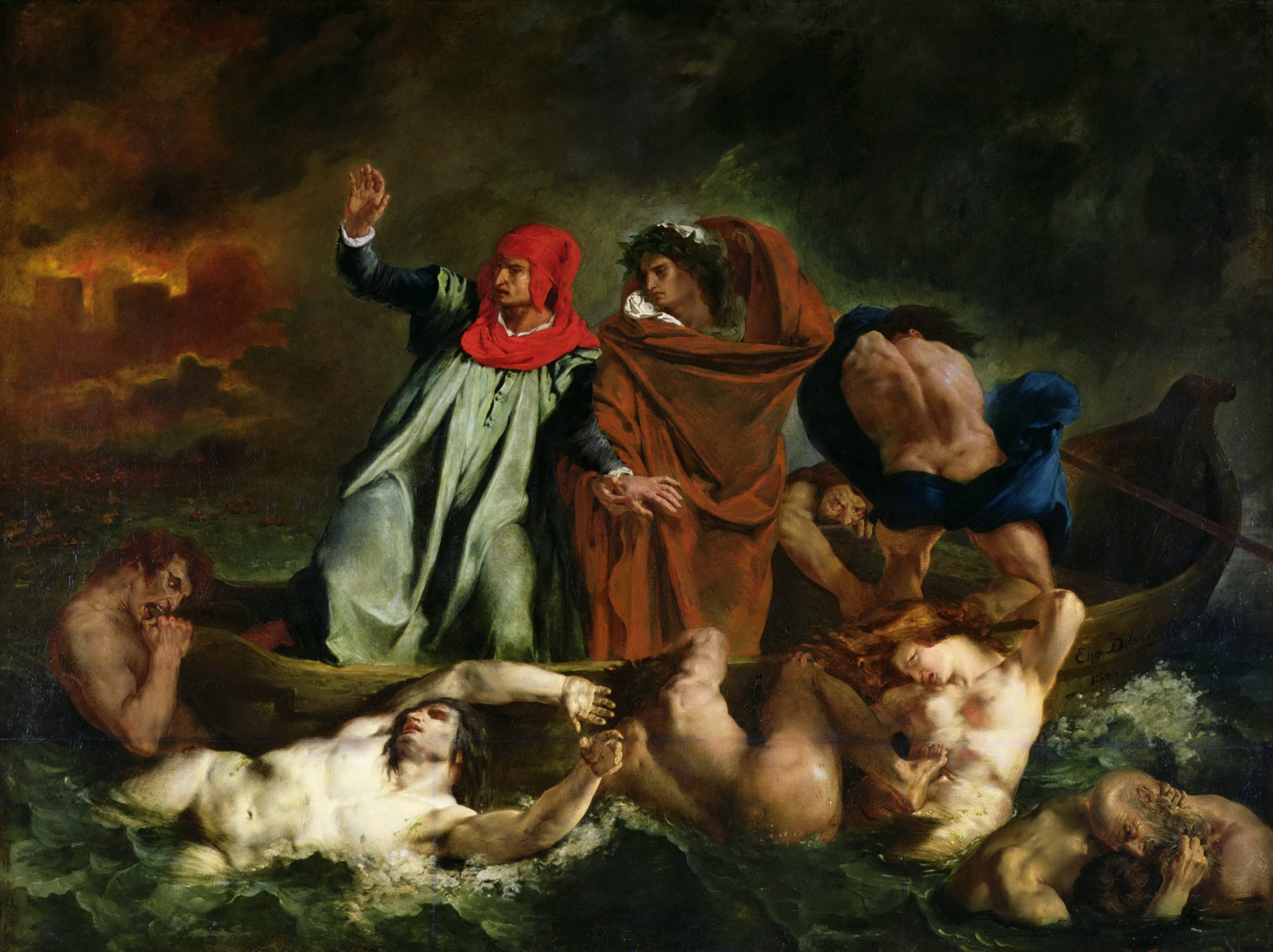
Delacroix’s first painting presented in the annual Paris Salon exhibition, The Barque of Dante (1822), reflected Géricault’s dramatic approach and all of Delacroix’s studies in the Louvre. Drawn from the Italian Renaissance poet Dante’s Divine Comedy, the painting depicts Dante guided into Hell by the Roman poet Virgil as stormy seas and demonic figures attack their boat. The figures and drama, recalling Michelangelo and Rubens, marked the artist as part of the new modern style that would soon be called Romantic.
The big three
After his debut painting, Delacroix followed up with three of his best-known works, all drawn from contemporary events and literature. These paintings marked Delacroix as the leader of the modern, Romantic movement. In the public imagination, the term Romantic pitted Delacroix against the more conservative painter Jean-Auguste-Dominique Ingres, who embodied a conservative, classic approach to painting based on the primacy of line, while Delacroix represented a more expressive, modern painterly style focused on color. While Delacroix never liked being labeled a Romantic, he valued all the recognition that came from presenting sensational Salon paintings.
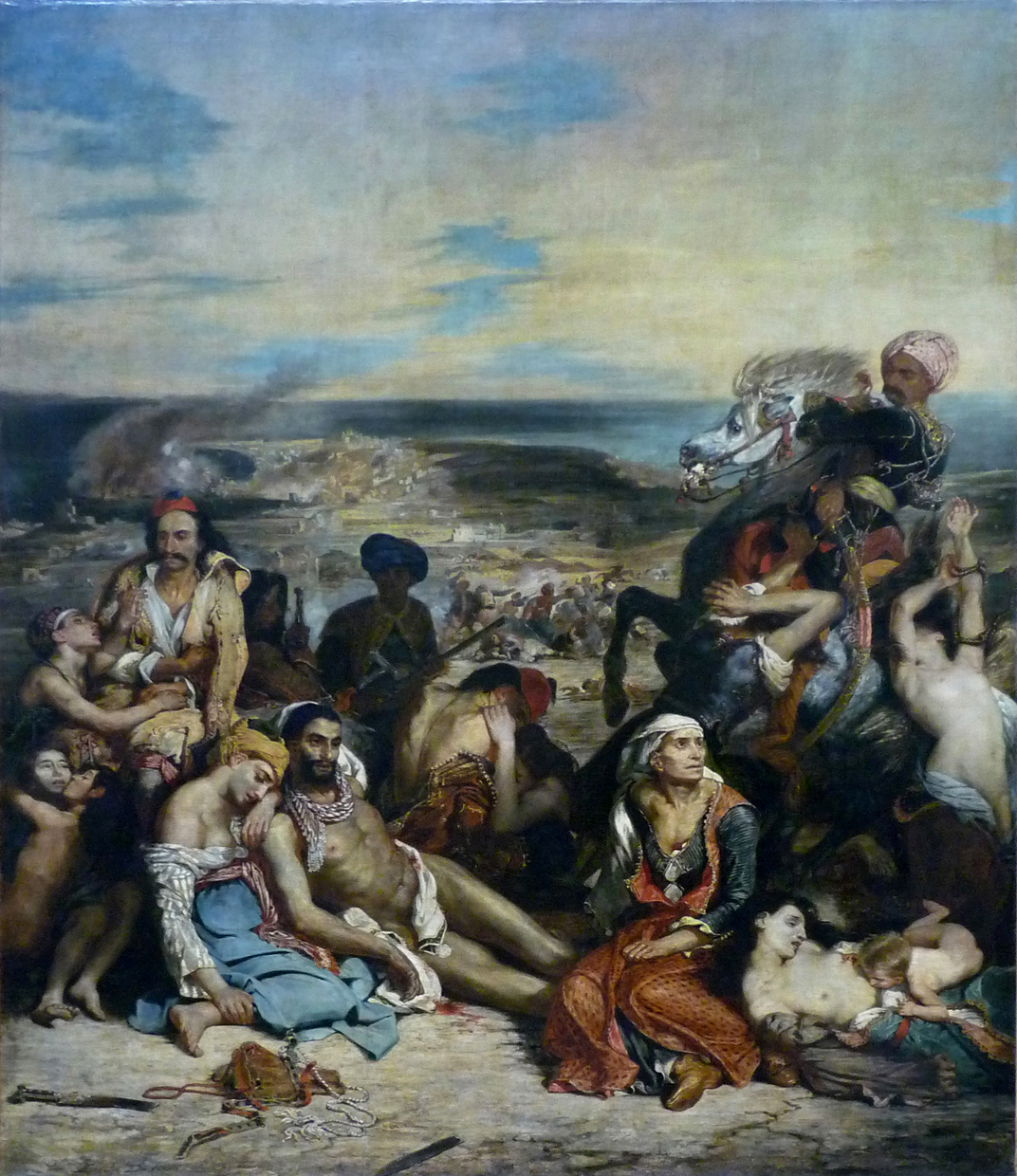
Massacre at Chios depicts the Greeks of the island of Chios after a defeat by the Ottoman Turks during the Greek Wars of Independence. The French saw themselves reflected in the Greek struggle for freedom, and the Turkish cavalryman on the right added drama and foreign glamour. There was always a crowd in front of the painting at the Salon exhibition. Delacroix offered the viewers a bit of tradition and, also, painterly innovation. The frieze-like composition of figures across the canvas recalled the Neoclassical paintings of Jacques-Louis David, and conservative critics liked the reclining, bearded male figure. Those with a taste for a more progressive, Romantic style responded to the fluidity of the painting and intense color contrasts that seemed drawn from Rubens and expressed the passionate nature of the artist.
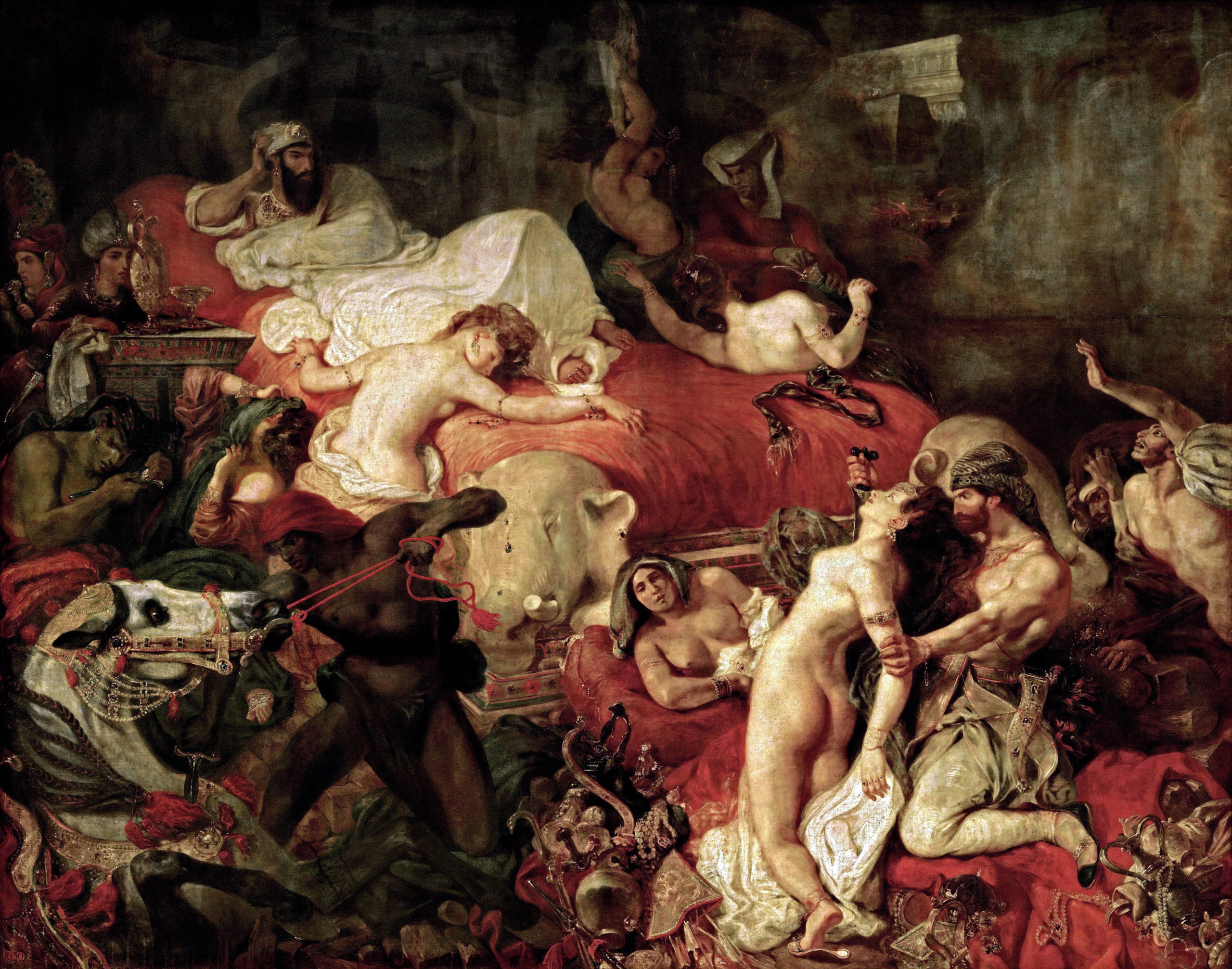
Next came the epic Death of Sardanapalus (1827), a massive canvas depicting the last Assyrian king watching his concubines and horses being slaughtered as he burns his palace down around him. The subject is taken from a play by the Romantic English poet Byron, and the painting is a swirling, violent scene dominated by a red that permeates the canvas. Audiences were shocked and dazzled. The painting reflected contemporaneous French ideas of the people of the East as hedonistic, violent and fatalistic. This worldview, associated with the term Orientalism in art history, was part of an overall colonialist attitude that defined Western Europe as a model of reason and moderation in contrast to the excesses associated with the so-called Orient. As such, the audience could revel in the violence, eroticism and glamour because it depicted a world defined as completely different and removed from modern Paris. But, for most viewers, Delacroix had gone too far. The painting broke too many rules. Even his supporters discerned no underlying structure to the painting’s composition and saw only an indulgent use of color.
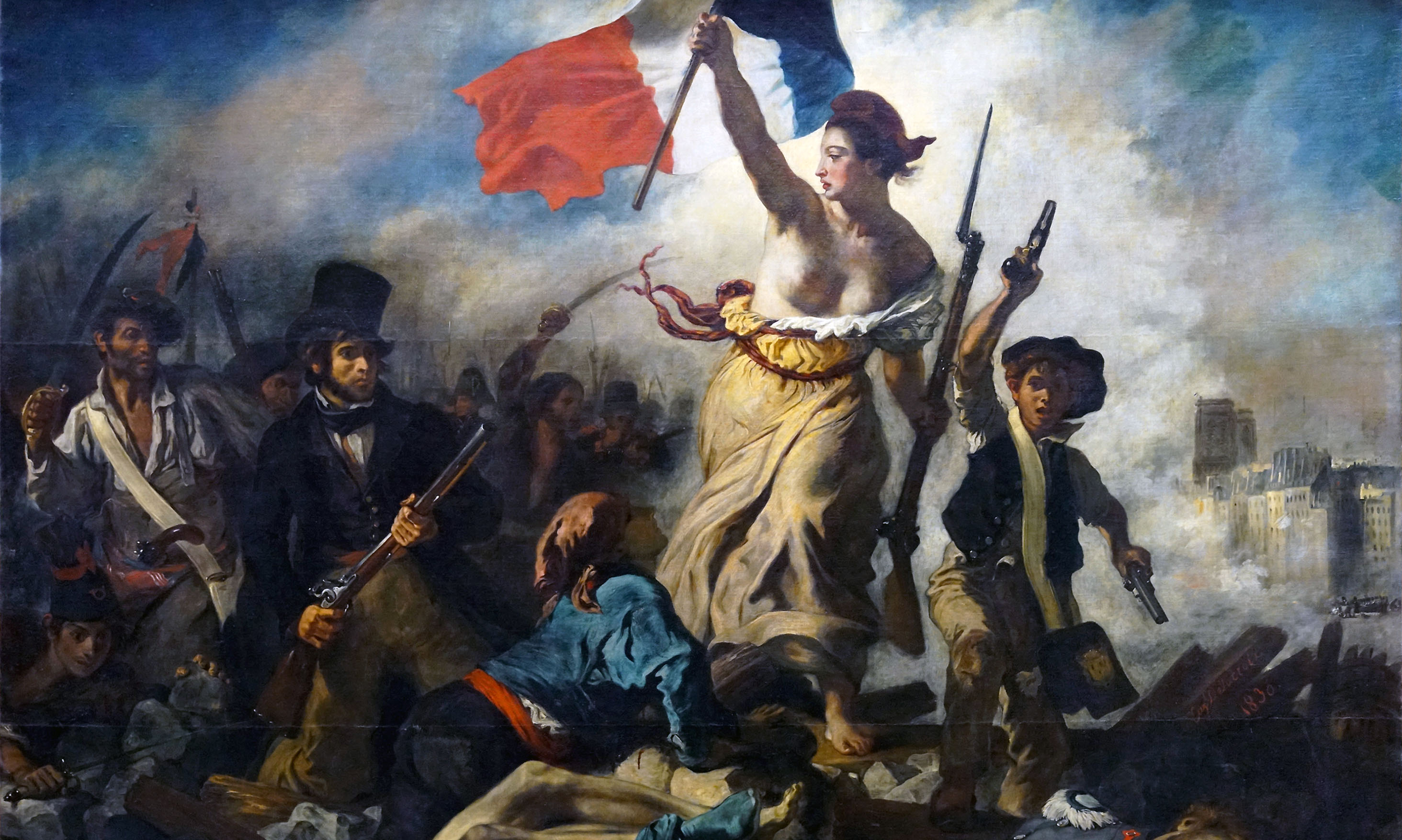
One of the most famous paintings in France completes the trio: Liberty Leading the People (1830). It commemorates the Revolution of 1830 that deposed Charles X (brother of Louis XVI) and brought an end to the Bourbon Restoration that had followed Napoleon. The events of 1830, unlike the conflict in Greece or the violent fantasy of Sardanapalus, unfolded on Delacroix’s doorstep. Rather than taking part in the conflict, he stayed off the streets and out of danger. Only after order was restored did he take a stand. He wrote, “I have undertaken a modern subject, a barricade, and although I may not have fought for my country, at least I shall have painted for her.”[2] While many saw a call to revolution in Liberty Leading the People, Delacroix saw a classic history painting with an allegorical figure, bare-breasted Liberty, carrying the tricolor flag of the French republic over the barricade.
For the official world of French painting, Liberty Leading the People posed a problem. In a country so rocked by revolutions and violence in the previous decades, was it prudent to have a painting celebrating rebellion on public view? This question dogged the French state for decades. After its first exhibition in the Paris Salon, Delacroix was awarded the cross of the Legion of Honor, and the painting was purchased by the state and put on view in Paris’ gallery of contemporary art in the Luxembourg Palace. But by 1832 the monarchy removed the painting, and it was not exhibited again until 1848. It was removed again in 1850 and not put on permanent display until 1862. Today, it is an iconic image of the ideals of the French republic.
In the years after Liberty Leading the People, Delacroix shifted his focus from large-scale canvases for the Salon to new subjects. Through his association with members of the government, he was invited to North Africa as part of a diplomatic mission and produced work from that voyage. Later he received commissions to create wall and ceiling paintings for important government buildings and churches in Paris. This was not his only work, but these projects shaped his professional life. During these years, his friends were well-known bohemian artists, writers and composers, such as the novelist George Sand and her lover, the composer Frédéric Chopin. With the Romantic sculptor Antoine Barye, he visited the Paris zoo to draw and paint the exotic tigers and other animals. He also worked as a printmaker, producing etchings and lithographs that included images of animals, depictions of North Africa and illustrations from literature.
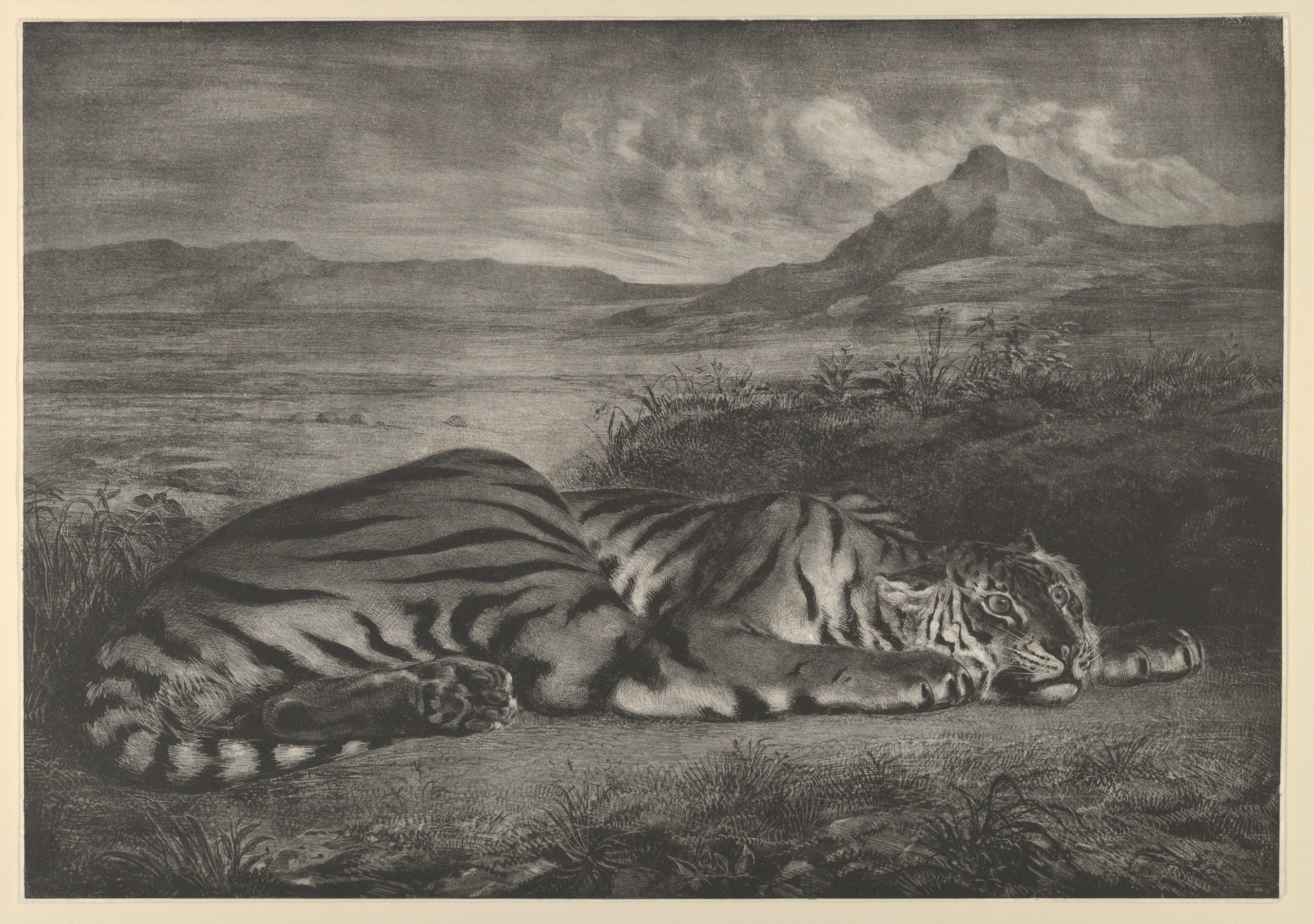
A voyage to Morocco
In January 1832, Delacroix, who had not traveled outside of France before, took part in a diplomatic mission to Morocco. Before the trip, he had only known the world of North Africa and the Middle East from literature and images. After his arrival in Tangier, he wrote a friend, “I have just walked through the city. I am dizzy with what I have seen.”[3] One of the earliest French painters to depict the people and cultures of North Africa, Delacroix filled his notebooks with ink sketches and watercolors.

When he returned to Paris, Delacroix began to exhibit work drawn from his voyage, beginning with A Street in Meknes (1832). Most significant was The Women of Algiers (1834) exhibited to great acclaim in the Paris Salon. According to contemporary writer Philippe Burty, Delacroix had received special permission to enter an Algerian harem — part of a home off-limits to men — and sketched two women he encountered there. He used the visit and his sketches as the basis for the two principal figures in The Women of Algiers. While this account is in doubt today (after all, he created the painting in Paris using models in the studio), the Salon audience was entranced, embracing the quiet intimacy of the scene, its exotic aura, and beautiful intense colors. Delacroix returned to the subject fifteen years later with The Women of Algiers in Their Apartment (1847-1849) and other artists, such as Pablo Picasso, closely studied and rendered their own versions of the painting.

Paintings for all of Paris
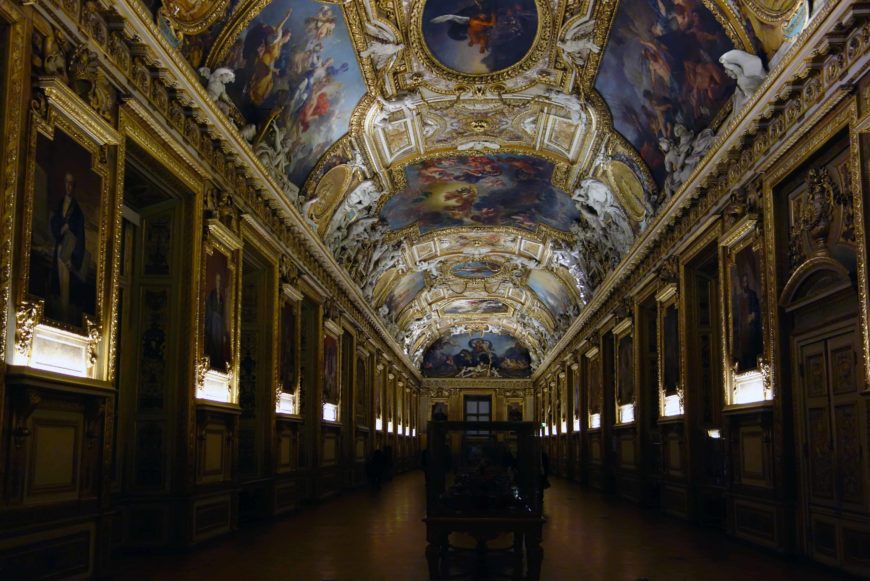
Delacroix also found success creating decorations for important public buildings and churches in Paris. In 1833, he began work on government commissions with paintings for important rooms in the Assemblée Nationale, and followed up with decorations for the library of the Senate (1840–1851). Between 1851 and 1854, he also painted the Salon de la Paix in the Paris City Hall, although his work was unfortunately lost in the fire of 1871. Visitors to the Louvre can see some of Delacroix’s decorative paintings in the Galerie d’Apollon, including Apollo Slays Python, from Ovid’s Metamorphoses. Before beginning the painting, Delacroix had visited Belgium and his journals record admiration for the freedom, drama, and sublime nature of Rubens’ work that found its way into the swirling colors, dramatic composition, and ethereal light of Apollo Slays Python.
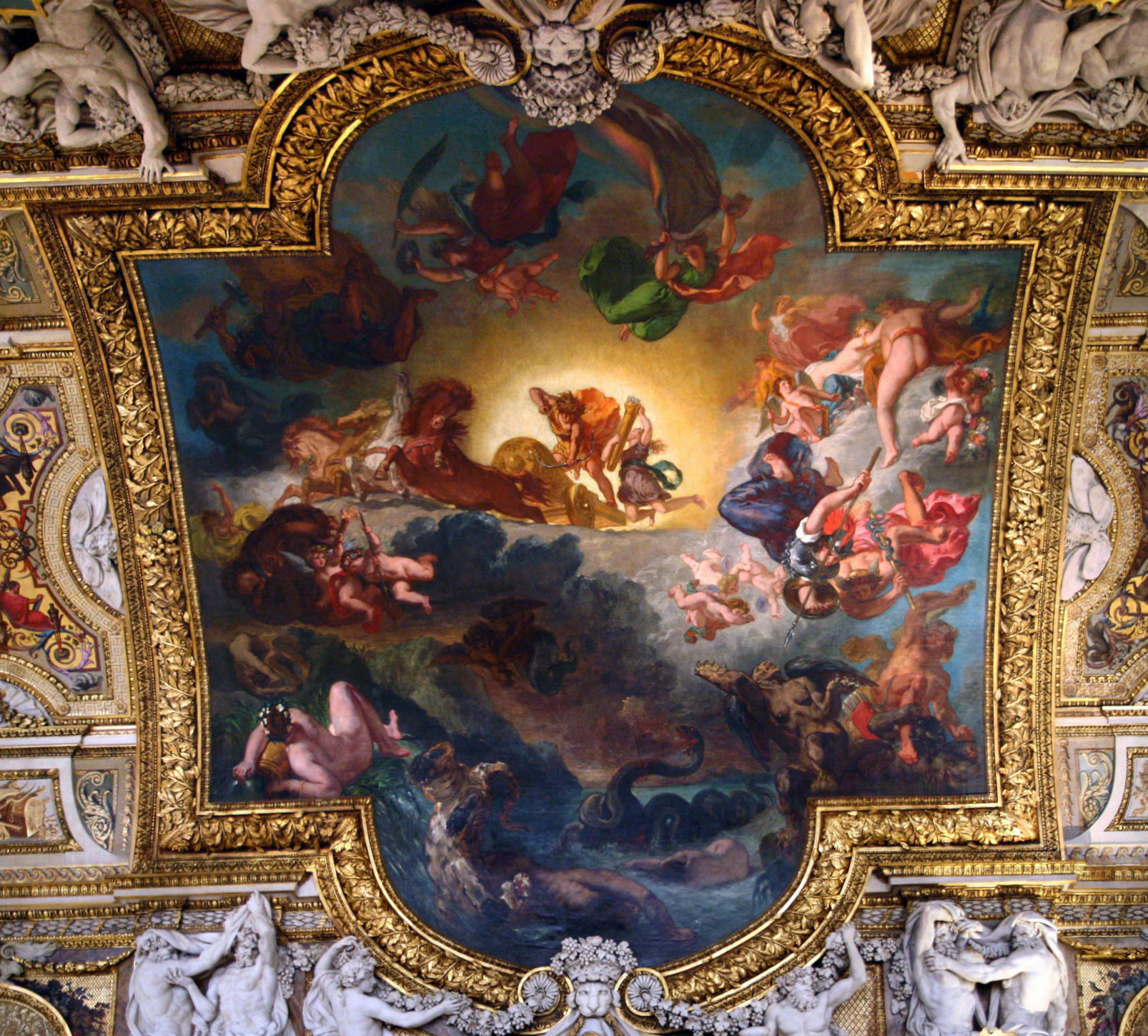
The monumental paintings created after 1830, during the July Monarchy, were followed by a commission to decorate the Chapelle des Anges in the Church of St. Sulpice. He received the commission in 1849, but other work delayed the start on the paintings until 1854. In the Chapelle he depicted three stories that revolved around the biblical Archangel Michael and stories from the Old Testament. This would be his last major project.
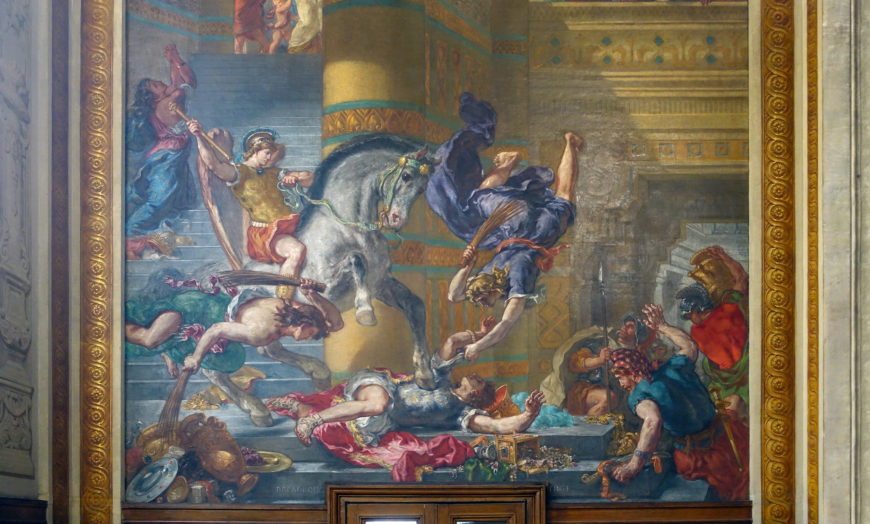
The end of an era
As he completed major Salon paintings and public commissions, Delacroix also continued to create smaller easel paintings. Throughout his career he drew, printed, and painted dramatic subjects drawn from history and literature, tales from mythology and Christian subjects that reflected compassion and empathy, as well as animal and still-life images. At his funeral in 1863, people said that his death marked the end of an era in French art and the definitive passing of the “Generation of 1830.” Yet even as Delacroix passed into history, a new generation of rebellious painters led by Édouard Manet had begun to follow in his footsteps by creating art that engaged with the past while pushing toward an entirely new approach to painting.
Notes:
- Eugène Delacroix, Journal, April 29, 1824.
- Barthélémy Jobert, Delacroix (Princeton: Princeton UP, 1997), 130.
- Ibid., 83.
Eugène Delacroix, Scene of the Massacre at Chios
by DR. BETH HARRIS and DR. STEVEN ZUCKER
Video \(\PageIndex{4}\): Eugène Delacroix, Scene of the Massacre at Chios; Greek Families Awaiting Death or Slavery, 1824, oil on canvas, 164″ × 139″ / 419 cm × 354 cm (Musée du Louvre, Paris)
Smarthistory images for teaching and learning:
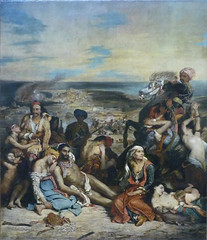
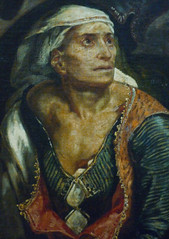
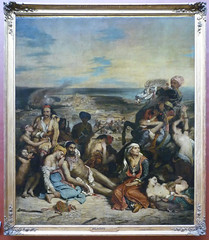

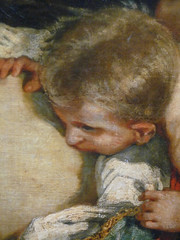
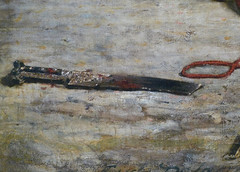
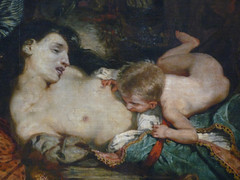
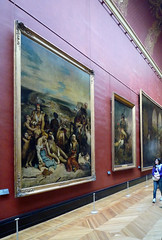


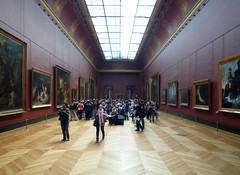
Eugène Delacroix, The Death of Sardanapalus
by DR. BETH HARRIS and DR. STEVEN ZUCKER
Video \(\PageIndex{5}\): Eugène Delacroix, The Death of Sardanapalus, 1827, oil on canvas, 12′ 10″ x 16′ 3″ / 3.92 x 4.96 m (Musée du Louvre, Paris)
Smarthistory images for teaching and learning:
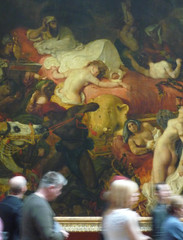





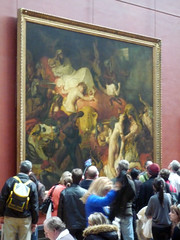




Eugène Delacroix, Liberty Leading the People
by DR. BRYAN ZYGMONT
Video \(\PageIndex{6}\): Eugène Delacroix, Liberty Leading the People (July 28, 1830), September – December 1830, oil on canvas, 260 x 325 cm (Musée du Louvre, Paris)
Poussinists vs. Rubenists
If Jacques-Louis David is the most perfect example of French Neoclassicism, and his most accomplished pupil Jean-Auguste-Dominique Ingres, represents a transitional figure between Neoclassicism and Romanticism, then Eugène Delacroix stands (with, perhaps, Theodore Gericault) as the most representative painter of French romanticism.

French artists in early nineteenth century could be broadly placed into one of two different camps. The Neoclassically trained Ingres led the first group, a collection of artists called the Poussinists (named after the French baroque painter Nicolas Poussin). These artists relied on drawing and line for their compositions. The second group, the Rubenists (named in honor of the Flemish master Peter Paul Rubens), instead elevated color over line. By the time Delacroix was in his mid-20s—that is, by 1823—he was one of the leaders of the ascending French romantic movement.
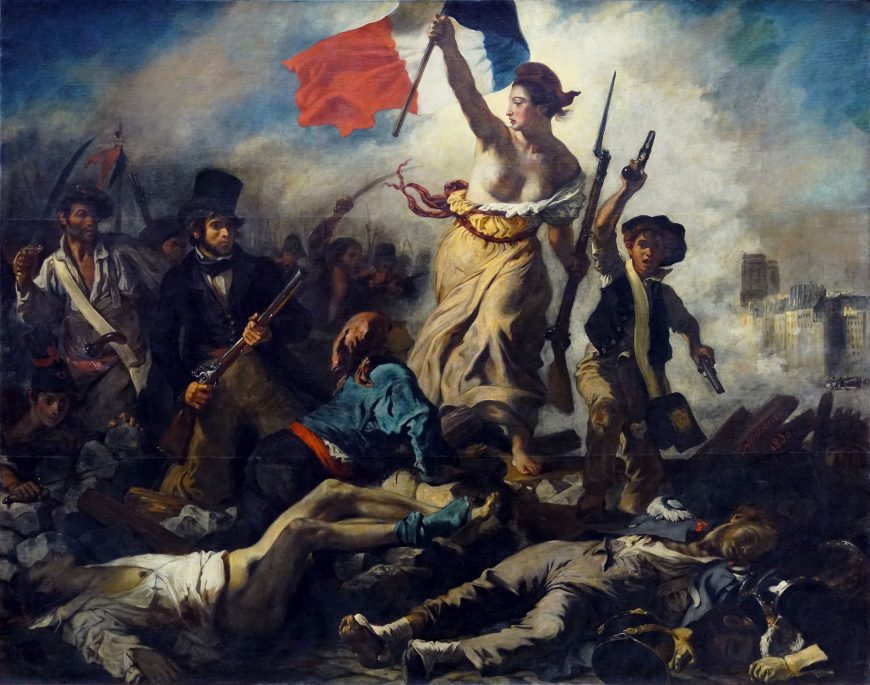
From an early age, Delacroix had received an exceptional education. He attended the Lycée Imperial in Paris, an institution noted for instruction in the Classics. While a student there, Delacroix was recognized for excellence in both drawing and Classics. In 1815—at the age of only 17—he began his formal art education in the studio of Pierre Guérin, a former winner of the prestigious Prix de Rome (Rome Prize) whose Parisian studio was considered a particular hotbed for romantic aesthetics. In fact, Theodore Gericault, who would soon become a romantic superstar with his Raft of the Medusa (1818-19), was still in Guérin’s studio when Delacroix arrived in 1815. The young artist’s innate skill and his teacher’s able instruction were an excellent match and prepared Delacroix for his formal admission to the Ecole des Beaux-Arts (the School of Fine Arts) in 1816.
Massacre at Chios: Ripped from the headlines

Less than a decade later, Delacroix’s career was clearly on the rise. In 1824, for example, Delacroix exhibited his monumental Massacres at Chios at the annual French Salon. This painting serves as an excellent example of what what Delacroix hoped romanticism could become. Rather than look to the examples of the classical past for a narrative, Delacroix instead looked to contemporary world events for his subject. This “ripped from the headlines” approach was common for many romantic painters.


Comparing David’s Oath of the Horatii (above, left) with Francisco Goya’s The Third of May, 1808 (above, right) is instructive. Whereas David mined a story from more than 2,500 years ago, Goya instead completed a history painting from the recent past. This chronological immediacy only increased the pathos of Goya’s painting.
Delacroix has upped Goya’s ante in Scene of the massacre at Chios, however, by not only depicting Greek families awaiting death or slavery, but, by also chronicling a catastrophic event from the Greek War of Independence (from the Ottoman Empire) from a far-off location (the small island of Chios is located just off the coast of Turkey). About the Greek War of Independence
When the monumental canvas the Massacre at Chios is viewed from a short distance, it is clear that the artist placed more effort on his use of color, and employed a fluid open brushwork rather than relying on line and a carefully polished painting surface (as the Poussinists were doing). In sum, Massacres at Chios is an eloquent painting to explore when it comes to Delacroix’s commitment to romanticism. The subject was topical and exotic, and the artist used color and brushwork to elicit an emotional response from the viewer.
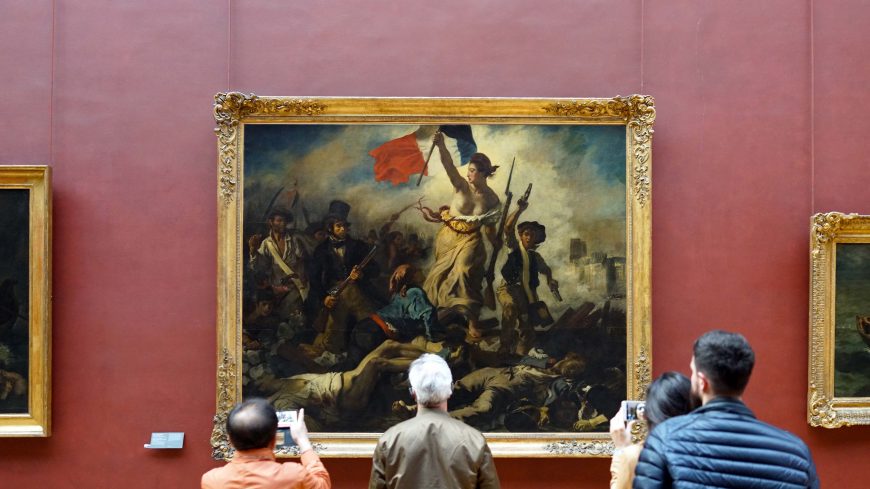
Liberty Leading the People
Many of these same concepts can be seen in what many regard as Delacroix’s masterpiece, Liberty Leading the People (1830). Although Delacroix completed this painting during same year in which the event occurred, it is, at its core, a history painting. Indeed, Delacroix depicts an event from the July Revolution of 1830, an event that replaced the abdicated King Charles X (r. 1824-30)—a member of the Bourbon family and the younger brother of the guillotined King Louis XVI (r. 1774-1792)—with Louis Philippe I (r. 1830-48), the so-called Citizen King. This uprising of 1830 was the historical prelude to the June Rebellion of 1832, an event featured in Victor Hugo’s famous novel, Les Misérables (1862), and the musical (1980) and films that followed. Anyone familiar with Claude-Michel Schönberg and Alain Boublil’s musical can look at Delacroix’s Liberty Leading the People and hear the lyrics of the song that serves as a call to revolution:
Do you hear the people sing? Singing a song of angry men? It is the music of a people. Who will not be slaves again.
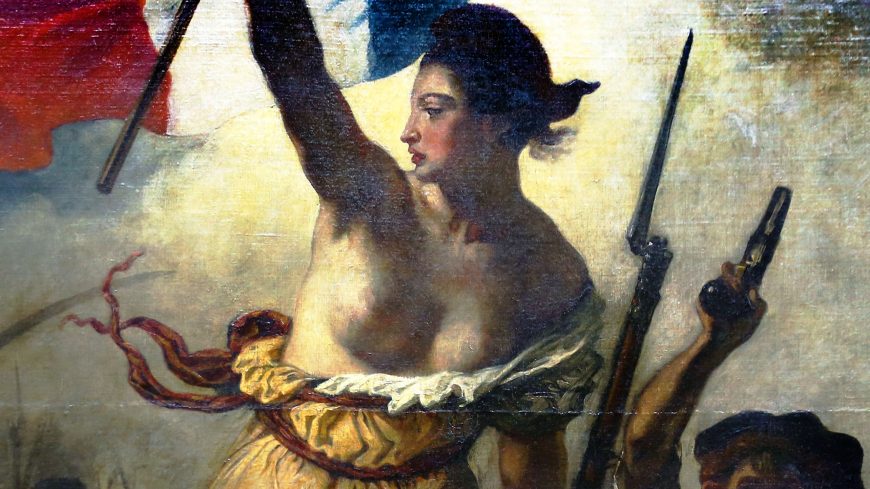
Liberty
Delacroix’s painting, Liberty Leading the People, at first seems to be overpowered by chaos, but on closer inspection, it is a composition filled with subtle order. The first thing a viewer may notice is the monumental—and nude to the waist—female figure. Her yellow dress has fallen from her shoulders, as she holds a bayonetted musket in her left hand and raises the tricolor—the French national flag—with her right. This red, white, and blue arrangement of the flag is mimicked by the attire worn by the man looking up at her. She powerfully strides forward and looks back over her right shoulder as if to ensure those who she leads are following. Her head is shown in profile—like a ruler on a classical coin—and she wears atop her head a Phrygian cap, a classical signifier of freedom. This is an important bit of costuming—in ancient Rome, freed slaves were given one to wear to indicate their newly liberated status, and this headwear became a symbol of freedom and liberty on both sides of the Atlantic Ocean during the eighteenth and nineteenth centuries.
Clearly, this figure is not meant to be a portrait of a specific individual, and Delacroix did not mean to suggest that there was a half-naked woman running around carrying a loaded firearm and a flag during the Trois Glorieuses—the Three Glorious Days as it came to be known—of the July Revolution. Instead, she serves as an allegory—in this instance, a pictorial device intended to reveal a moral or political idea—of Liberty. In this, she is similar to an example familiar to those in the United States, Frédéric Auguste Bartholdi’s Statue of Liberty (1886). Clearly, this monumental statue is not a portrait of a woman named Liberty who wears a Roman toga, carries a torch, and an inscribed tablet. Instead, she represents an idea. The same is true of Delacroix’s painted Liberty.
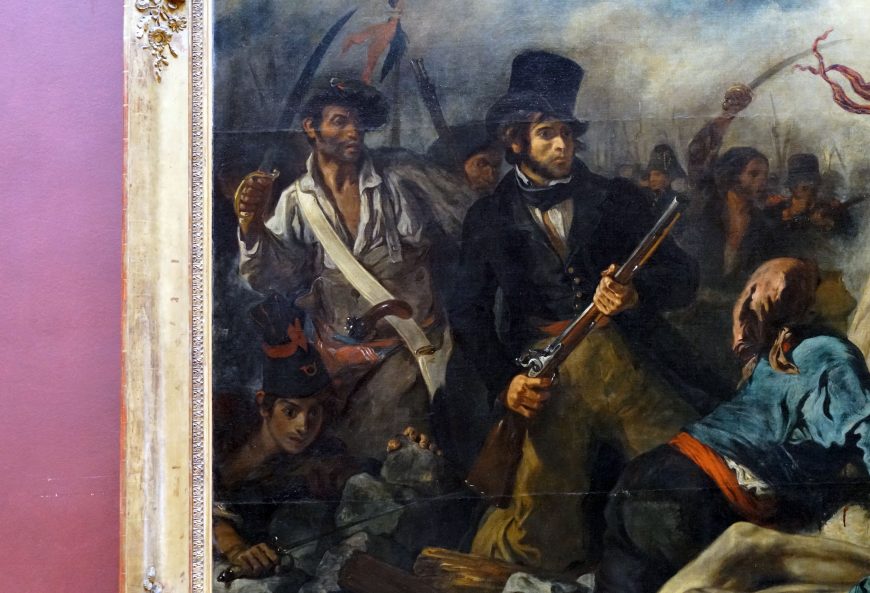
A revolution for everyone
But if the female figure represents an allegory, those who surround her represent different types of people. The man on the far left holds a briquet (an infantry saber commonly used during the Napoleonic Wars). His clothing—apron, working shirt, and sailor’s trousers—identify him as a factory worker, a person in the lower end of the economic ladder. His other attire identifies his revolutionary leanings. The handkerchief around his waist, that secures a pistol, has a pattern similar to that of the Cholet handkerchief, a symbol used by François Athannase de Charette de la Contrie, a Royalist solider who led an ill-fated uprising against the First Republic, the government established as a result of the French Revolution. The white cockade and red ribbon secured to his beret also identify his revolutionary sensibilities.
This factory worker provides a counterpoint to the younger man beside him who is clearly of a different economic status. He wears a black top hat, an open-collared white shirt and cravat, and an elegantly tailored black coat. Rather than hold a military weapon like his older brother-in-arms, he instead grasps a hunting shotgun. These two figures make clear that this revolution is not just for the economically downtrodden, but for those of affluence, too.

This revolution is not only for the adults—two young boys can be identified among the insurgents. On the left, a fallen adolescent who wears a light infantry bicorne and holds a short saber, struggles to regain his footing amongst the piled cobblestones that make up a barricade. The more famous of the pair, however, is on the right side of the painting (image, right). Often thought to be the visual inspiration for Hugo’s character of Gavroche in Les Misérables, this boy wildly wields two pistols. He wears a faluche—a black velvet beret common to students—and carries what appears to be a school or cartridge satchel (with a crest that may be embroidered) across his body.
A modern subject

With no less than five guns and three blades among these six primary figures, it is not surprising that the ground is littered with the dead. Some are members of the military, note the uniform decorated with shoulder epaulettes on the figure in the lower right, while others are likely revolutionaries. In total, the painting accurately renders the fervor and chaos of urban conflict. And it is, of course, an urban conflict. Notre Dame, perhaps the defining architectural monument of Paris (at least until the Eiffel Tower arrived at the end of the nineteenth century) can be clearly seen on the right side of the painting. Importantly, Delacroix signed and dated his painting immediately underneath this monument.
Although not everyone can pick up a weapon and stand a post in a war, Delacroix would have us believe that everyone can be a revolutionary. When corresponding with his brother on 28 October 1830—less than three months after the July Revolution, Delacroix wrote, “I have undertaken a modern subject, a barricade, and although I may not have fought for my country, at least I shall have painted for her. It has restored my good spirits.” In doing so, Delacroix completed what has become both a defining image of French romanticism and one of the most enduring modern images of revolution. It has even been appropriated—although slightly altered—by the British rock band Coldplay as an album cover for their 2006 release Viva la Vida or Death and All His Friends.
Additional resources:
Yvonne Korshak, “The Liberty Cap as a Revolutionary Symbol in America and France,” Smithsonian Studies in American Art (Autumn 1987), pp. 52-69 (available online)
Smarthistory images for teaching and learning:
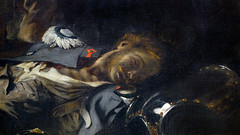
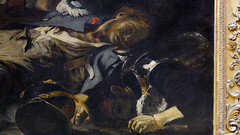
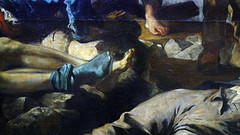



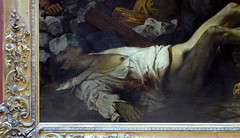
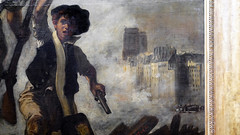
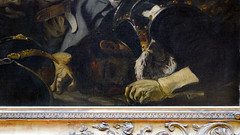
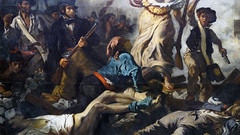

Eugène Delacroix, Murals in the Chapel of The Holy Angels, Saint-Sulpice
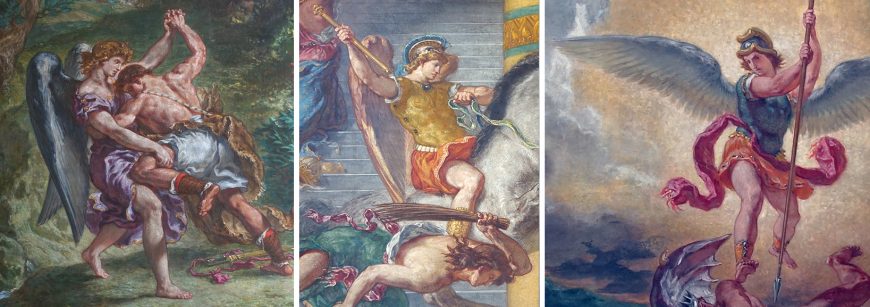
Three angels in a mural program
Possibly the most important and best-known mural paintings in all of Paris are the three works by the Romantic artist Eugène Delacroix, completed in 1861. This mural program was to decorate the Chapel of the Holy Angels in the magnificent late baroque-style church of Saint-Sulpice. In this rather narrow space, Delacroix portrayed biblical subjects in two enormous wall paintings, each more than 23 feet high, and one nearly as large on the ceiling at more than 16 feet across.
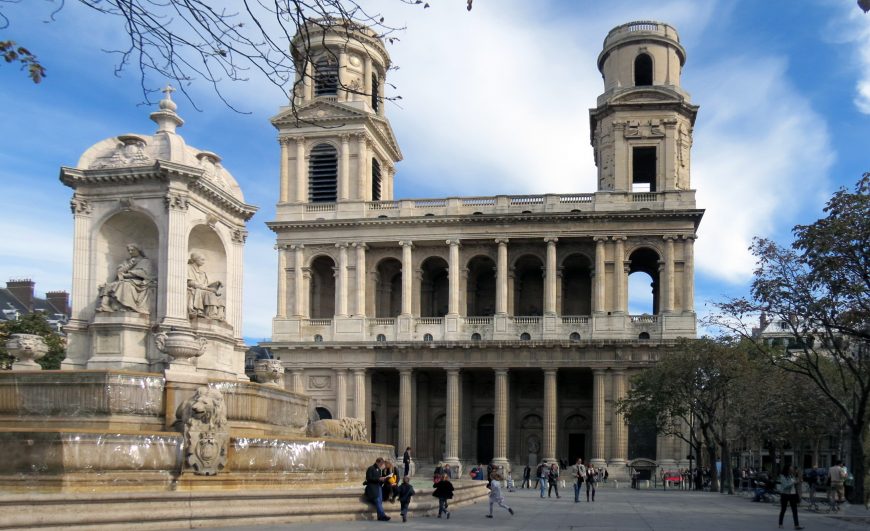
Technique and technology
The murals were created not only with paint but with a mixture of pigments, linseed oil, and a small amount of wax. This combination was mixed together on the artist’s palette as he colored the surface. Careful preparation included many pencil and oil sketches, tests of complementary color relationships as well as technical preparations of the wall surface. Before he began, Delacroix had his assistants soak the walls with boiling oil because he feared the humidity might damage the works over time.
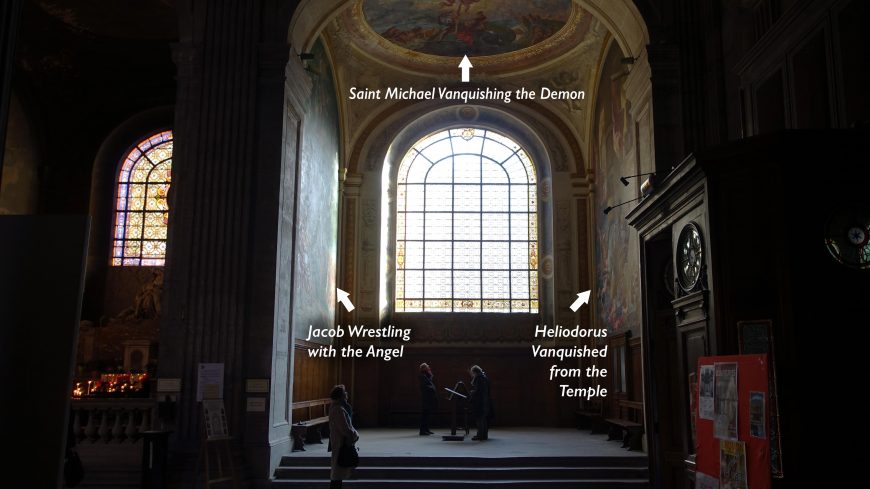
Cleaned and conserved in 2015, the colors are vibrant as the oil gives a brilliant sheen to the wall surface, looking as if the colors were newly applied and the paint still wet. Far more details can be readily seen: for example, the bejeweled earrings worn by the embattled figure of Heliodorus (below). For the ceiling preparation, Delacroix’s assistants fastened canvas with an adhesive of white lead paint ground in oil (known as maroulflage).
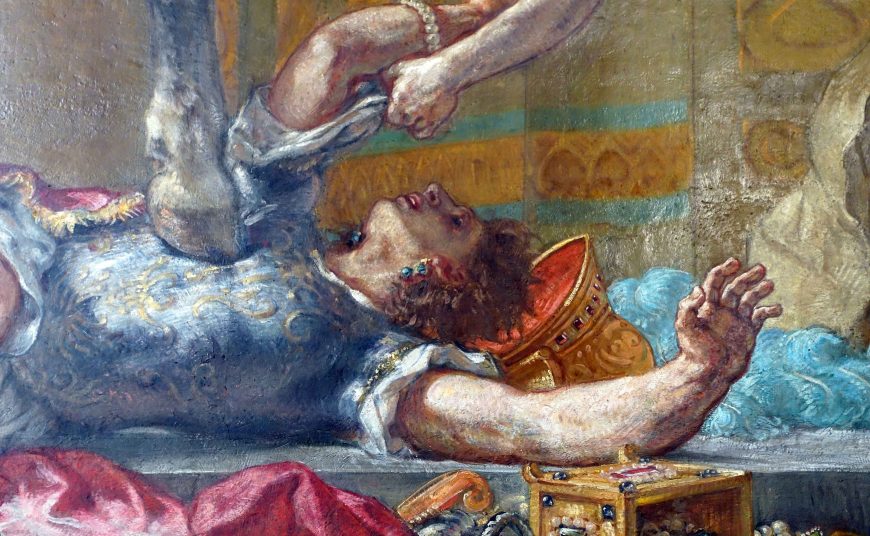
Unusual angel subjects
The excitement of these paintings is due in part to the artist’s decision to paint two subjects from the Jewish Bible (Old Testament), Jacob Wrestling with the Angel and Heliodorus Vanquished from the Temple, and one subject found in the New Testament’s Book of Revelation, Saint Michael Vanquishing the Demon (though, as explained below, Michael appears in both the Old and New Testaments). These visionary scenes of angels are far from traditional or familiar images of angels such as those in paintings of the Annunciation.
The unexpected trio of subjects—full of robust action and even violence—bewildered critics for a century or more, with two scenes with good battling evil (Saint Michael and Heliodorus), and one in which good (Jacob) is wrestling with greater Good (an angel — “one like God.”) However, if we examine scriptural sources in conjunction with the theology of divine intervention, the three subjects easily become unified and express a cohesive history: one that follows a chronological sequence of the Jewish people from the patriarchal period (from Abraham onward) to Christian salvific history at the end of time.
Delacroix has often been characterized as a religious sceptic or an unbeliever. Yet many of his most important religious works were not commissions, but were motivated by his own inspiration. His now famous Journal writings show that he approached Catholic rites and biblical themes with sympathy and respect. Additionally, the angel subjects chosen for Saint Sulpice were inherently suited to his romantic style which is full of feeling expressed through vibrant colors, swift movements, dynamic line, and the power of the body.
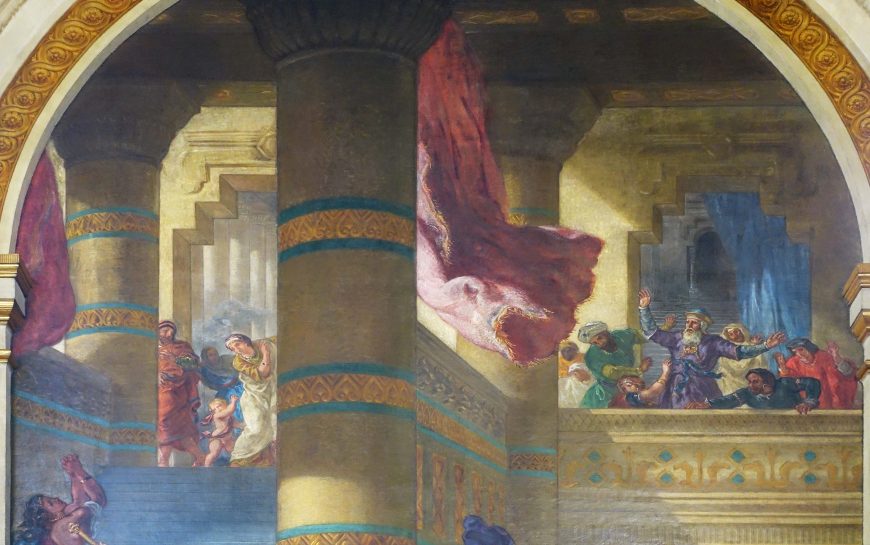
Scriptural Sources for Delacroix
Taking each scene in chronological order, Jacob’s strenuous tussle with an angel symbolizes a pivotal moment in Israel’s history, marking the continuation of the covenant between God and his chosen people. The figure of Jacob, once a man of selfishness and a liar, is tested, humbled, and forgiven by the divine messenger. His encounter is transformative and he is made worthy of inheriting the status of patriarch of the Hebrew people.
In the second scene, Heliodorus is sent by the King to rob the Jewish temple in Jerusalem of its supposed riches, but in response to the active prayers of the high priest Onais and the Jewish faithful, divine beings interrupt the sacrilege and swoop in to strike Heliodorus.
In a richly decorated interior, a majestic looking rider on horseback rushes in from the left, the hoof of his gray dappled steed striking the prone figure of Heliodorus into a position of submission. At the same time, two figures float above, energetically whipping him with reeds.
Finally, the third subject, Michael the archangel defeats Satan at the “End Time.” Michael is understood both as the guardian of the Israelites in the Old Testament Book of Daniel and also as the personification the Church triumphant in the New Testament. In each book of the Bible then, Michael represents a theology of salvation and resurrection.
The archangel Michael unites the three stories in Delacroix’s program as three from the Old Testament about salvation history for the Israelites. Simultaneously, Michael in the New Testament Book of Revelation suggests the continuity between the Old and New Testaments as a continuous narration of this history. In each of the mural subjects there are distinct and quite specific references to verses in the Bible.
At the time of Delacroix’s unveiling of the murals, at least three of his contemporaries recognized and wrote about this dual ascription of the figure of Michael the Archangel. One was the writer, Charles Baudelaire, in 1861.[1] In 1868, Abbé Alphonse Hurel was the first clergyman to praise Delacroix’s mural program at Saint-Sulpice as a biblical history. Hurel challenged the critics of the program, believing that Delacroix’s paintings had broken with traditional nineteenth-century iconography and shaken up religious art.
For a period of time, Delacroix’s romantic style of painting identified religious subject matter with modern art. Hurel claimed that the scenes of struggle (Jacob), of chastisement (Heliodorus), and of combat (Michael) were precisely the three subjects necessary to explain divine power, both for justice and for revenge in the battle of Good over Evil.[2] Hurel reminded audiences that for superior talents, there was no need to sacrifice art for theology, nor theology for art.
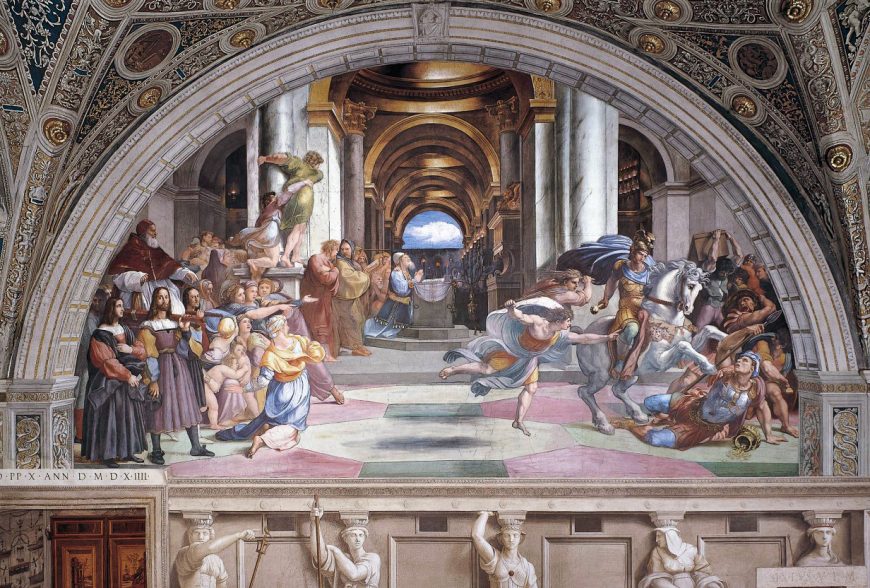
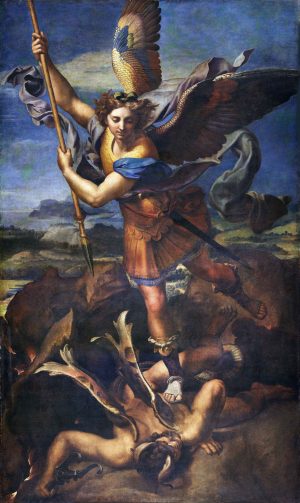
Formal sources for Delacroix
Two of the murals were inspired by the Renaissance artist Raphael’s Heliodorus Driven from the Temple and Archangel Michael Vanquishing the Demon. The model for the third subject remained unknown for a long time. Yet, it, too, is inspired by Raphael’s work. The figure of Jacob is found in a number of Raphael’s frescoes in the Vatican loggia that were later reproduced as engravings. Delacroix studied engravings of Raphael paintings in books located at the national library in Paris. Delacroix could read English texts and these designs by Raphael had been published in both French and English since the 1830s.
Delacroix made many pencil or ink sketches of these poses by Raphael, combining them to create the wrestling figure of Jacob. Moreover, Delacroix had published an essay about Raphael years earlier and knew the work of this esteemed artist. Strained poses and rapid movements characterize the action-oriented figures that Delacroix admired and copied from Raphael’s designs through the engravings made by Marcantonio Raimondi. In Heliodorus Vanquished from the Temple, Delacroix represents energetic forms with suppleness and grace and expressions of calm on the part of the divine intervenors.
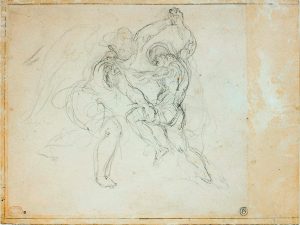
Literary sources for Delacroix
Delacroix found sources of inspiration for the murals at St. Sulpice from both poetry and prose, and he recorded some of these sources in his Journal. Specifically, he mentions the inspiration of his contemporary Alphonse Lamartine. One of Lamartine’s poem meditations, Jacob Wrestling with the Angel, offered verses from which Delacroix imaginatively translated the figures of the poem into pictorial form: “suddenly one rushes the other, the threatening arms, their legs press, their knees entwined.” Many of Delacroix’s preliminary drawings for this painting show clearly how the poses and forms correspond to the verses.
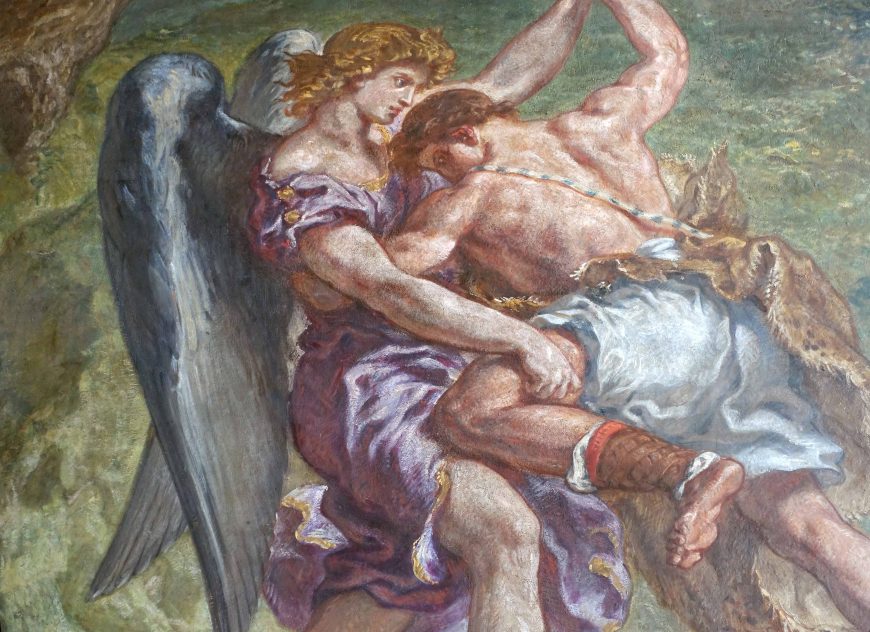
What is Delacroix’s meaning?

In this mural program, one scene is linked to another in a sequence that unifies the cycle of salvation history. The mural program recalls the narrative of the encounter between God, his angels, and his people, and their experience of being rescued by him.
In this chronological design of the salvific theme, Jacob’s struggle is the first event in the cycle and signifies his decision to believe; next, the Heliodorus story describes an historical event that tells of the protective action by God’s messengers; and finally, the archangel Michael personifies the belief of the ultimate victory of Good. Yet the critical connections to biblical sources, their religious meanings, and even the contemporary commentaries were either ignored or forgotten until 2008. [3]
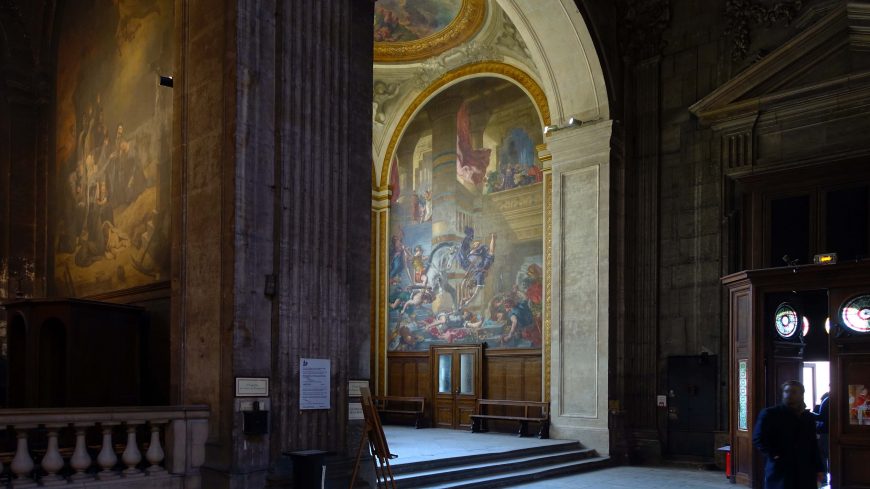
The program at Saint-Sulpice does not necessarily compromise Delacroix’s skeptical stance toward faith: rather, it prods us to consider his keen understanding of religious teachings. The artist who, by his own account, desired to sit in churches from time to time for “a good long meditation.” [4]
Notes:
- Additional reviews appeared in the journal Le Triboulet (1861) and the magazine La Revue chrétienne (1862).
- Hurel, L’Art religieux contemporaine (Paris: Didier, 1869), p. 372.
- Joyce C. Polistena, The Religious Paintings of Eugène Delacroix, (Lewiston: Mellen Press, 2008) and “Nouvelles sources pour le cycle des peintures murales de Delacroix à Saint-Sulpice” in Bulletin de la Société des Amis du musée de Delacroix, 2009, no. 7, pages 25-38.
- Entry from August 29, 1857 in Eugène Delacroix, Journal 1822-1863 (Paris: Librairie Plon, Collections Les Mémorables, 1996), page 676. There are several English language editions of the Journal. See The Journal of Eugene Delacroix, reprint (London: Phaidon, 2004).
Additional Resources
Musée National Eugène Delacroix
Putting a Delacroix puzzle back together, National Gallery of Denmark, SMK
Smarthistory images for teaching and learning:

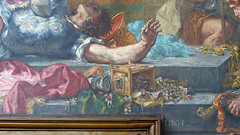
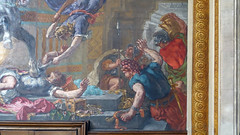
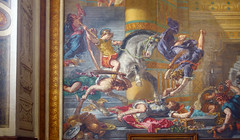
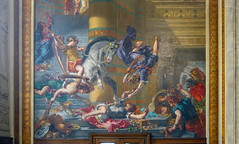
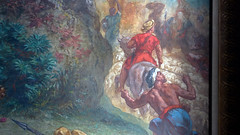
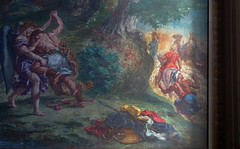


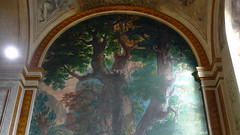
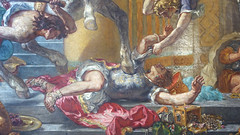
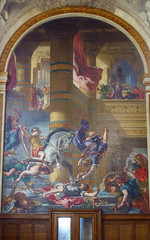

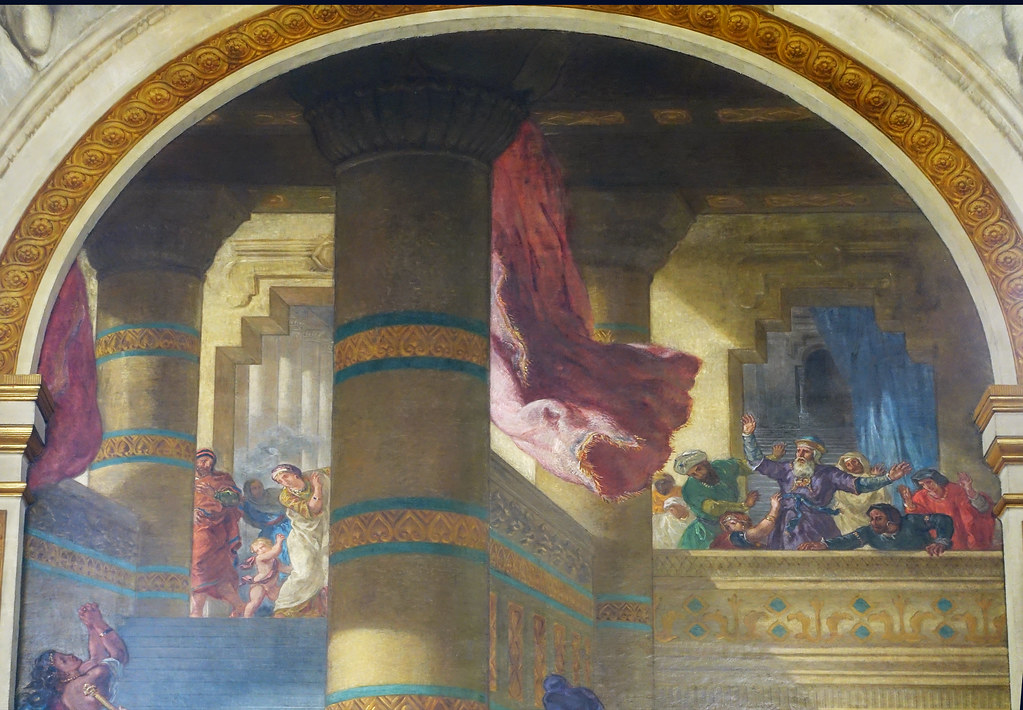
François Rude, La Marseillaise
by BEN POLLITT

Rude before The Departure
François Rude had revolution in his blood. At eight years-old, he watched his father, a stovemaker, join the volunteer army to defend the new French Republic (this is shortly after the French Revolution) from the threat of foreign invasion. Fiercely loyal himself, as a young man he was a Bonapartist (a follower of the emperor Napoleon Bonaparte). His support for the Emperor during the Cent Jours of 1814, when Napoleon returned to France from exile and tried to seize power from the newly restored monarch Louis XVIII, meant that Rude was forced to leave the country when Napoleon was finally defeated in 1815. Like the painter David, another ardent Bonapartist, he lived for some years in Belgium, returning to his native country in 1827.

His reputation grew over the next ten years, reaching its peak with the justly famous La Marseillaise (The Departure of the Volunteers of 1792) (above). Rude was awarded the commission on the strength of his hugely popular work, Neapolitan Fisherboy, a disarmingly cheerful and down-to-earth nude figure which was exhibited in plaster in the Salon of 1831. The sculpture seemed to conjure up the carefree lifestyles of humble Italian folk; a complete fiction, of course, but a dose of escapism was just what the French felt they needed following the turmoil of the July Revolution of 1830. An early, if somewhat toothless example of Romantic sculpture, it was bought by the state and for his efforts Rude was awarded the cross of the Legion of Honour.
The Arc de Triomphe
The Departure of the Volunteers of 1792, also known as La Marseillaise, is a different work entirely, more in keeping with what one now thinks of as Romantic; like a Beethoven symphony: intense, rousing, full of drama and movement.

It is Rude’s masterpiece and one of the best-known sculptures in the world. Its location has obviously contributed to its fame, attached as a bas-relief to the right foot of the façade of the Arc de Triomphe in Paris—on the Champs-Elysées facing side. An enormous fifty meters high structure, designed to celebrate France’s military achievements in 1806 by Jean Chalgrin, the arch’s construction was begun under Napoleon’s orders but remained unfinished when finally he was defeated in 1815.

The project was picked up again during the Constitutional Monarchy of Louis-Philippe (1830-48). The arch’s sculptural programme, seen by the king and his ministers as an ideal opportunity to promote national reconciliation, aimed to offer something that would please every segment of the French political spectrum. If Rude’s work flattered the Republicans (those who wanted to create a Republic in France), to the left of it, Cortot’s The Apotheosis of Napoleon I, or The Triumph of 1810 was pitched to the Bonapartists.
On the opposite side of the arch is Antoine Étex’s war and peace pendant group, The Resistance of 1814 and Peace—the former a stirring image of Napoleon’s supporters who continued to fight after his return from exile, the latter, appealing to the monarchists, an allegorical depiction of the Treaty of Paris that saw the restoration of the Bourbon royal dynasty.

When the arch was officially unveiled in 1836, there was unanimous agreement that Rude’s group made the other three pale into insignificance.
The sculpture and the song
The subject of Rude’s La Marseillaise (The Departure of the Volunteers of 1792) commemorates the Battle of Valmy when the French defended the Republic against an attack from the Austro-Prussian army. The popular title for the work, La Marseillaise, is the name of the French national anthem, which was written in 1792 by the army officer Claude Joseph Rouget de Lisle as part of a recruitment campaign. It was sung by a young volunteer, later to become a general under Napoleon, at a patriotic gathering in Marseille, the city from which the song gets its name, and was subsequently adopted as the army’s rallying cry.

Banned under the Bourbon administration, it was sounded by the crowds on the barricades in the July Revolution of 1830 and in the following years grew in popularity, the Romantic composer Hector Berlioz, for instance, giving it an orchestral arrangement. Having lodged itself so deeply in the public consciousness, evoking the spirit of republican defiance in the face of tyranny, the song must surely have been in Rude’s mind when drawing his designs for the sculpture.
The surge of the volunteers, inspired by the great sweeping movement of the Genius of Liberty above them, effectively illustrates in limestone the penultimate verse of the song:
Sacred love of the Fatherland,
Lead, support our avenging arms
Liberty, cherished Liberty,
Fight with thy defenders!
Under our flags, shall victory
Hurry to thy manly accents,
See thy triumph and our glory!


Like other great works of the period, Delacroix’s Liberty Leading the People, for instance, Rude’s sculpture effectively captures the energy of the new republic, more so perhaps than anything to be found in the art of the 1792 generation. It was their children, it seems, imbued with tales of heroic sacrifice, who, employing this epic, revolutionary style, known as Romanticism, brought to light the passion and the glory and, in the case of Delacroix, the hideous spectacle of death, too, that went into forging the new France.
This is not to say that Rude rejected neoclassicism, the treatment of the figures, some nude, some dressed in classic armor, draws heavily from antiquity, while the allegorical figure of Liberty recalls the Winged Victory of Samothrace in the Louvre.
The composition
Also, in the composition Rude uses the classical device of bilateral symmetry, positioning the figures along two axes: a horizontal axis that divides the frieze of soldiers in the lower half from the winged figure that fills the upper register; and a vertical axis that runs from the head of the Genius of Liberty through the vertical juncture between the two central soldiers. One suspects, in its vortex-like structure, Rude had studied in some detail Rubens’s copy of Leonardo’s Battle of Anghiari in the Louvre.

As with Leonardo, forms overlap, notably in the bottom register in which we find the head of a horse and two other soldiers positioned behind the five frontal figures, strengthening the group as a whole, which, when viewed from below, forms a semi-circular mass, packed tightly onto the plinth, at the point of spilling off it. Unlike Leonardo’s Battle, however, whose composition spirals inwards to a point of internal collapse, in The Departure, the bodies move like a wave, cresting at the point where the bearded soldier’s head overlaps with the leg of the Genius of Liberty, as though inspired by her to rally his troops to victory.
Mixed messages
For Rude and his fellow republicans, this was stirring stuff. As it happened, it was also the cause of celebration for the present government. The king, Louis-Philippe, was an Orleans, a member of that branch of the French royal family that, though related to the Bourbons, had been treated as subordinates by them.
For this reason, as a young man, he had shown support for the Revolution, even taking up arms in the Battle of Valmy, where he commanded his own division and exhibited some bravery. The Departure is therefore in its way a curious and rather paradoxical piece of propaganda, for in eulogizing the Revolutionary army who fought against the threat of an invasion that sought to restore the monarchy, the work also helps to lend credibility to Louis-Philippe, the ruling monarch.
This contradictory state of affairs would not have been lost on Rude who, despite the acclaim won by The Departure, over the coming years found himself more and more in opposition to the regime, nor for that matter was it lost on the French people themselves who having once and for all grown tired of monarchs, forced the abdication of their last one, Louis-Philippe, in the Revolution of 1848. Rude’s great call for the Liberty and the Republic, it would seem, was the one that triumphed in the end.
Additional resources:
François Rude’s Neopolitan Fisherboy at the Louvre
Listen to the La Marseillaise, the French national anthem
Smarthistory images for teaching and learning:


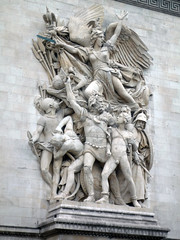
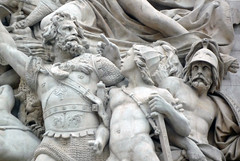
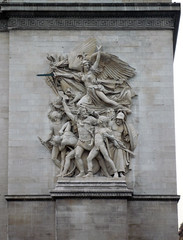
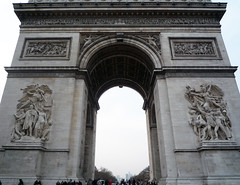
Romanticism in Spain
Goya depicted the demons that arise when reason sleeps.
c. 1800 - 1848
Francisco Goya
Francisco Goya, The Sleep of Reason Produces Monsters
by SARAH C. SCHAEFER

A dark vision
In this ominous image, we see the dark vision of humanity that characterizes Goya’s work for the rest of his life.
A man sleeps, apparently peacefully, even as bats and owls threaten from all sides and a lynx lays quiet, but wide-eyed and alert. Another creature sits at the center of the composition, staring not at the sleeping figure, but at us. Goya forces the viewer to become an active participant in the image––the monsters of his dreams even threaten us.
Los Caprichos
On 6 February 1799, Francisco Goya put an advertisement in the Diario de Madrid. “A Collection of Prints of Capricious Subjects,” he tells the reader, “Invented and Etched by Don Francisco Goya,” is available through subscription. We know this series of eighty prints as Los Caprichos (caprices, or follies).
Los Caprichos was a significant departure from the subjects that had occupied Goya up to that point––tapestry cartoons for the Spanish royal residences, portraits of monarchs and aristocrats, and a few commissions for church ceilings and altars.
Many of the prints in the Caprichos series express disdain for the pre-Enlightenment practices still popular in Spain at the end of the Eighteenth century (a powerful clergy, arranged marriages, superstition, etc.). Goya uses the series to critique contemporary Spanish society. As he explained in the advertisement, he chose subjects “from the multitude of follies and blunders common in every civil society, as well as from the vulgar prejudices and lies authorized by custom, ignorance or interest, those that he has thought most suitable matter for ridicule.”
The Caprichos was Goya’s most biting critique to date, and would eventually be censored. Of the eighty aquatints, number 43, “The Sleep of Reason Produces Monsters,” can essentially be seen as Goya’s manifesto and it should be noted that many observers believe he intended it as a self-portrait.
Imagination united with reason
In the image, an artist, asleep at his drawing table, is besieged by creatures associated in Spanish folk tradition with mystery and evil. The title of the print, emblazoned on the front of the desk, is often read as a proclamation of Goya’s adherence to the values of the Enlightenment—without Reason, evil and corruption prevail.
However, Goya wrote a caption for the print that complicates its message, “Imagination abandoned by reason produces impossible monsters; united with her, she is the mother of the arts and source of their wonders.”
In other words, Goya believed that imagination should never be completely renounced in favor of the strictly rational. For Goya, art is the child of reason in combination with imagination.

The beginnings of Romanticism
With this print, Goya is revealed as a transitional figure between the end of the Enlightenment and the emergence of Romanticism. The artist had spent the early part of his career working in the court of King Carlos III who adhered to many of the principles of the Enlightenment that were then spreading across Europe––social reform, the advancement of knowledge and science, and the creation of secular states. In Spain, Carlos reduced the power of the clergy and established strong support for the arts and sciences.
However, by the time Goya published the Caprichos, the promise of the Enlightenment had dimmed. Carlos III was dead and his less respected brother assumed the throne. Even in France, the political revolution inspired by the Enlightenment had devolved into violence during an episode known as the Reign of Terror. Soon after, Napoleon became Emperor of France.
Goya’s caption for “The Sleep of Reason,” warns that we should not be governed by reason alone—an idea central to Romanticism’s reaction against Enlightenment doctrine. Romantic artists and writers valued nature which was closely associated with emotion and imagination in opposition to the rationalism of Enlightenment philosophy. But “The Sleep of Reason” also anticipates the dark and haunting art Goya later created in reaction to the atrocities he witnessed—and carried out by the standard-bearers of the Enlightenment—the Napoleonic Guard.
Goya brilliantly exploited the atmospheric quality of aquatint to create this fantastical image. This printing process creates the grainy, dream-like tonality visible in the background of “The Sleep of Reason.”
Aquatint

Although the aquatint process was invented in 17th century by the Dutch printmaker, Jan van de Velde, many consider the Caprichos to be the first prints to fully exploit this process.
Aquatint is a variation of etching. Like etching, it uses a metal plate (often copper or zinc) that is covered with a waxy, acid-resistant resin. The artist draws an image directly into the resin with a needle so that the wax is removed exposing the metal plate below. When the scratch drawing is complete, the plate is submerged in an acid bath. The acid eats into the metal where lines have been etched. When the acid has bitten deeply enough, the plate is removed, rinsed and heated so that the remaining resin can be wiped away.
Aquatint requires an additional process, the artist sprinkles layers of powdery resin on the surface of the plate, heats it to harden the powder and dips it in an acid bath.
The acid eats around the resin powder creating a rich and varied surface. Ink is then pressed into the pits and linear recesses created by the acid and the flat surface of the plate is once again wiped clean. Finally, a piece of paper is pressed firmly against the inked plate and then pulled away, resulting in the finished image.
Francisco Goya, The Family of Charles IV
by DR. BETH HARRIS and DR. STEVEN ZUCKER
Video \(\PageIndex{7}\): Francisco Goya, The Family of Charles IV, c. 1800, Prado Museum, 280 cm x 336 cm (Museo Nacional del Prado, Madrid)
Francisco Goya, And there’s nothing to be done from The Disasters of War

And there’s nothing to be done
A man, blind-folded, head downcast, stands bound to a wooden pole. His white clothes, despite tears and rips, seem to emit light; although the man’s off-kilter posture signifies defeat, he is yet heroic, an Alter Christus—another Christ. On the ground in front of him is a corpse, contorted, the spine twisted, arms and legs sprawled in opposite directions. His grotesque face looks out at us through obscured eyes as blood and brain matter ooze out of his skull and pool around his head. Seconds ago this man was alive. Further off, to our hero’s left, other men, doubled over and on their knees, are similarly secured to wooden stakes. To his right we see the cause of the carnage: a neat line of soldiers aim rifles at the men, the muzzle of their weapons disappearing behind our hero’s hip. But the rest of the gun is not left to our imagination. Suddenly—and in such an obvious position that we wonder how we did not see them before—the barrel of three rifles appear from the right edge of the picture, aimed at our messianic hero. Not only is he about to die, but his executioners are everywhere. As the caption of the picture tells us, “Y no hay remedio” (And there’s nothing to be done).

Francisco Goya created the aquatint series The Disasters of War from 1810 to 1820. The eighty-two images add up to a visual indictment of and protest against the French occupation of Spain by Napoleon Bonaparte. The French Emperor had seized control of the country in 1807 after he tricked the king of Spain, Charles IV, into allowing Napoleon’s troops to pass its border, under the pretext of helping Charles invade Portugal. He did not. Instead, he usurped the throne and installed his brother, Joseph Bonaparte, as ruler of Spain. Soon, a bloody uprising occurred, in which countless Spaniards were slaughtered in Spain’s cities and countryside. Although Spain eventually expelled the French in 1814 following the Peninsular War (1807-1814), the military conflict was a long and gruesome ordeal for both nations. Throughout the entire time, Goya worked as a court artist for Joseph Bonaparte, though he would later deny any involvement with the French “intruder king.”
Process
Goya created his Disasters of War series by using the techniques of etching and drypoint. Goya was able to use this technique to create nuanced shades of light and dark that capture the powerful emotional intensity of the horrific scenes in the Disasters of War.
The first step was to etch the plate. This was done by covering a copper plate with wax and then scratching lines into the wax with a stylus (a sharp needle-like implement), which thus exposed the metal. The plate was then placed in an acid bath. The acid bit into the metal where it was exposed (the rest of the plate was protected by the wax). Next the acid was washed from the plate and the plate was heated so the wax softened and could be wiped away. The plate then had soft, even, recessed lines etched by the acid where Goya had drawn into the wax.
The next step, drypoint, created lines by a different method. Here Goya scratched directly into the surface of the plate with a stylus. This resulted in a less even line since each scratch left a small ragged ridge on either side of the line. These minute ridges catch the ink and create a soft distinctive line when printed. However, because these ridges are delicate and are crushed by repeatedly being run through a press, the earliest prints in a series are generally more highly valued.
Finally, the artist inked the plate and wiped away any excess so that ink remained only in the areas where the acid bit into the metal plate or where the stylus had scratched the surface. The plate and moist paper were then placed atop one another and run through a press. The paper, now a print, drew the ink from the metal, and became a mirror of the plate.
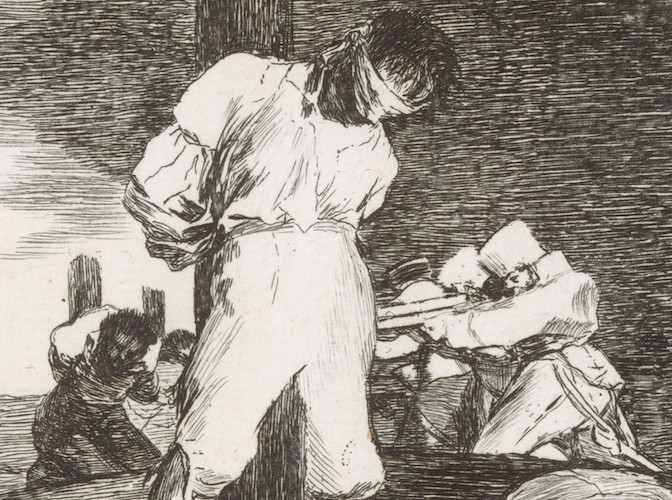
War as disaster
The first group of prints, to which “Y no hay remedio” belongs, shows the sobering consequences of conflict between French troops and Spanish civilians. The second group documents the effects of a famine that hit Spain in 1811-1812, at the end of French rule. The final set of pictures depicts the disappointment and demoralization of the Spanish rebels, who, after finally defeating the French, found that their reinstated monarchy would not accept any political reforms. Although they had expelled Bonaparte, the throne of Spain was still occupied by a tyrant. And this time, they had fought to put him there.

The Disasters of War were Goya’s second series, made after his earlier Los Caprichos. This set of images was also a critique of the contemporary world, satirizing the socio-economic system in Spain that caused most people to live in poverty and forced them to act immorally just to survive. Goya condemned all levels of society, from prostitutes to clergy. But The Disasters of War was not the last time that Goya would take on the subject of the horrors of the Peninsular War. In 1814, after completing The Disasters of War, Goya created his masterpiece The Third of May, 1808 which portrays the ramifications of the initial uprising of Spanish against the French, right after Napoleon’s takeover. Sometimes called “The first modern painting,” its resemblance to “Y no hai remedio” is undeniable. In this painting, a Christ-like figure stands in front of a firing squad, waiting to die. This line of soldiers is nearly identical to the murderers in the aquatint. In The Third of May, 1808 the number of assassins and victims is countless, indicating, once again, that “there is nothing to be done.” Although it is impossible to say whether the print or the painting came first, the repetition of the imagery is evidence that this theme—the inexorable cruelty of one group of people towards another—was a preoccupation of the artist, whose imagery would only become darker as he became older.


Although “And There’s Nothing to Be Done” may have crystallized the theme of The Disasters of War, it is not the most gruesome. This honor may belong to the print “Esto es peor (This is Worse),” which captures the real-life massacre of Spanish civilians by the French army in 1808. In the macabre image, Goya copied a famous Hellenistic Greek fragment, the Belvedere Torso (left), to create the body of the dead victim. Like the ancient fragment, he is armless, but this is because the French have mutilated his body, which is impaled on a tree through his anus and shoulder. As in “There is Nothing to be Done,” the corpse face stares out at the viewer, who must confront his own culpability in allowing the massacre to take place. “There is Nothing to be Done,” can also be compared to the plate “No se puede mirar (One cannot look),” in which the same faceless line of executioners points their weapons at a group of women and men, who are about to die.

Goya’s Disasters of War series was not printed until thirty-five years after the artist’s death, when it was finally safe for the artist’s political views to be known. The images remain shocking today, and even influenced the novel of famous American author Ernest Hemingway, For Whom the Bell Tolls, a book about the violence and inhumanity in the Spanish Civil War (1936-1939). Hemingway shared Goya’s belief, expressed in The Disasters of War, that war, even if justified, brings out the inhumane in man, and causes us to act like beasts. And for both artists, the consumer, who examines the dismembered corpses of the aquatints or reads the gruesome descriptions of murder but does nothing to stop the assassin, is complicit in the violence with the murderer.
Additional resources:
Goya, “And there is Nothing to be done” from Art Through Time
Francisco Goya, The Third of May, 1808
Video \(\PageIndex{8}\)
Napoleon puts his brother on the throne of Spain
In 1807, Napoleon, bent on conquering the world, brought Spain’s king, Charles IV, into alliance with him in order to conquer Portugal. Napoleon’s troops poured into Spain, supposedly just passing through. But Napoleon’s real intentions soon became clear: the alliance was a trick. The French were taking over. Joseph Bonaparte, Napoleon’s brother, was the new king of Spain.

The 2nd and 3rd of May, 1808
On May 2, 1808, hundreds of Spaniards rebelled. On May 3, these Spanish freedom fighters were rounded up and massacred by the French. Their blood literally ran through the streets of Madrid. Even though Goya had shown French sympathies in the past, the slaughter of his countrymen and the horrors of war made a profound impression on the artist. He commemorated both days of this gruesome uprising in paintings. Although Goya’s Second of May (above) is a tour de force of twisting bodies and charging horses reminiscent of Leonardo’s Battle of Anghiari, his The Third of May, 1808 in Madrid is acclaimed as one of the great paintings of all time, and has even been called the world’s first modern painting.

Death awaits
We see row of French soldiers aiming their guns at a Spanish man, who stretches out his arms in submission both to the men and to his fate. A country hill behind him takes the place of an executioner’s wall. A pile of dead bodies lies at his feet, streaming blood. To his other side, a line of Spanish rebels stretches endlessly into the landscape. They cover their eyes to avoid watching the death that they know awaits them. The city and civilization is far behind them. Even a monk, bowed in prayer, will soon be among the dead.

Transforming Christian iconography
Goya’s painting has been lauded for its brilliant transformation of Christian iconography and its poignant portrayal of man’s inhumanity to man. The central figure of the painting, who is clearly a poor laborer, takes the place of the crucified Christ; he is sacrificing himself for the good of his nation. The lantern that sits between him and the firing squad is the only source of light in the painting, and dazzlingly illuminates his body, bathing him in what can be perceived as spiritual light. His expressive face, which shows an emotion of anguish that is more sad than terrified, echoes Christ’s prayer on the cross, “Forgive them Father, they know not what they do.” Close inspection of the victim’s right hand also shows stigmata, referencing the marks made on Christ’s body during the Crucifixion.

The man’s pose not only equates him with Christ, but also acts as an assertion of his humanity. The French soldiers, by contrast, become mechanical or insect-like. They merge into one faceless, many-legged creature incapable of feeling human emotion. Nothing is going to stop them from murdering this man. The deep recession into space seems to imply that this type of brutality will never end.
Not heroism in battle
This depiction of warfare was a drastic departure from convention. In 18th century art, battle and death was represented as a bloodless affair with little emotional impact. Even the great French Romanticists were more concerned with producing a beautiful canvas in the tradition of history paintings, showing the hero in the heroic act, than with creating emotional impact. Goya’s painting, by contrast, presents us with an anti-hero, imbued with true pathos that had not been seen since, perhaps, the ancient Roman sculpture of The Dying Gaul. Goya’s central figure is not perishing heroically in battle, but rather being killed on the side of the road like an animal. Both the landscape and the dress of the men are nondescript, making the painting timeless. This is certainly why the work remains emotionally charged today.

Legacy
Future artists also admired The Third of May, 1808 in Madrid, and both Manet and Picasso used it for inspiration in their own portrayals of political murders (Manet’s Execution of Emperor Maximilian and Picasso’s Massacre in Korea). Along with Picasso’s Guernica, Goya’s Third of May remains one of the most chilling images ever created of the atrocities of war, and it is difficult to imagine how much more powerful it must have been in the pre-photographic era, before people were bombarded with images of warfare in the media. A powerful anti-war statement, Goya is not only criticizing the nations that wage war on one another, but is also admonishing us, the viewers, for being complicit in acts of violence, which occur not between abstract entities like “countries,” but between human beings standing a few feet away from one another.
Francisco Goya, Saturn Devouring One Of His Sons
by DR. BETH HARRIS and DR. STEVEN ZUCKER
Video \(\PageIndex{9}\): Francisco de Goya y Lucientes, Saturn Devouring One Of His Sons, 1821-1823, 143.5 x 81.4 cm (Prado, Madrid)
One of the “Black Paintings” that Goya painted on the walls of his house outside Madrid, this image was originally located on the lower floor of the house known as “la Quinta del Sordo.” Goya painted on the walls using several materials including oil paint. The “Black Paintings” had suffered significant damage and loss in their original location and when they were removed from the walls and transferred to canvas by Baron Émile d’Erlanger shortly after he aquired the house in 1873. Please note that Saturn is also known as Cronus or Kronus.
Romanticism in England
Artists in early nineteenth century England celebrated nature at its most humble, and its most grand.
c. 1780 - 1848
Henry Fuseli
Henry Fuseli, The Nightmare

Shocked, titillated, and frightened
Working during the height of the Enlightenment, the so-called “Age of Reason,” the Swiss-English painter Henry Fuseli (born Johann Heinrich Füssli) instead chose to depict darker, irrational forces in his famous painting The Nightmare. In Fuseli’s startling composition, a woman bathed in white light stretches across a bed, her arms, neck, and head hanging off the end of the mattress. An apelike figure crouches on her chest while a horse with glowing eyes and flared nostrils emerges from the shadowy background.
The painting was first displayed at the annual Royal Academy exhibition in London in 1782, where it shocked, titillated, and frightened exhibition visitors and critics. Unlike many of the paintings that were then popular and successful at the Royal Academy exhibitions, Fuseli’s The Nightmare has no moralizing subject. The scene is an invented one, a product of Fuseli’s imagination. It certainly has a literary character and the various figures demonstrate Fuseli’s broad knowledge of art history, but The Nightmare’s subject is not drawn from history, the Bible, or literature. The painting has yielded many interpretations and is seen as prefiguring late nineteenth-century psychoanalytic theories regarding dreams and the unconscious (Sigmund Freud allegedly kept a reproduction of the painting on the wall of his apartment in Vienna).
Incubus or mara
The figure that sits upon the woman’s chest is often described as an imp or an incubus, a type of spirit said to lie atop people in their sleep or even to have sexual intercourse with sleeping women. Fuseli’s painting is suggestive but not explicit, leaving open the possibility that the woman is simply dreaming. Yet, her dream appears to take frightening, physical form in the shapes of the incubus and the horse. According to Fuseli’s friend and biographer John Knowles, who saw the first drawing Fuseli made for the composition in 1781, the horse was not present in the drawing but added to the painting later.

Although it is tempting to understand the painting’s title as a punning reference to the horse, the word “nightmare” does not refer to horses. Rather, in the now obsolete definition of the term, a mare is an evil spirit that tortures humans while they sleep. As Samuel Johnson’s A Dictionary of the English Language (1755) defined it, a mare or “mara, [is] a spirit that, in heathen mythology, was related to torment or to suffocate sleepers. A morbid oppression in the night resembling the pressure of weight upon the breast.” Thus, Fuseli’s painting may in fact be understood as embodying the physical experience of chest pressure felt during a dream-state.
Dark themes
Through his use of composition and chiaroscuro – the strategic juxtaposition of sharply contrasting light and shadow—Fuseli heightened the drama and uncertainty of his scene. However, unlike the slightly earlier painting by Joseph Wright of Derby, A Philosopher Lecturing on the Orrery, which utilized chiaroscuro to symbolize the enlightening power of rational observation, Fuseli’s The Nightmare instead shows the futility of light to penetrate or explain the darker realms of the unconscious.

In The Nightmare, the single light source coming in from the right, the curtains and tassels in the background, and the shortened, stage-like foreground also add to the work’s theatricality. The red drapery falling off the edge of the bed even suggests a river of blood as it might be symbolically enacted on stage in a play or an opera, adding morbid undertones to the painting’s already dark themes. Throughout his career, Fuseli painted and illustrated scenes from Shakespeare and Milton, and his art has a consistent sense of literary, at times even erudite drama that reveals his classical education (after completing his studies, Fuseli had been ordained as a pastor in the Swiss Evangelical Reformed Church before his political activities in Zürich effectively forced him into exile in 1761).

The Nightmare’s stark mixture of horror, sexuality, and morbidity has insured its enduring notoriety. In January 1783, The Nightmare was engraved by Thomas Burke and distributed by the publisher John Raphael Smith. The relatively low price of this reproduction following on the heels of the attention the work received at the Royal Academy helped to distribute the image to a wider audience. Fuseli later painted at least three more variations with the same title and subject.
The Nightmare became an icon of Romanticism and a defining image of Gothic horror, inspiring the poet Erasmus Darwin (Charles Darwin’s grandfather) and the writers Mary Shelley and Edgar Allan Poe among many others. From the start, caricaturists also adopted Fuseli’s composition, and political figures from Napoleon Bonaparte to President George W. Bush and German Chancellor Angela Merkel have all been lampooned in satirical versions of Fuseli’s painting.
Henry Fuseli, Titania and Bottom
by DR. STEVEN ZUCKER and DR. BETH HARRIS
Video \(\PageIndex{10}\): Henry Fuseli, Titania and Bottom, c. 1790, oil on canvas, 2172 x 2756 mm (Tate Britain, London)
Smarthistory images for teaching and learning:
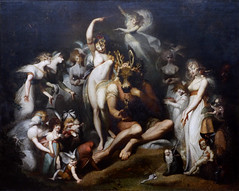
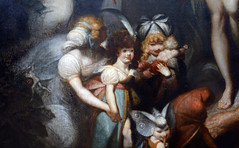
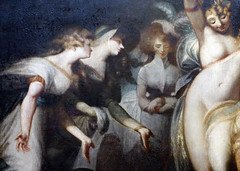
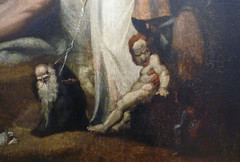
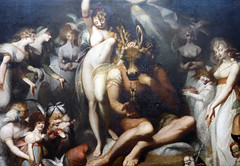
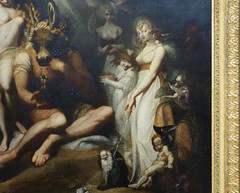

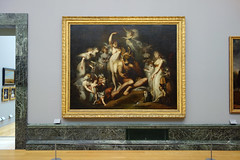
William Blake, The spiritual form of Nelson guiding Leviathan
by BEN POLLITT
William Blake occupies a unique position in art history in that he was both a major artist and a major poet. Often the two went hand-in-hand, his art illustrating his poetry, or if not his, the poetry of others. I suppose, then, for me, what makes this such an intriguing example of his work is the fact that here, unusually for Blake, the subject is not drawn from any literary source, but from contemporary history.
The spiritual form of Nelson guiding Leviathan was first shown in his solo exhibition of 1809, held at his brother’s house in London’s Soho; a site, incidentally, that also served as the family shop, selling women’s stockings. The reviews were mostly negative, one famously describing the paintings as “the wild effusions of a distempered brain.” Not everyone hated it, though, and some of the paintings did sell, including this portrait of Admiral Nelson.
Admiral Nelson

Nelson was the hero of one of the greatest events of this period, the Battle of Trafalgar in 1805. You might know him as the figure atop the column in Trafalgar Square. At the Battle of Trafalgar, Nelson led a great victory over Napoleon’s navy, but was fatally wounded. The outpourings of patriotic feeling that followed these events and the artistic opportunities they offered, were quickly exploited by many artists.
Blake’s Nelson, however, is a world away from those melodramatic scenes of the dying hero that were so current at the time like the above example by Benjamin West.
A spiritual likeness?
Instead of a lifelike portrait, Blake paints Nelson’s “Spiritual” likeness. He stands on top of the Biblical sea creature, Leviathan, whose body encircles him. Nelson controls the beast with a bridle, attached to its neck, which he holds loosely in his left hand. Trapped in, crushed under, or in one case, half-consumed within Leviathan’s coiled body, ten figures, male and female, are arranged around the figure of Nelson; these represent the European nations defeated by the British during the Napoleonic Wars. Under his feet is a black body, whose wrists are fettered. The head and arms of the figure to the bottom left appear to be submerged under water, which occupies the lowest portion of the painting. Nelson stands in the center of a graphic explosion of color, creating a corona of light around him.
West, Immortality of Nelson

The visual coupling of explosion and water may bring to mind naval conflicts, but clearly this is no illusionistic representation of any specific battle. The painting should rather be viewed as an allegory, a representation of an abstract idea in material form.
Benjamin West’s The Immortality of Nelson of 1807 is similarly allegorical. Here Neptune delivers the soul of Nelson into the arms of Brittania (an allegorical figure of Great Britain). West draws on Christian art in the composition, recalling Rubens’ Descent from the Cross.
Classical, Biblical and Hindu References
Like West, Blake also uses classical and Christian references: the nude Nelson in contrapposto is modeled on the Apollo Belvedere, for instance. Similarly, Nelson is shown with Christ-like attributes: the halo and the loincloth. What distinguishes Blake’s image is the unusual composition that critics have noted owes more to Indian than Graeco-Roman or Christian art, specifically statues of Nataraja (the Dancing Shiva, the Hindu god of destruction, who dances within an aureole of fire, standing on Apasmara, the Dwarf of Ignorance, who is killed during the dance).

Blake highlights this connection in the Descriptive Catalog he wrote for the exhibition. Here, he claims to have been “taken in vision” and shown works of art from “Persian, Hindoo, and Egyptian Antiquity…some of them one hundred feet in height.” Drawing on these visionary works he wished to create similarly grand images of national heroes. Though modestly proportioned, Blake hoped this preparatory work would gain him a commission to create a massive fresco. It was for this reason he painted using tempera, only on canvas rather than plaster, which sadly accounts for the sorry state of the painting.
For all his talk of visions, though, Blake would have seen Hindu art in his waking hours, too, as Britain’s growing colonial presence in India meant that translations of Hindu scriptures and engravings of its artworks were in wide circulation. Among educated circles these works were discussed with avid interest, many holding the view that in India could be found the source for all the world religions. Blake draws on these ideas in the painting, which is exceptionally eclectic in its scriptural references. Leviathan comes from the Old Testament, and like Shiva, is said to represent the forces of destruction in the world. It is difficult to know what Blake is implying here though, for while Shiva destroys in order to transform and so is seen as a positive force, in Christian tradition at least, Leviathan is generally held to be an agent of Satan.
Certainly, there is something confusing, if not downright disconcerting, in this alliance of a national hero with a diabolical monster. Similarly, the contorted figures and agonized expressions of the defeated nations contrasts uncomfortably with the calm, classical elegance of Nelson; while compositionally, the claustrophobic treatment of the space lends the painting a nightmarish quality giving one the distinct impression that this is more a critique than a celebration of Britain’s naval supremacy, a view supported in the fact that Blake himself was a pacifist.
An anti-slavery message?
Blake was also a fierce opponent of slavery. The black body in the painting may act as a reference to the Slave Trade Act of 1807, which abolished the trade of slaves in the British Empire. This figure is situated, much as Apasmara the dwarf is to the Dancing Shiva, directly beneath Nelson’s feet. It could be argued that, just as the one stands for ignorance, the figure here represents not an individual slave as such, but slavery itself, which is in the process of being destroyed.

Whatever Blake’s intentions may have been in depicting the figure thus, we are struck most by his individual suffering, prostrate and wretched, if anything he serves to remind us that though the trade had been criminalized, slavery itself would continue to be legal for many years to come.
Wildly ambitious and devilishly ambiguous, The Spiritual Form of Nelson guiding Leviathan is a work that for all its oddities and contradictions speaks directly to us in our postcolonial age. Undoubtedly the British Imperial project, made possible by its naval strength, enriched Britain financially through the appropriation of immense natural resources, as well as culturally through the influx of new ideas and new artistic languages. The question remains though as to what rights and responsibilities metropolitan artists, like Blake, have when adopting the intellectual, cultural and artistic resources of other, less dominant, cultures.
Additional resources:
This painting at the Tate Britain
William Blake, the artist (Metropolitan Museum of Art’s Heilbrunn Timeline of Art History)
Benjamin West, Death of Nelson at the Walker Art Gallery, Liverpool
Benjamin West, The Immortality of Nelson at the National Maritime Museum
Nelson: The Hero and the Man (BBC site)
Bronze Figure of Nataraja at the British Museum
William Blake, The Parable of the Wise and Foolish Virgins
by THE METROPOLITAN MUSEUM OF ART
Video \(\PageIndex{11}\): William Blake, The Parable of the Wise and Foolish Virgins, ca. 1799–1800, watercolor, pen and black ink over graphite, 14 3/16 × 13 1/16″ / 36 × 33.2 cm (The Metropolitan Museum of Art, New York). Video from The Metropolitan Museum of Art.
Additional resources:
John Constable
Constable and the English landscape
by DR. BETH HARRIS and DR. STEVEN ZUCKER

Reviving landscape painting
Studying the English painter John Constable is helpful in understanding the changing meaning of nature during the industrial revolution. He is, in fact, largely responsible for reviving the importance of landscape painting in the 19th century. A key event, when it is remembered that landscape would become the primary subject of the Impressionists later in the century.
Landscape had had a brief moment of glory amongst the Dutch masters of the 17th century. Ruisdael and others had devoted large canvases to the depiction of the low countries. But in the 18th century hierarchy of subject matter, landscape was nearly the lowest type of painting. Only the still-life was considered less important. This would change in the first decades of the 19th century when Constable began to depict his father’s farm on oversized six-foot long canvases. These “six-footers” as they are called, challenged the status quo. Here landscape was presented on the scale of history painting.
Why would Constable take such a bold step, and perhaps more to the point, why were his canvases celebrated (and they were, by no less important a figure than Eugène Delacroix, when Constable’s The Hay Wain was exhibited at the Paris Salon in 1824)?
Painted in the studio, from sketches done out-of-doors

The Hay Wain does include an element of genre (the depiction of a common scene), that is the farm hand taking his horse and wagon (or wain) across the stream. But this action is minor and seems to offer the viewer the barest of pretenses for what is virtually a pure landscape. Unlike the later Impressionists, Constable’s large polished canvases were painted in his studio.
He did, however, sketch outside, directly before his subject. This was necessary for Constable as he sought a high degree of accuracy in many specifics. For instance, the wagon and tack (harness, etc.) are all clearly and specifically depicted, The trees are identifiable by species, and Constable was the first artist we know of who studied meteorology so that the clouds and the atmospheric conditions that he rendered were scientifically precise.
Constable was clearly the product of the Age of Enlightenment and its increasing confidence in science. But Constable was also deeply influenced by the social and economic impact of the industrial revolution.
From farming to factories, from country to city

Prior to the 19th century, even the largest European cities counted their populations only in the hundreds of thousands. These were mere towns by today’s standards. But this would change rapidly. The world’s economies had always been based largely on agriculture. Farming was a labor intensive enterprise and the result was that the vast majority of the population lived in rural communities. The industrial revolution would reverse this ancient pattern of population distribution. Industrial efficiencies meant widespread unemployment in the country and the great migration to the cities began. The cities of London, Manchester, Paris, and New York doubled and doubled again in the 19th century. Imagine the stresses on a modern day New York if we had even a modest increase in population and the stresses of the 19th century become clear.
Industrialization remade virtually every aspect of society. Based on the political, technological and scientific advances of the Age of Enlightenment, blessed with a bountiful supply of the inexpensive albeit filthy fuel, coal, and advances in metallurgy and steam power, the northwestern nations of Europe invented the world that we now know in the West. Urban culture, expectations of leisure, and middle class affluence in general all resulted from these changes. But the transition was brutal for the poor. Housing was miserable, unventilated and often dangerously hot in the summer. Unclean water spread disease rapidly and there was minimal health care. Corruption was high, pay was low and hours inhumane.
Child labor, long hours & calls for revolution

As is still true in too much of the world today, families would depend on the labor of even very young children. Working long days with only Sunday off was normal. The contemporaneous author Charles Dickens famously chronicled the depravity of laissez-faire or pure market capitalism that characterized this era. There were no laws to soften this harsh new world. No unemployment insurance, no health insurance, no unions, no benefits, no vacations, no retirement, few safety regulations, no child labor nor bankruptcy protections. If you couldn’t pay a debt because you had been sick and lost your job, you, and sometimes your family, were sent to prison. The wealth created by the rich (the return on risked capital) was largely theirs to keep as a permanent national income tax would not become law until 1874 (U.K.) and 1913 (U.S.).
Such terrible abuses were answered by both calls for reform and revolution. Radicals and bourgeois reformers slowly forced change. In 1848, Karl Marx and Frederick Engels co-authored a pamphlet that would become enormously influential, The Communist Manifesto while revolts raged in England, France and to a lesser extent in Germany. It is no surprise that France and England were particularly hard hit as they were amongst the most industrialized of nations.
Rural landscape as a lost Eden
What effect did these changes have on the ways in which the countryside was understood? Can these changes be linked to Constable’s attention to the countryside? Some art historians have suggested that Constable was indeed responding to such shifts. As the cities and their problems grew, the urban elite, those that had grown rich from an industrial economy, began to look to the countryside not as a place so wretched with poverty that thousands were fleeing for an uncertain future in the city, but rather as an idealized vision.
The rural landscape became a lost Eden, a place of one’s childhood, where the good air and water, the open spaces and hard and honest work of farm labor created a moral open space that contrasted sharply with the perceived evils of modern urban life. Constable’s art then functions as an expression of the increasing importance of rural life, at least from the perspective of the wealthy urban elite for whom these canvases were intended. The Hay Wain is a celebration of a simpler time, a precious and moral place lost to the city dweller.
Additional resources:
John Constable on The Metropolitan Museum of Art’s Heilbrunn Timeline of Art History
Romanticism on The Metropolitan Museum of Art’s Heilbrunn Timeline of Art History
Smarthistory images for teaching and learning:
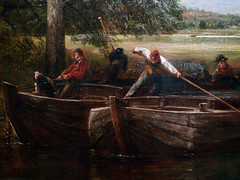
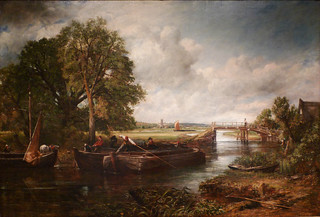
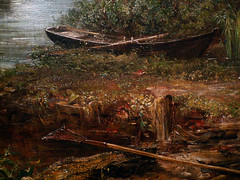
John Constable, Wivenhoe Park, Essex
When we think about a portrait, we think about a person. A man or woman, boy or girl. Maybe on occasion a favored pet, but always a living being. The portrait serves as a record of his or her appearance, characteristics, and interests.
Does a portrait have to be of a person, though? People often ascribe human characteristics to inanimate objects. A car that is having trouble starting might be “stubborn,” or a powerful storm might be “angry.” What if the attributes shown in a landscape were supposed to be ascribed to the person who owned that land?

With Wivenhoe Park, Essex, landscape painter John Constable depicted an English country estate in order to make a broader statement about its owner and his relationship with nature in the early nineteenth century.
Wivenhoe Park
Major-General Francis Slater Reboe owned Wivenhoe Park, a quiet countryside estate located approximately seventy miles northeast of London. Rebow was friends with corn merchant Golding Constable, whose son John insisted on pursuing the career of an artist rather than take up his father’s business. The wealthy officer was one of John Constable’s first patrons.
The 200-acre estate at Wivenhoe was the pride of Major-General Rebow’s father-in-law, Colonel Isaac Martin Rebow (interestingly, the Major-General took his wife’s last name after marriage), who purchased the land in the 1730s and commissioned the construction of Wivenhoe House in 1759, and then massive alterations in the 1770s to the surrounding parkland, designed by the landscape architect Richard Woods.

Wivenhoe Park’s grounds were redesigned along the lines of the picturesque, an aesthetic concept which combined elements of the philosophy of the awe-inspiring Sublime and the serene Beautiful—categories of landscape painting in the eighteenth century. An example of the picturesque is Nicolas Poussin’s Landscape with St. John (above), which combines rocky hills and architectural ruins with lush greenery and a peaceful summer’s day.

In order to evoke a sense of the picturesque the architect Woods introduced an arch and bridge specifically designed to look old, multiple curving roads lined with trees, and two new lakes for fishing and boating. Rebow’s estate was a prime example of the picturesque in England, and a source of pride for the entire family.

The gorgeous estate of Wivenhoe Park is evident in Constable’s painting. Filled with rolling hills populated by people and livestock, lit by soft sunlight streaming through low-hanging clouds, and highlighted by a large lake in the foreground and a country home peeking from behind a stand of trees in the background, the landscape of Wivenhoe Park entices viewers with a vision of rural beauty, simplicity, and harmony.
Constable’s connection to nature
Today John Constable is regarded as one of the two great British landscape artists of the nineteenth century, alongside his contemporary J.M.W. Turner. During his lifetime, however, Constable was afforded little respect. He almost exclusively painted landscapes—avoiding the far more popular genres of history painting and portraiture. Most of his artistic output is comprised of images of the rural countryside of England’s Suffolk and Essex counties, where Wivenhoe Park was located. Whereas most artists would sketch scenes in nature before returning to the studio to paint, beginning in 1814 Constable began to bring his canvases outside and paint directly from nature, adding a sense of veracity and immediacy to his paintings and inspiring future artists like those that would form the Barbizon School (French artists who painted landscapes in a forest near Paris, beginning in the 1830s) as well as the later Impressionists (beginning in the 1860s).

Constable was deeply invested in the physical experience of nature. His paintings possess a strong sense of the particular, and demonstrate a keen artist’s eye turned to the environment. The artist famously studied weather reports and spent countless hours sketching clouds, which he rendered with precise meteorological detail in Wivenhoe Park, Essex. Similarly, the play of light and shadow across the right foreground, and the glimmers of light reflected off the pond in the middle of the composition, enhance the sense of a real, observed landscape. Constable believed that an artist could encourage positive and negative emotions in the viewer through the depiction of nature—particularly through the play of light and dark on the landscape and skyscape.
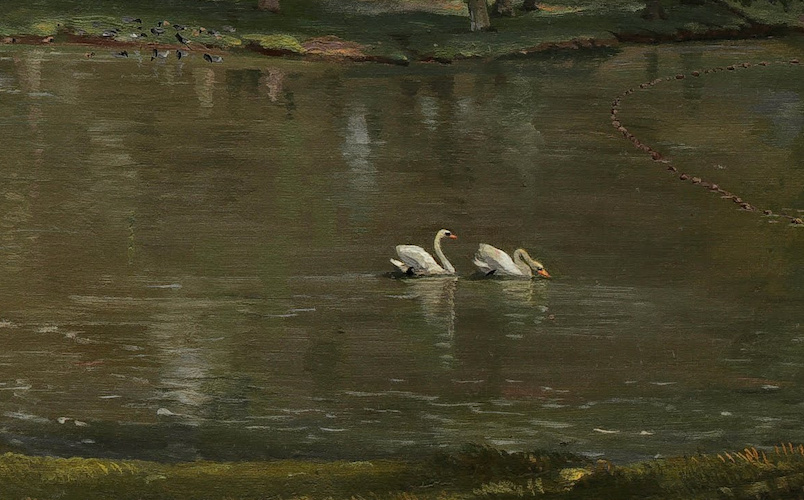
The present past
The emotions Constable intended to stir up in his viewers were, much like in his later View on the Stour near Dedham (below), those of a nostalgia for the past, and a desire to recapture the English connection to nature that was disappearing during the early decades of the Industrial Revolution (among other things, the shift from producing many objects by hand to mass-produced, factory-made objects using machinery and steam power).

Wivenhoe Park, Essex depicts an idyllic England that still physically existed in some locations, but was barely holding on, ideologically speaking. Much like Turner’s The Fighting Temeraire, Wivenhoe Park, Essex celebrates its subject while mourning the end of the era in which it was created. In this sense, the painting functions as a portrait: of eighteenth-century England; of the English countryside; and of the estate’s owner, Major-General Rebow, and the values he attempted to uphold. Considering the fact that much of the picturesque estate of Wivenhoe Park was designed by an architect, the foregrounded presence of the manmade lake also speaks to Rebow’s dominion over the lands he owned.

There is one member of the Rebow family included in the composition: Mary Rebow, the 11-year-old daughter of Major-General Rebow, who can be seen on the left side of the canvas driving the donkey cart. Her red scarf, one of the girl’s favorite accessories, is a brief flash of color in a composition otherwise dominated by greens, blues, and browns. Constable, then in his 40th year, seems to have doted on the little girl, perhaps hoping to have a child like her one day with the woman he was then courting, longtime friend Maria Bicknell. Constable’s biographer wrote that Constable’s “fondness for children exceeded, indeed, that of any man I ever knew.”[1] In a letter to Maria dated August 21, 1816, Constable describes his visit to Wivenhoe Park and notes that Major-General Rebow had in fact commissioned two paintings, one of the estate and one of a small building on the estate grounds, both of which were to include references to Mary Rebow: “…the heroine of all these scenes.”[2] The commissions were essentially early marriage gifts to Constable, as the Rebows were well aware that he was saving money to pay for his wedding to Maria, whose grandfather had threatened to disinherit her if she insisted on marrying the financially unstable artist. The two were married on October 2, 1816, less than a month after Constable completed Wivenhoe Park, Essex.
With impending fatherhood on his mind, Constable was aware of the stakes for Major-General Rebow and his daughter. Rebow wanted to secure his legacy and ensure future security for his daughter, yet in this transitional period of history he had no idea what young Mary Rebow’s future would look like, only that her life could not resemble his. Asking Constable to include her in his painting was one way for the Major-General to ensure that Mary was always present in the bucolic landscape she grew up in, regardless of what might come of that landscape in the future. Furthermore, with the inclusion of such small details like the young girl’s scarf, the canvas rewards those viewers who actually knew the family and the estate, and could recognize those references, creating a deeper meaning for the Rebow family and their intimates.

Wivenhoe Park, Essex is a record of a particular location at a particular moment in time, but also a nostalgic image of the English past, a past that never quite existed. Humans tend to remember the past as far more positive or negative than it may have actually been and Wivenhoe Park, Essex is no exception. The artist rearranged the landscape to create a more harmonious image. For example, the lake and house would not have been visible in the same view in real life. Additionally, at some point during his painting process Constable extended the canvas on both sides to include additional details, such as a hunting lodge on the far right. The seams created where the new pieces of canvas were stitched onto the existing fabric are visible running through the figure of the young boy wearing a white shirt in the boat on the right side of the painting, and on the left through the neck of the black cow in the left foreground.
Prelude to six-footers
Less than two years after completing Wivenhoe Park, Essex, Constable embarked on the process of painting a series of monumental landscape paintings of the Stour River Valley, known as his “six-footers,” a name which referred to the width of the canvases. At 40 years of age when he married Maria Bicknell in 1816, Constable was still seeking the honor of election to the Royal Academy—the surest indicator of professional success for an artist working in England. Wivenhoe Park, Essex serves as a precursor to those massive canvases, allowing the artist to practice organizing a series of complex landscape details, vignettes of daily life, and a visceral depiction of elements, like sun and wind, into one coherent composition.
The “six-footers” vaulted Constable to greater popular acclaim, and eventually he was elected to the Royal Academy in 1829. Wivenhoe Park, Essex remained in possesion of the Rebow family until 1906, and Wivenhoe Park itself until 1902. Perhaps ironicly, considering Major-General Rebow’s apprehension of the forthcoming industrial age and the nostalgia radiating from Constable’s canvas, Wivenhoe Park is now owned by the University of Essex, and the stately Wivenhoe House featured in the center of the painting is now a four-star luxury hotel, used to train university students studying for a career in hospitality.
1. Charles Robert Leslie, Memoirs of the Life of John Constable, esq., RA (Longman, Brown, Green and Longmans, 1845), p. 77.
2. Charles Robert Leslie, Memoirs of the Life of John Constable, esq., RA (Longman, Brown, Green and Longmans, 1845), p. 73.
Additional resources:
Constable’s Wivenhoe Park, Essex at the National Gallery of Art
View this work up close on the Google Art Project
Video from The National Gallery of Art about Constable’s Wivenhoe Park, Essex
John Constable on The Metropolitan Museum of Art’s Heilbrunn Timeline of Art History
John Constable, The Hay Wain
by DR. STEVEN ZUCKER and DR. BETH HARRIS
Video \(\PageIndex{12}\): John Constable, The Hay Wain (Landscape: Noon), 1821, oil on canvas, 130.2 x 185.4 cm (The National Gallery, London). Speakers: Dr. Steven Zucker and Dr. Beth Harris
Additional resources:
This painting at The National Gallery
John Constable at the Metropolitan Museum of Art’s Heilbrunn Timeline of Art History
Graham Reynolds, Constable’s England (Metropolitan Museum of Art, 1983)
Smarthistory images for teaching and learning:
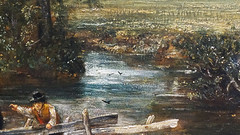
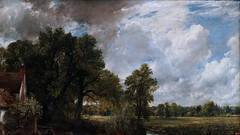
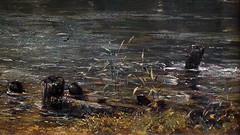
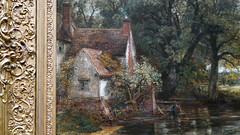

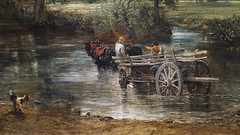

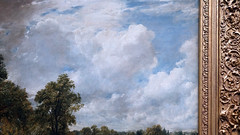
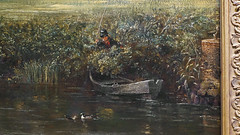
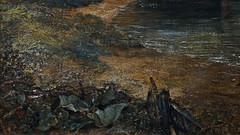

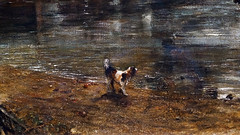
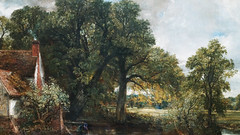
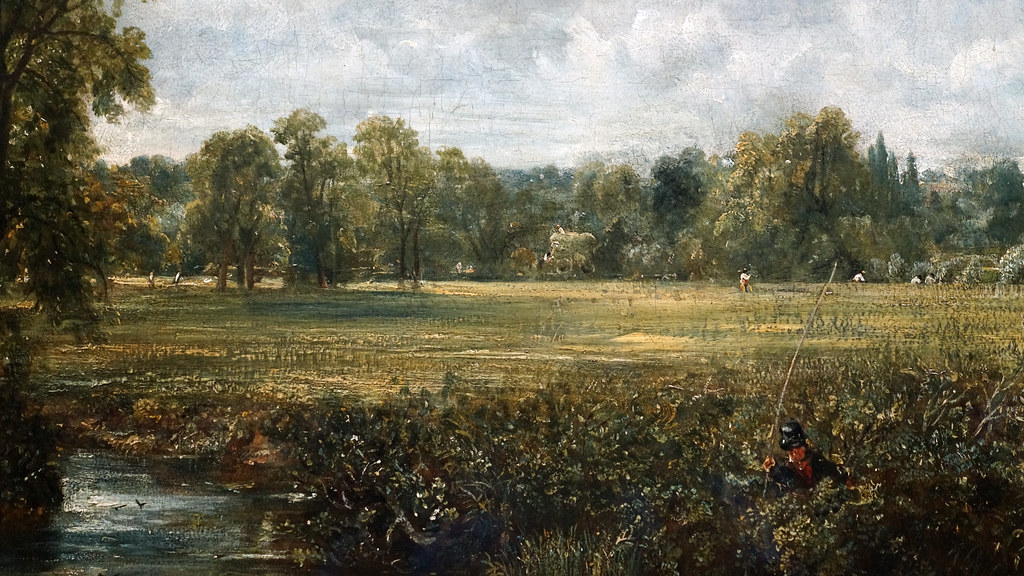
John Constable, View on the Stour near Dedham
by DR. BETH HARRIS and DR. STEVEN ZUCKER
Video \(\PageIndex{13}\): John Constable, View on the Stour near Dedham, 1822, oil on canvas, 51 x 74″ (The Huntington Library, Art Collections, and Botanical Gardens, San Marino, CA)
Smarthistory images for teaching and learning:



John Constable, Salisbury Cathedral from the Meadows
by BEN POLLITT
A Romantic scientist
For Constable “Truth (in all things)” was what mattered. Not for him Turner’s clash of elemental forces – land, sea, sun and sky – creating those highly dramatic, almost abstract fields of color. Constable instead pursued an art that was, in his own words, “legitimate, scientific, mechanical.”
That the same artist could declare, without fear of contradiction, that “painting is but another word for feeling” should not surprise us. For what we might see as a conflict between the scientific and the emotional was for the Romantics nothing of the kind. For them reason and emotion informed and enhanced each other, so that truth gained through the filter of personal experience was considered of a higher order than that got by slavish reference to universal laws.

The sky
In this sense, Constable was a great empiricist, scrupulous in his recordings of natural phenomena but artistically aware enough to appreciate that these recordings were deeply informed by his own emotional being. Nowhere is this more apparent than in his treatment of the sky. “The sky is the source of light in Nature,” he wrote, “and it governs everything.” Certainly it is one of the most intriguing features in Salisbury Cathedral from the Meadows. Before getting on to that, though, the first question to ask is why Salisbury?
Constable and Salisbury
“I should paint my own places best,” Constable once said, referring to the Suffolk landscape he grew up in and which he painted with an almost religious devotion. Yet in the course of his life, Salisbury too became one his “own places”.

He first visited this small city in the west of England in 1811 on the invitation of the Bishop, one of his first and most important patrons, for whom he painted Salisbury Cathedral from the Bishop’s Gardens, a version of which can be found in New York’s Frick Collection. Over the years he made many more trips producing over 300 paintings and watercolors of the area.
It was in Salisbury, too, that the painter formed his closest friendship with the Bishop’s nephew John Fisher: “we loved each other,” Constable wrote towards the end of his life, “and confided in each other entirely.”
“Church under a cloud”
It was to Fisher that he turned after the great shock of losing his wife in the autumn of 1828, making the trip west in the spring of 1829. It was Fisher, too, who suggested the title for his next painting: “Church under a cloud,” a title which, though in the end was rejected, is still helpful in understanding Constable’s motivations.

A caricature by William Heath from 1829 hints at what Fisher was getting at. In it we find the Prime Minister, Lord Wellington, and others pulling down the steeple of a church (here representing the Anglican Church, or the Church of England), while a Catholic monk holds a lighted candle in one hand and trails gunpowder from his other, with the intent of blowing the rest of it up.
The image refers to the Catholic Emancipation Act of 1829, which allowed Catholics to sit in Parliament; a just and reasonable decision one might think, yet as the caricature shows not everyone agreed, including Fisher and Constable, who saw it as an assault on the fabric of the British establishment, the latter describing it as the ‘greatest mischief’ of Wellington’s government. Perhaps this is why Constable painted the sky as he did, bearing ominously down on that masterpiece of English religious architecture., the very embodiment of the Church of England.
So what are we to make of it? – that Constable was a religiously intolerant, political reactionary, doggedly opposed to reform and the granting of rights to what had for centuries been an oppressed minority? Most probably that is true. But then having abandoned Fisher’s suggested title in favour of the less politically charged Salisbury Cathedral from the Meadows, it seems equally likely that Constable was keen to avoid such a narrow reading of his work.
Salisbury Cathedral from the Meadows
Turning back to the painting itself, the scene depicts Salisbury Cathedral across the River Avon. The vantage point was well-considered. For many months Constable produced pencil and oil sketches from different viewpoints in preparation for the final design. In the end, we are presented with a sort of a composite construction based on these, with topographical features artfully maneuvered into position, such as Leadenhall where the rainbow ends and the church of St Thomas to the left, neither of which are visible from this viewpoint.
Yet for all its contrivances, the painting still retains an extraordinary sense of vitality, more so than the Frick painting, for example, with its meticulously observed topography and those picturesque recessional markers such as the framing foliage or the three neatly placed cows. In Salisbury Cathedral from the Meadow the viewer is instead guided sinuously backwards and forwards in the picture space through a stimulating interplay of line and curve.
Up close Constable’s painterly method is even more impressive. Using palette knife and brush, the effects are truly breathtaking. Indeed, few artists have shown such an extraordinary facility for capturing the textures of the natural world.
“I mean more than the rainbow itself”
It is the rainbow though that captivates, the first in any of Constable’s paintings. It came as an afterthought, as x-rays of the painting show. But what an afterthought! In one masterstroke Constable negotiates a multitude of difficulties. Compositionally it unites the various elements of the painting, softening the horizon and creating rich echoes with the curve of the river and the undulating line of the large tree to the right that is carried through the cart and horses.

But that is not all. In 1834 he gave a series of lectures on the history of landscape painting. Alluding to rainbows painted by the Baroque artist Peter Paul Rubens, he stated: “I mean more than the rainbow itself, I mean dewy light and freshness, the departing shower, with the exhilaration of the returning sun.” The rainbow then generates feelings of “freshness” and “exhilaration”, as well as capturing that ceaseless mutability of the forces of nature, that like the tide, depart and return.
That the base of the rainbow is situated at Leadenhall where John Fisher lived and Constable had stayed, reveals also something of its personal significance, made all the more poignant in that a year after the painting was exhibited Fisher died at the age of forty-four.
Lastly, one senses that with the rainbow bounding the cathedral as boldly as it does, Constable invites us to consider traditional Christian iconography. The storm has passed and whatever it may stand for: the Papist (Catholic) threat to the Church of England, the artist’s own religious uncertainty or, as many have argued, his deep sense of desolation at the loss of his wife, the rainbow that marks its passing carries with it more benign associations: God’s pardon and reconciliation with man (as in after the Flood) or the promise of peace after the storm of life (as in the Resurrection).
Conclusion
If for Turner the sun was god, for Constable it was the sky; a sort of sustained autobiography written in the clouds. They are also beautifully observed. As for the rainbow, containing the colors of the spectrum in a single stroke, what better summation of Constable’s powers as an artist, the ultimate painterly gesture, conveying the fullest expression of the compass of his art?
Additional resources:
A Preliminary Sketch of Salisbury Cathedral from the Meadows in the Tate Britain, London
Short biography of the artist from The National Gallery, London
Frick Collection video: Salisbury Cathedral from the Bishop’s Garden
John Constable on The Metropolitan Museum of Art’s Heilbrunn Timeline of Art History
J. M. W. Turner
J. M. W. Turner, The Harbor of Dieppe
by BEN POLLITT

Visually audacious
A compulsive experimenter, Turner was a thorny devil; a painter whose work ranks among the most visually audacious that any British artist has ever produced and yet, across the age groups, across the social divides, he is still the country’s most celebrated and indeed most cherished artist. We love him because he challenges us, dares us even, to keep looking; and the more he does so, the more we look; and the more we look, the more deeply we fall in love.
And then of course there is the sheer volume of his output. In scope and in scale he managed to churn out a seemingly endless stream of dazzlingly beautiful paintings, treating an equally dazzling range of subjects: battle scenes, shipwrecks, avalanches and snow storms. This painting, though, is quieter, more subdued, which is partly what draws me to it. In many ways, the story it tells is less about a place, the Harbor of Dieppe, than it is about Turner’s increasing fascination with the dramatic effects of sunlight.
The harbor of Dieppe
Turner completed the painting in 1826, a year after exhibiting it in the Royal Academy, along with its companion piece Cologne: The Arrival of a Packet Boat: Evening, the one set at dawn, the other at dusk. As with most of his paintings, the composition was drawn from sketches made in situ, these dating back to his 1821 trip to France.

Dieppe Harbor (on the coast of Northern France) at the beginning of the nineteenth century was a bustling commercial hub. Turner delights in capturing the throng, populating the waterfront with crowds of people going about their daily business, some industrious, others less so. To the right, a sluice flows into the sea through an outlet on the harbor’s wall reminding us of the polluting effects of the crowd’s activities, a point intensified by the numerous empty bottles of alcohol littered on the harbor’s edge.
That marvelous sun
These references to the mundane and the sordid are not, however, what first strikes us about the painting, rather it is that marvelous sun, creating a great ball of light in the sky which spreads out like a sheet of gold across the surface of the water. Art historians argue that Turner’s fascination with light during this period was inspired by a visit to Italy he made in 1819. Turner’s contemporaries noted this as well. Some in fact criticized him for transposing a Mediterranean light onto a Northern European setting, a criticism that reveals a tendency to idealize the Italian countryside as some kind of pastoral idyll in contrast to the more industrialized landscape of the north.
Turner himself was probably sympathetic to this view and the painting can be read as a Romantic response to the expansion of international commerce that followed the Napoleonic wars. While the water facilitates trade, allowing the free flow of capital, the gloriously sublime quality of the sun serves to remind us that we are not the ones in control. The light overwhelms us, short-circuits our powers of visual deduction so that we are constantly distracted from the bevy of everyday activity that it is actually taking place and are forced to experience the scene in an emotional and very personal way.
Turner and Claude
In its composition, Turner draws heavily on the work of the seventeenth century French painter Claude Lorrain, an influence that was not lost on some of the more sympathetic contemporary reviewers:

“Not even Claude in his happiest efforts, has exceeded the brilliant composition before us,” wrote one. As in Claude’s Port Scene with the Villa Medici, a painting Turner makes reference to frequently in his own work, the shadows cast by the boats to the right in The Harbor of Dieppe act to draw the viewer’s eye into the painting, a technique known as repoussoir.
Like the Claude, the diminishing scale of the sails adds to the illusion of depth. And as with Claude’s treatment of the villa, Turner has carefully worked out architectural features such as the steps at the harbor’s edge and the row of houses on the right of the canvas. These create tidy orthogonals that guide us into the painting and enhance the illusion of space. Another Claudian device is the use of light to create aerial perspective, in which under the glare of the sun, objects in the distance lose their local color and merge into a pale bluish grey. This is particularly noticeable in the treatment of the church tower at Dieppe whose soft, hazy outline juxtaposes the harshness of that of the sail in the foreground to the left. This too serves to take us away, to transport us from the seedy details of life in a nineteenth century port town to something that touches the divine.
Light reigns supreme
Again and again then we come back to light, the single unifying feature that both inspires and shapes the composition. Some of Turner’s contemporary commentators took exception to this and what they took to be Turner’s excessive use of yellow, one even joking that he must have contracted yellow fever.

Not one to be put off so easily, though, over the coming years he continued to experiment with dramatic light effects in his large-scale landscapes. In Regulus of 1828, for instance, the use of yellow has become almost blinding, shattering the horizon and carving out a singular, shimmering vertical axis into the composition.
This elemental collision in which light reigns supreme becomes an increasingly important motif in Turner’s later works and whether or not his last words were indeed, as legend has it, “The sun is God,” it hardly seems to matter, for in summing up Turner, no other words would seem to do.
Additional resources:
This painting at the Frick Collection
This painting in the Google Art Project
J. M. W. Turner, The Fighting Temeraire

Imagine that you were born in 1950. How much has the world changed since when you were a kid? There was no internet, and no personal computers. Your parents didn’t own a minivan or SUV—those didn’t exist yet. Commercial airplanes were brand new. The world was still recovering from World War II, and if you lived in the United States you likely lived in mortal fear of a nuclear attack from the USSR. Life in 2013 may resemble life in 1950 in some ways, but there’s no question the world is a different place, a more advanced, stranger place.
The Industrial Revolution changed everything
That was the point of view of British artist Joseph Mallord William Turner (commonly known by his initials J.M.W.) in 1839. J.M.W. Turner was born in 1775, less than a month after the start of the American Revolutionary War. He grew up in a United Kingdom whose empire stretched across the globe under the watchful eye of its navy, and whose military prowess was encouraged by a booming economy driven by the Industrial Revolution.
The Industrial Revolution, between roughly 1760 and 1830, brought great positive change to Great Britain. Steam power heralded a machine age filled with factories and mechanical processes. Innovations in textile machinery increased industrial output thousands of times, iron became cheap and strong enough to become an everyday building material, and gas lamps meant people could be active at all hours of the day and night. Populations increased, consumer goods became more affordable, and the middle class exploded. There was a palpable understanding that the world was changing forever.
However, not all things improved. Even though the average income grew during the industrial age, standards of living plummeted for most, as did conditions in urban housing and in the new factories. Child labor was not only legal, it was expected. Despite its economic successes, the Industrial Revolution was not without serious problems.
Brave historical legacy

Ambiguity was on Turner’s mind when he began work on his painting, whose full title is The Fighting Temeraire tugged to her last berth to be broken up, 1838. He was familiar with the namesake ship, HMS Temeraire, as were all Britons of the day. Temeraire was the hero of the Battle of Trafalgar in 1805, where Napoleon’s forces were defeated, and which secured British naval dominance for the next century.
By the late 1830s, however, Temeraire was no longer relevant. After retiring from service in 1812 she was converted into a hulk, a ship that can float but not actually sail. She spent time as a prison ship, housing ship, and storage depot before she was finally decommissioned in 1838 and sent up the River Thames to a shipyard in London to be broken into scrap materials. That trip on the Thames was witnessed by Turner, who used it as inspiration for his famous painting.
Clash of technology
For many Britons, Temeraire was a powerful reminder of their nation’s long history of military success and a living connection to the heroes of the Napoleonic Wars. Its disassembly signaled the end of an historical era. Turner celebrates Temeraire’s heroic past, and he also depicts a technological change which had already begun to affect modern-day life in a more profound way than any battle.
Rather than placing Temeraire in the middle of his canvas, Turner paints the warship near the left edge of the canvas. He uses shades of white, grey, and brown for the boat, making it look almost like a ghost ship. The mighty warship is being pulled along by a tiny black tugboat, whose steam engine is more than strong enough to control its larger counterpart. Turner transforms the scene into an allegory about how the new steam power of the Industrial Revolution quickly replaced history and tradition.
Believe it or not, tugboats were so new that there wasn’t even a word for what the little ship was doing to Temeraire. According to the Oxford English Dictionary, Turner’s title for his painting is the first ever recorded use of the word “tugged” to describe a steamship pulling another boat.
In addition to the inventive title, Turner included in the exhibition catalog the following lines of text, which he modified from a poem by Thomas Campbell’s “Ye Mariners of England”:
The flag which braved the battle and the breeze
No long owns her
This was literally true: Temeraire flies a white flag instead of the British flag, indicating it has been sold by the military to a private company. Furthermore, the poem acknowledges that the ship now has a different function. Temeraire used to be a warship, but no more.
Creative adaptation
In 1838 Temeraire was towed approximately 55 miles from its coastal dock to a London shipyard, and untold numbers of Britons would have witnessed the ship’s final journey. However, the Temeraire they saw only lightly resembled the mighty warship depicted by Turner. In reality her masts had already been removed, as had all other ornamentation and everything else of value on the ship’s exterior and interior. Only her barren shell was tugged to London.

Turner’s painting doesn’t show the reality of the event. He instead chose to depict Temeraire as she would have looked in the prime of her service, with all of its masts and rigging. This creates a dramatic juxtaposition between the warship and the tiny, black tugboat which controls its movements.
In fact there would have been two steamships moving Temeraire, but Turner exercised his artistic creativity to capture the emotional impact of the sight. Contemporary viewers recognized that The Fighting Temeraire depicts an ideal image of the ship, rather than reality.


Strong contrast is also visible in the way Turner applied paint to the various portions of his canvas. Temeraire is highly detailed. If you were to stand inches away from the painting, you would clearly see minuscule things like individual windows, hanging ropes, and decorative designs on the exterior of the ship. However, if you looked over to the sun and clouds you would see a heavy accumulation of paint clumped on the canvas, giving it a sense of chaos and spontaneity.
Many works by Turner in this period of his life, like Slave Ship (Slavers Throwing Overboard the Dead and Dying, Typhoon Coming On) and Rain Steam and Speed – The Great Western Railway (left), use the same effect, but The Fighting Temeraire stands out because of the naturalistic portrayal of the ship compared to the rest of the work.
The artist as a warship
Turner thought The Fighting Temeraire was one of his more important works. He never sold it, instead keeping it in his studio along with many of his other canvases. When he died in 1851 he bequeathed it and the rest of the paintings he owned to the nation. It quickly became seen as an image of Britain’s relationship to industrialization. Steam power has proved itself to be much stronger and more efficient than old technology, but that efficiency came with the cost of centuries of proud tradition.
Beyond its national importance, The Fighting Temeraire is also a personal reflection by the artist on his own career. Turner was 64 when he painted it. He’d been exhibiting at the Royal Academy of Arts since he was 15, and became a member at age 24, later taking a position as Professor of Painting. However, the year before he painted The Fighting Temeraire Turner resigned his professorship, and largely lived in secrecy and seclusion.
Although Turner remained one of the most famous artists in England until his death, by the late 1830s he may have thought he was being superseded by younger artists working in drastically different styles. He may have become nostalgic for the country he grew up in, compared to the one in which he then lived. Rain, Steam, and Speed – The Great Western Railway would reflect a similar interest in the changing British landscape several years later, focusing on the dynamic nature of technology. The Fighting Temeraire presents a mournful vision of what technology had replaced, for better or for worse.
J. M. W. Turner, Slave Ship
by LORI LANDAY and DR. BETH HARRIS
Video \(\PageIndex{13}\): Joseph Mallord William Turner, Slave Ship (Slavers Throwing Overboard the Dead and Dying, Typhoon Coming On), 1840 (Museum of Fine Arts, Boston)
Smarthistory images for teaching and learning:

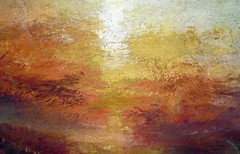
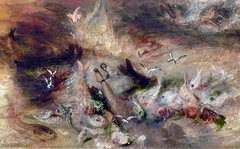

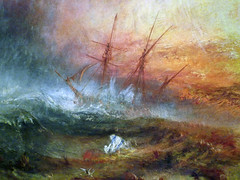
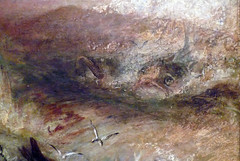
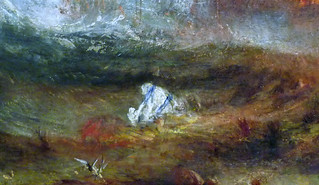
J.M.W. Turner, Snow Storm
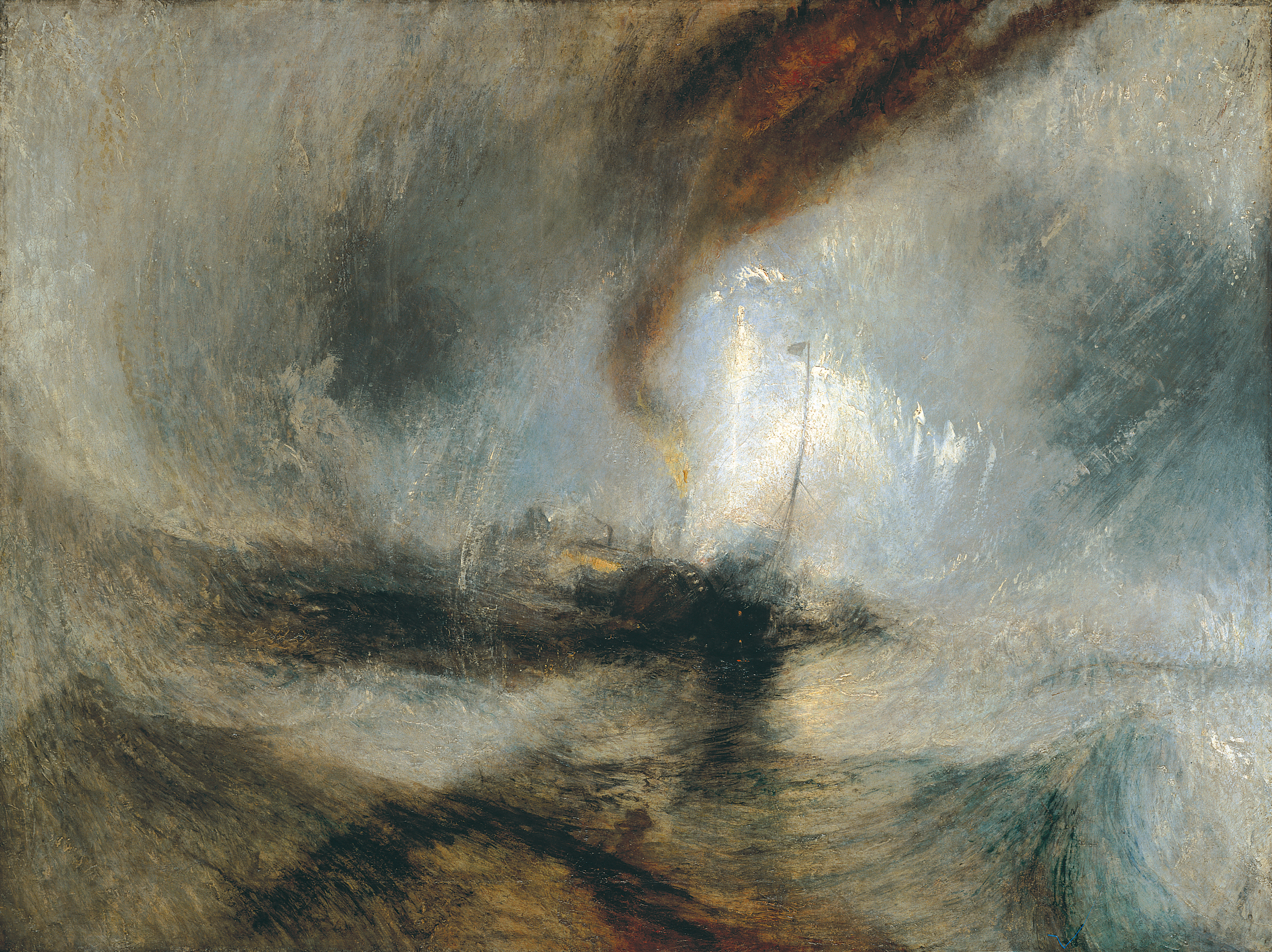
A perfect storm
From the midst of a fierce snowstorm a 200-ton paddle steamer and its human cargo dips below a cresting wave as it battles to reach shore. Our view — which could be from another boat, perhaps, or even dry land — is blurred by a miasma of snow, wind and brine. Meanwhile the boat’s storm-agitated movements are evoked by a coil of black coal smoke spiraling into the sky, a mast bent by the gale, and a white vertical streak — a futile distress flare — which has been repeated several times as if its afterimage has burnt itself onto our retinas.
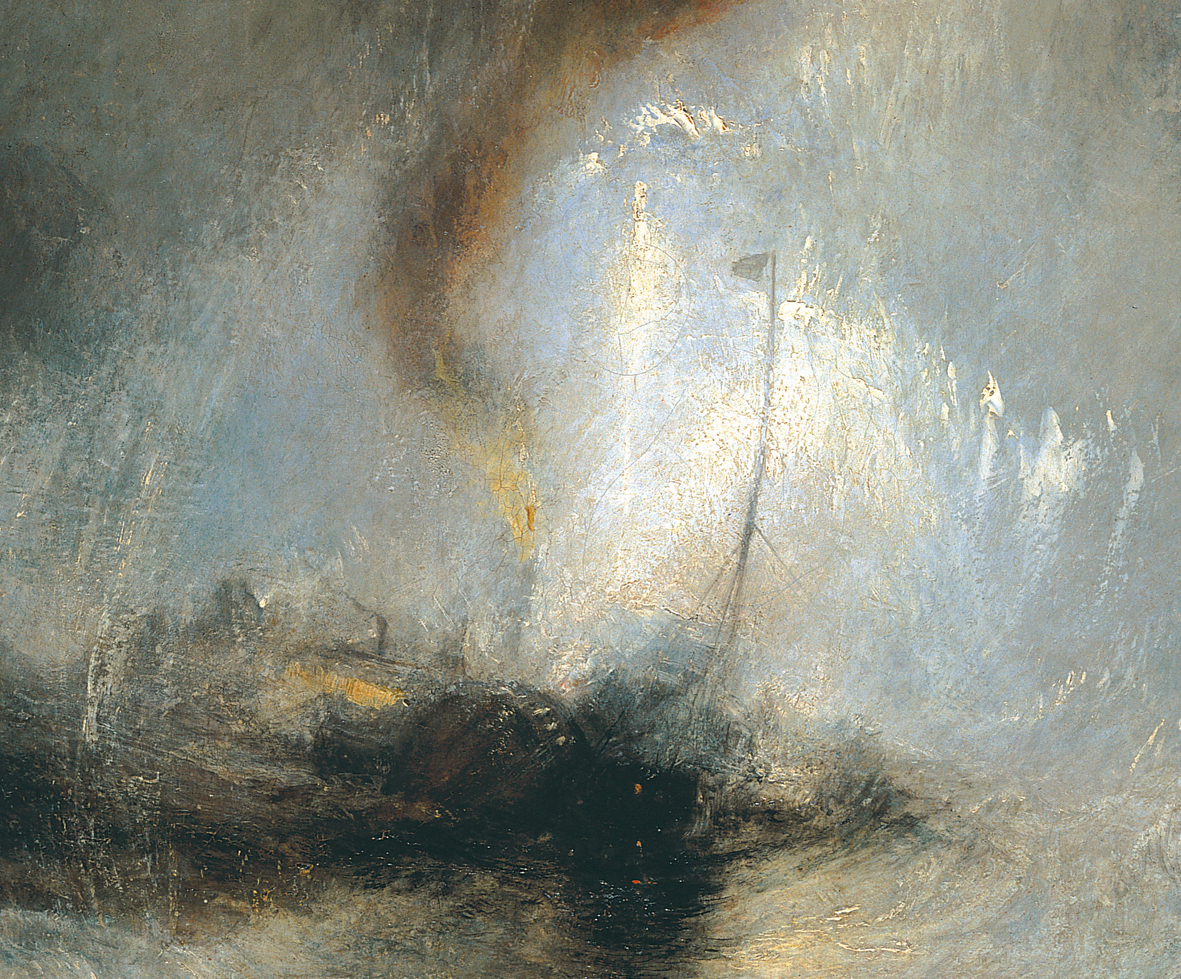
It is a startling, aggressive, thoroughly unconventional painting, and viewers at the British Royal Academy exhibition of 1842 — where it was first displayed — were bewildered and infuriated by its modern approach to a standard genre. We may empathize with the outrage if we compare Snow Storm to other nineteenth-century paintings of disasters at sea, like Théodore Gericault’s The Raft of the Medusa (1819).
In the Turner, clarity is exchanged for an expressive, almost abstract painterly execution. The painting’s visual structure is based around a swirling vortex rather than a stable pyramidal composition. It is also a virtually monochromatic image where sea and sky merge and spatial depth is hard to gauge. And rather than maintaining a consistent technique across the painting, Turner chopped and changed his approach — underpainting with oils mixed with turpentine to achieve a hazy watercolor effect, then using thick paint applied with a hog’s-hair brush and palette knife to generate rapid, gestural and broken slashes of color over the top. In other paintings he swiped, smeared and scratched at the surfaces he worked on, sometimes even spitting at them in an energetic frenzy. Turner’s violent techniques are well matched to the turbulent subject matter of this painting.
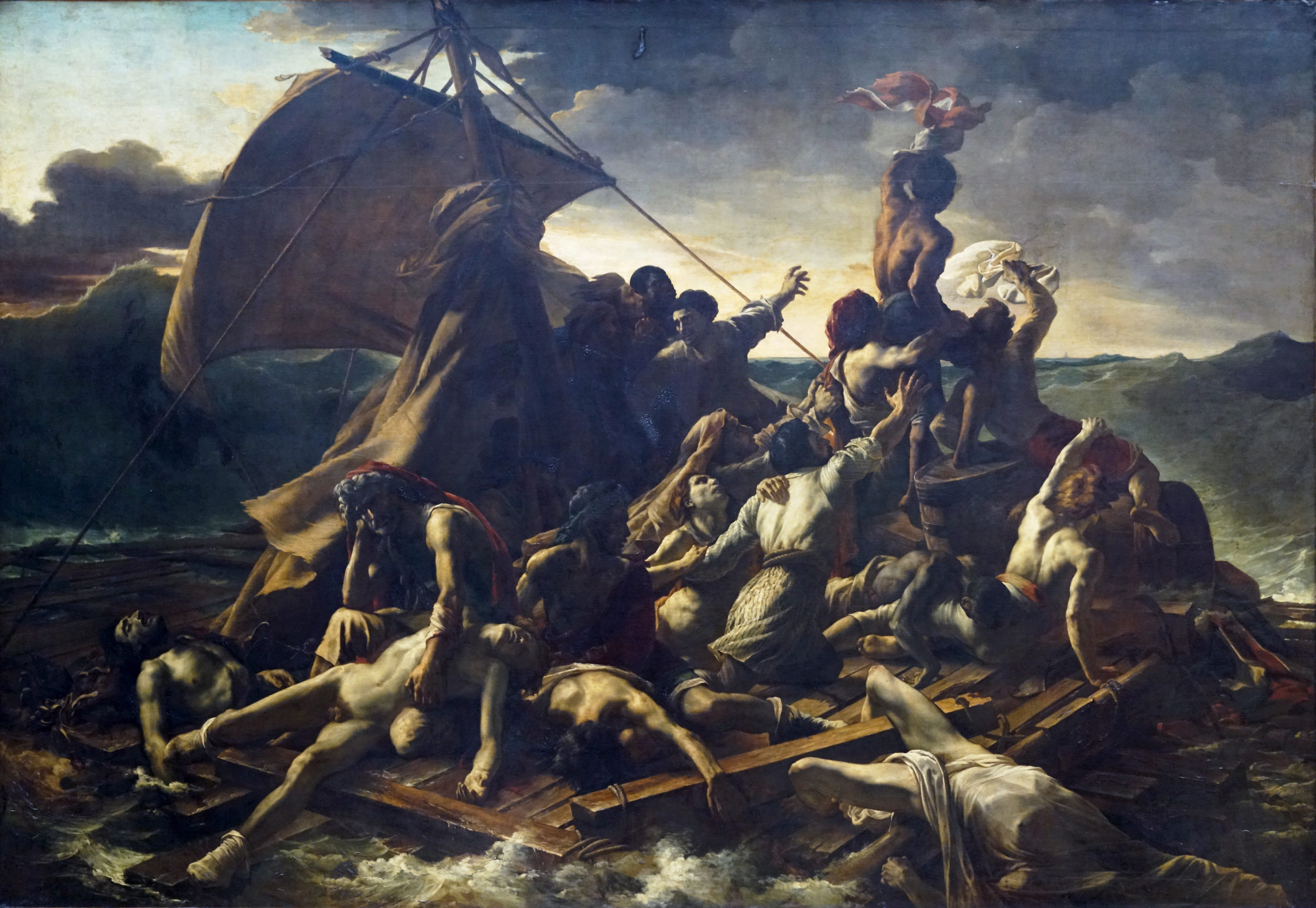
The relationship between title and image is also instructive. The painting’s name is extended and highly detailed, suggesting a record of a very particular maritime event, witnessed by the artist. Turner’s aim appears to be to show us that this is not merely artistic free-styling or an example of “art for art’s sake” (as Théophile Gautier had put it in 1835), rather it is a serious attempt to see nature truly and transcribe it afresh. At the same time its focus on a moment of high jeopardy in the face of nature’s wrath invites us to contemplate broader themes such as humanity’s struggle for rationality and sensory certainty in a world underwritten by chaos.
A painting of revolutions
Turner was knowledgeable about art history and throughout his career aimed to honor and emulate famous artists from the past such as Claude, Titian, and Rubens. At the same time, he also sought novel visual experiences, leading him to take an interest in contemporary events and modern technology. One such novelty were coal-powered steamboats, like the one depicted in Snow Storm, which came into widespread use in 1812, supplanting the use of sails and oars which had been used for the previous 4000 years of human history.
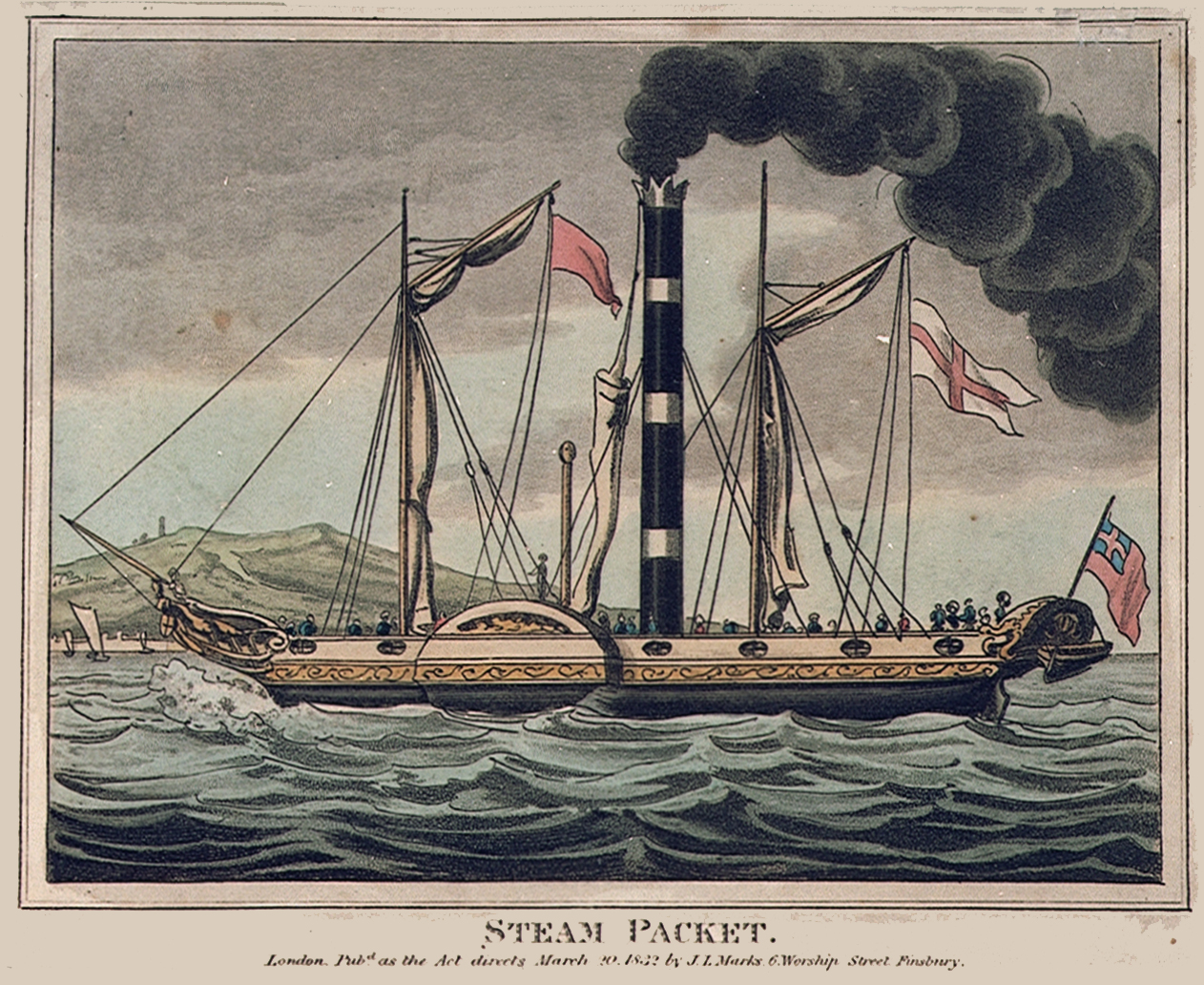
This change was just one that had defined the Industrial Revolution, a historical event which marked a pivotal change in society and humanity’s relationship with nature. One revelation was that nature was filled with energy, stored in matter such as coal and water, which could be unleashed and controlled to further human aspirations. Thus Snow Storm shows a modern appreciation of the landscape, in which all matter is surging with dynamic but untapped forces. This is not a triumph though: Turner has belittled the Industrial Revolution’s newest technology by subjecting it to the far greater might of nature.
The philosophy of fear
Like a disaster movie, Turner’s painting transforms a natural catastrophe — with death a near-certainty — into entertainment. “When danger or pain press too nearly, they are incapable of giving any delight, and are simply terrible” Edmund Burke had written in 1757, “but at certain distances, and with certain modifications, they may be, and they are, delightful.” [1] This morbid delight was given a name by Burke: the “sublime,” a condition of controlled terror, produced by a confrontation with nature’s overwhelming power. The reason that “sublime” art is appealing is probably because it contextualizes the audience’s own small stresses and anxieties by showing them the magnitude of the “bigger picture.” Turner was well aware of Burke’s theory of aesthetics and has become one of the most renowned advocates of the “sublime” in painting.

Turner later claimed in conversation that before painting Snow Storm he strapped himself to the mast of a ship and asked the owner to sail into a storm for four hours. This, and the claim to first-hand experience made in the title, urge us to regard Turner as a swashbuckling figure who fearlessly confronted the sublime in the name of art. However, as Barry Venning has pointed out, Turner was 65 in 1842, and according to historical records no ship called the Ariel sailed from Harwich at this time.
Fake though his story may have been, Turner’s self-mythologizing is still of interest, as it connects him to a broader cultural movement: Romanticism. This loose-knit intellectual phase in art, literature and music rebelled against Neoclassicism (which had been more focused on the intellect, collective responsibility, and controlled emotions) and instead put the focus on emotive responses, individual feelings and the overwhelming power of nature. Turner’s tall tale situates him as a prime exemplar of this self-oriented and expressive artistic tendency.
Legacy
This painting, like many others by Turner, split contemporary opinions. It certainly came under attack from many critics, one of whom called Snow Storm mere “soapsuds and whitewash” (i.e. dishwater and house-paint). On the other hand, English art critic John Ruskin called the painting “one of the very grandest statements of sea-motion, mist, and light, that has ever been put on canvas.” [2] Ruskin later famously called Turner “the father of modern art.”
A positive consensus about Turner’s reputation has grown and strengthened significantly since the mid-nineteenth century: the artist has been dedicated an entire separate section in Tate Britain known as the Clore Gallery. Britain’s most prestigious contemporary art prize — the “Turner Prize” is also named in his honor, and in February 2020 he was commemorated on the reverse of the new £20 banknote.
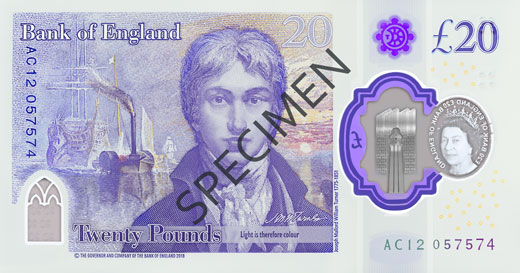
Turner’s bold, expressive techniques influenced French more than British art in the nineteenth century, with Claude Monet and the Impressionists especially admiring his pioneering and experimental techniques and representation of light. In the twentieth century, Abstract Expressionists like Mark Rothko, Jackson Pollock, and Barnett Newman were influenced directly or indirectly by Turner’s handling of paint and his engagement with “sublime” subject matter.
Notes:
- Burke, Edmund, Burke’s philosophical inquiry into the origin of our ideas of the sublime and beautiful: with an introductory discourse concerning taste (London: J.F. Dove, 1827), p. 34.
- Ruskin, John., Modern painters. Volume I. containing Parts I. and II. Of general principles, and Of truth (London: Smith, Elder and Co., 1867), p. 359.
Additional resources:
J.M.W. Turner at The Metropolitan Museum of Art’s Heilbrunn Timeline of Art History
J. M. W. Turner, Rain, Steam, and Speed — The Great Western Railway
by DR. BETH HARRIS and DR. STEVEN ZUCKER
Video \(\PageIndex{14}\): Joseph Mallord William Turner, Rain, Steam, and Speed — The Great Western Railway, oil on canvas, 1844 (National Gallery, London)
Rain, Steam, and Speed — The Great Western Railway was exhibited at the Royal Academy in 1844. It depicts the Maidenhead Railway Bridge (completed 1838) looking east, across the River Thames between Taplow and Maidenhead.
Smarthistory images for teaching and learning:
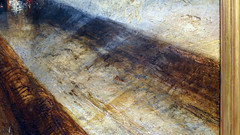
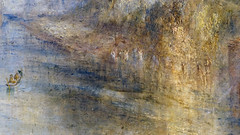
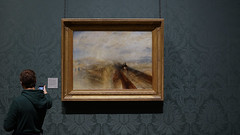
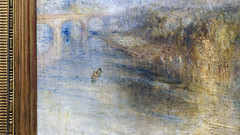

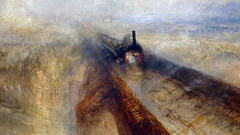
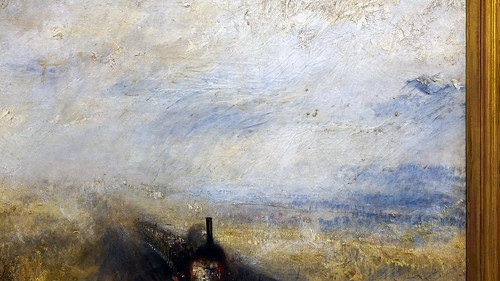
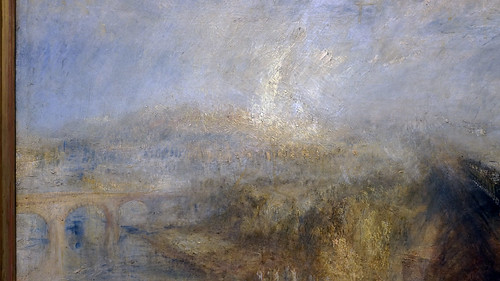
John Martin, The Great Day of His Wrath
by BEN POLLITT

From the sublime to the ridiculous?
For some critics, in the hands of John Martin, the sublime (see note at the bottom of the page) in British landscape painting had slipped irrevocably into the ridiculous. For others, his work is innovative and exciting, a masterful re-energising of the landscape genre, and for evidence, they point to perhaps his most famous work, The Great Day of His Wrath.

Whatever one’s aesthetic judgement of Martin’s work, it is hard to ignore the echoes it finds in today’s popular culture—think of all the big-budget apocalyptic films with their over-the-top special effects. Like the once popular sermons invoking hellfire and brimstone, there has always been a popular appetite for doomsday scenarios and the more vividly brought to life the better.
What Martin added to these old religious formulas was a new and distinctly scientific dimension. He also utilized the traditional formulas of landscape painting—in the same way as films such as 2012 use cinematic conventions to address contemporary anxieties about the changing environment and the effect that man has on it.

Part of a triptych of ‘judgement pictures’ inspired by the description of the Last Judgement in the Book of Revelation, The Great Day of His Wrath depicts this terrifying passage: “there was a great earthquake and the sun became black as sackcloth of hair and the moon became as blood. And the heaven departed as a scroll… and every mountain and island were moved out of their places.”
That Martin also worked as a theatre set designer is hardly surprising; in its large scale, its dynamic composition and its dramatic use of light and dark the painting is nothing if not spectacular. But then that was the idea.
An immersive spectacle


A Victorian audience would have paid to see this painting together with its two companion pieces, The Plains of Heaven (1851-3) and The Last Judgement (1853). Seated in rows of chairs, just like in a theatre, they would have waited in darkness for the performance to begin. Then the lights would go up, and using the latest technical gadgetry, forms in each of the paintings would be spotlighted: the lightning flash, the rolling mountain top with the ancient temple falling, the Whore of Babylon (a figure of evil mentioned in the Book of Revelation) lurching toward Hell’s Mouth. Accompanying this visual spectacle were sound effects and a blood-and-thunder script that would be read out by voices offstage.
It is hard to imagine when looking at the painting in the context of a modern picture gallery or on the Internet, but originally it would have been experienced more like a piece of theatre than a work of art. Such immersive spectacles were common in England at the time. In the early 1820’s, Gericault’s exhibited The Raft of the Medusa in London where it was similarly sold to the public as a visual spectacle rather than a revolutionary work of art. With no buyer for the painting in Paris, it was a shrewd financial move on Gericault’s part to have it shipped over.
As for Martin’s works, the exhibition was a triumph and went on with continuing success to tour across Europe and America. Sadly, though, Martin suffered a stroke after finishing the last of the three paintings, and he died soon afterwards.
Dark satanic mills?
Recently critics have tended to read The Great Day of His Wrath as a comment on the impact of industrialization, a point supported by the testimony of Martin’s son, who said that his father was inspired to paint the scene after making a journey at night through the “Black Country,” one of the most intensely industrialized areas in England at the time. A Londoner himself, the sorry state of the capital was also probably on Martin’s mind. In the middle of the nineteenth century, London was a pretty hellish place to live.
The “dark satanic mills” that the poet William Blake wrote of and the new factories and machinery of the industrial age had replaced farms and wrecked rural communities. Meanwhile, the population of cities across Western Europe and American exploded at a terrifying rate, causing slum dwellings, extreme poverty, and poor sanitation.

The Thames itself, the source of London’s water supply, also caused the deaths of hundreds every week from cholera during periods of epidemic. Something had to done and in the late 1820s Martin took it upon himself to do it, submitting a proposal to parliament which provided a detailed plan for the construction of a sewage system that would help remedy the crisis. His plans were rejected.

As a belated repost, perhaps, in 1841, he painted Pandemonium in which Milton’s Satan stands before his diabolical city, a river of lava running past it. The design of the building bears an uncanny resemblance to that of the as yet uncompleted Houses of Parliament situated right on the banks of the foul and pestilential Thames.
Painting in the age of Darwin
In addition to civil engineering, Martin was preoccupied with new and emerging branches of scientific inquiry, including geology and paleontology. As an illustrator of natural history (typically Victorian, he liked to keep himself busy), he created imaginative reconstructions of dinosaur species based on fossil remains. In The Great Day of His Wrath the earth assumes a monstrous aspect, the tumbling boulders like the colossal jaws of a giant primordial beast devouring itself.

For Martin, this new vision of a dynamic, pre-historic Earth, constantly shifting and evolving, was a spur to the artistic imagination. Painting in the age of Darwin, his biblical/scientific works, like The Great Day of His Wrath, serve also to illustrate contemporary debates among theologians and scientists concerning the historical accuracy of Biblical sources. Geological studies in rock strata challenged theologians who used the Bible to calculate that the world was a mere six thousand years old. The notion that strange and unknown species might once have walked the earth would have been shocking to those that believed that the natural world reflected a divine and unchangeable model.
A note on the sublime
The “sublime” is a key concept in the history of art. The word itself dates back to the ancient Greek writer Longinus, who put forward the idea that art should not just be well formed but also sublime, that is to say capable of moving or transporting us emotionally. For examples of this he points to the epic poetry of Homer and Virgil.
The modern meaning of the word, used to describe that which inspires awe and terror gained currency in the middle of the Eighteenth Century and was defined first by the Irish philosopher and politician, Edmund Burke. Burke’s A Philosophical Enquiry into the Origin of Our Ideas of the Sublime and Beautiful (1757) is a crucial text in establishing notions of the Sublime. The Beautiful, according to Burke, is what is well-formed and aesthetically pleasing, whereas the Sublime is what has the power to compel and destroy us. The preference for the Sublime over the Beautiful was to mark the transition from the Neoclassical to the Romantic era.
Other philosophers sought to define the meaning of the sublime including Immanuel Kant and later, Arthur Schopenhauer. In his book The World as Will and Representation (1818), Schopenhauer outlined the difference between Beauty and the Sublime as follows:
Feeling of Beauty – Light is reflected off a flower. (Pleasure from a mere perception of an object that cannot hurt observer).
Weakest Feeling of Sublime – Light reflected off stones. (Pleasure from beholding objects that pose no threat, yet themselves are devoid of life).
Weaker Feeling of Sublime – Endless desert with no movement. (Pleasure from seeing objects that could not sustain the life of the observer).
Sublime – Turbulent Nature. (Pleasure from perceiving objects that threaten to hurt or destroy observer).
Full Feeling of Sublime – Overpowering turbulent Nature. (Pleasure from beholding very violent, destructive objects).
Fullest Feeling of Sublime – Immensity of Universe’s extent or duration. (Pleasure from knowledge of observer’s nothingness and oneness with Nature).
Additional resources:
This painting in the Tate Britain
The two works that, together with this one, form the triptych: The Last Judgment and The Plains of Heaven
Derided Painter John Martin makes a Dramatic Comeback (The Guardian)
Smarthistory images for teaching and learning:
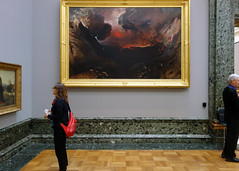
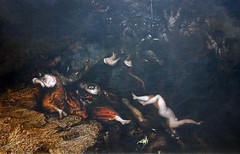
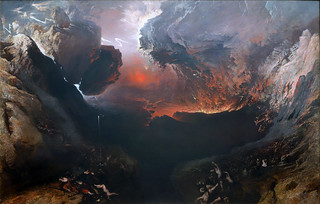
John Nash, Royal Pavilion, Brighton

“How can one describe such a piece of architecture?”
“How can one describe such a piece of architecture? The style is a mixture of Moorish, Tartar, Gothic, and Chinese and all in stone and iron. It is a whim which has already cost £700,000, and it is still not fit to live in.”¹
Such was the verdict of the Austrian statesman Klemens von Metternich on the eclectic, exotic and sensuous Royal Pavilion at Brighton.
While not all the contemporary reactions to the Pavilion were critical, John Evans, for example, admired it for both its “beauty” and “grandeur,”² it was a building which provoked a predominantly critical response in Regency England (in political terms the period from 1811 to 1820 when George, Prince of Wales—future George IV—ruled in place of his ailing father George III; and in cultural terms up until the death of George IV in 1830). The New Brighton Guide called it a “masterpiece of bad taste” while the Comtesse de Boigne declared it a “mad-house.”³ And when Queen Victoria first visited the Royal Pavilion in 1837, she noted, “The Pavilion is a strange, odd, Chinese looking place, both outside and inside. Most of the rooms are low, and I can see a morsel of the sea, from one of my sitting room windows.”4

The patron: The Prince Regent
The ostensible aesthetic randomness of the Pavilion is best comprehended as the material expression of the profligate and rebellious life of its extraordinary benefactor, the Prince Regent, the future George IV, undoubtedly the greatest royal patron of the arts since King Charles I. A man of easy wit and charm, as well as political indolence and questionable morals, the Prince was the touchstone of style for the fashion-conscious Georgian elite of the day. He first visited the seaside resort of Brighton in 1783 to benefit from its reputedly medicinal waters. Captivated by the picturesque promise of the area, the Prince purchased a “superior farmhouse” in 1786 and engaged the royal architect Henry Holland to convert this modest building into a Neo-Classical “marine pavilion” fit for a royal personage at play. Under the influence of the Prince Regent, William Porden, Nash’s assistant, added a large stables and riding school in the Indian style which would be the decorative prototype for the “Oriental” incarnation of the Royal Pavilion by its principal architect, John Nash.

The architect: John Nash
John Nash was the perfect professional partner for the Pavilion’s colorful patron. Subsequently criticized for an overly fashionable and reckless approach to architectural practice, and a resultant lack of purity in the finished product, Nash had planned Regent’s Street and Regent’s Park in London as a celebration of the rise of the new consumer classes.

Nash’s vision for Brighton was informed by the Prince’s aesthetic sensibilities and colorful personality and the architect’s own experiences of the Picturesque (the beauty inherent in unspoiled nature, as first outlined by the artist William Gilpin), as well as the aquatints of “hindoo” architecture which appeared in the six-volume Oriental Scenery by the landscape painters Thomas and William Daniell at the end of the 18th century. The result was the so-called “Eastern” style, comprised of an assortment of architectural and design forms and motifs taken from Britain’s colonial experience of the “Orient.”

The “Eastern” style
Without denying the central agency of both the bold-thinking Nash and fashion-conscious Prince Regent in the design of the Royal Pavilion, the range and variety of architectural styles should be viewed within the context of a wider cultural tradition just then emerging. This exotic mad-house was a response to the early British Empire and its East India Company (a trading company established in 1600 with a fleet of ships and an army 200,000 strong) that facilitated the rule of the Indian sub-continent for some two hundred years and which shaped the British Empire. Here was trade from the East, a rich complex of cultural interchange, and a fascination for the “Orient” in its widest, and loosest, colonial meaning. As the architectural historian Ian Sutton has written, in the nineteenth century, “Both [architects] and their patrons were assailed by new temptations which they found difficult to resist.”5

The Pavilion was not in fact the first building in England to respond to the exotic world of the nabobs (officials who had acquired great wealth) of the East India Company (see for example William Chambers’ Great Pagoda, 1762, at Kew Gardens above, and C.P. Cockerell’s Sezincote, 1810 in Gloucestershire below).

Both buildings predate the Pavilion. Moreover, juxtaposing a culturally alien interior to the exterior was not a new idea, and was in some sense a colonial interpretation of the cultures of the lands of Empire. Henry Holland’s French Neo-Classical Carlton House, 1783–96 in London, for example, boasted a fine Chinese drawing room. As such, Brighton Pavilion could be seen as the culmination of years of experimentation, rather than a one-off, stand-alone enterprise.

What does mark Brighton Pavilion out from the above examples, however, is its fundamental expression of Regency England Romanticism derived from the world of letters. Samuel Taylor Coleridge’s opium-fueled poem “Kubla Khan,” a classic of Romantic literature, published in 1816, famously speaks of the “stately pleasure-dome” of the Mongol ruler. One of the confidants of the Prince Regent was William Beckford, notorious hedonist and author of Vathek: An Arabian Tale (1786), whose earlier story of the outrageous ninth Caliph of Abassides was inspired by both The Arabian Nights and Horace Walpole’s The Castle of Oltranto (1764), the latter being the novel that ushered in the Gothic genre in English literature. Indeed, the only true architectural precursor to the Pavilion in this Romantic Gothic tradition is probably Walpole’s own Strawberry Hill (see image below), an early example of Gothic Revival architecture, which applies “Gothick” forms and motifs in a similarly imaginative way as the Pavilion.

The “Indian” exterior
Architecturally, the “Indian” exterior owes much to C.P. Cockerell’s Sezincote; however, there is in reality a significant difference which speaks of the changing fashions and the further development of exotic eclecticism in this period. Sezincote is hybridic: it retains a Neo-Classical facade (the windows and bays), whilst sporting a turquoise onion-shaped Mughul dome and minarets, typical of Islamic architecture of the Indian sub-continent, such as the Taj Mahal, and features a Hindu-inspired garden, including a temple.

The Pavilion’s exterior, on the other hand, is more uniformly Mughal-flavored, albeit shot through with a generic sense of the “Orient”: namely the arabesque profusion of ten domes and ten minarets, supported by a cast iron frame, and the vertical thrust of the building, giving it a sense of lightness and airiness, an almost dream-like temporary tent-like quality, in opposition to the permanent horizontal-axised stout square-blockedness of Sezincote.

The “Chinese” interior
As for the interior of the Pavilion, while England’s curiosity for Chinese culture predates that of its interest in Indian civilization by almost a century, the former’s application to the inside of Nash’s building is complex, for we have in fact the Neo-Classical, Chinese and Gothic at work together. The Entrance Hall (see image below), for instance, is symmetrically arranged, as per the Neo-Classical; while the Long Gallery (see image above) contains a multitude of generic Chinese/Asian features (“Chinoiserie”), including the hexagonal lanterns, the silk tassels and the motif of bamboo and birds on the wallpaper, the work of interior decorator Frederick Crace.

Finally, the decoration along the cornice in the Entrance Hall, and in the Banqueting Room Gallery, is clearly related to fan-vaulting found in English medieval churches.

Making sense of a ‘mad-house’
The Royal Pavilion at Brighton in all its apparent kaleidoscopic silliness, brashness, vitality, phantasmagoric contradictions and oppositions, references, and tries—though not always succeeds—to respond to the tastes of a new fashionable elite at home and to make sense (or not) of a new world of empire abroad. Indeed, in all its range and variety, as well as in its playful eccentricities, it is quite possibly the ultimate architectural manifestation of early nineteenth-century eclecticism, as well as being the material personification of a powerful Regency personality and his private architect. The history of architecture in Britain is all the richer as a result.
1. Clifford Musgrave, Life in Brighton, London: Faber and Faber, 1970, p. 183.
2. John Evans, Recreation for the Young and the Old. An Excursion to Brighton, with an Account of the Royal Pavilion […}, Chiswick: Whittingham, 1821.
3. Anthony Pasquin, The New Brighton Guide, 6th Edition, 1796 and Comtesse de Boigne, Memoirs of the Comtesse de Boigne, ed. Charles Nicolland, 1907, II, (1815-19).
4. Victoriana Magazine, <http://www.victoriana.com/Travel/royalpavilion.htm> (1996 – 2013) [accessed 20 November 2013].
5. Ian Sutton, Western Architecture: A Survey from Ancient Greece to the Present (World of Art), (London: Thames and Hudson, 2000)
Additional resources:
Victoriana Magazine, “Discover the Royal Pavilion – Brighton”
De Boigne,Comtesse, Memoirs of the Comtesse de Boigne, ed. Charles Nicolland, (London: Heinemann, 1907), II, (1815-19).
Evans, John, Recreation for the Young and the Old. An Excursion to Brighton, with an Account of the Royal Pavilion, Chiswick: C. Whittingham, 1821.
MacKenzie, John. M, Orientalism: history, theory and the arts (Manchester University Press 1995).
Musgrave, Clifford, Life in Brighton, London, Faber and Faber, 1970.
Pasquin, Anthony, The New Brighton Guide, 6th Edition, (London: H.D. Symonds and T. Bellamy, 1796).
Sutton, Ian, Western Architecture: A Survey from Ancient Greece to the Present (World of Art), (London: Thames and Hudson, 2000).
Tyack, Geoffrey, “Nash, John (1752–1835),” Oxford Dictionary of National Biography, Oxford University Press, 2004; on-line edn.
Romanticism in Germany
Germany was home to some of Romanticism's greatest artists — Beethoven, Goethe and Friedrich.
c. 1800 - 1848
Caspar David Friedrich
Caspar David Friedrich, Monk by the Sea
by BEN POLLITT
Video \(\PageIndex{16}\): Caspar David Friedrich, Monk by the Sea, 1808 or 1810, oil on canvas, 110 x 171.5 cm (Alte Nationalgalerie, Staatliche Museen zu Berlin)
Friedrich the modern
It seems strange now but for a while the art world turned its back on the German painter Caspar David Friedrich. Aside from being cursed with the label of Hitler’s favorite artist, for much of the twentieth century the Impressionists, with their loose, painterly style, were held to be the fathers of modern art. Friedrich’s work in comparison was considered too meticulous, too precise, too finely detailed to warrant serious critical attention.

Over the last few decades though the tide of opinion has turned. Now it is generally accepted that both in his technical brilliance and theoretically in his views of what the purpose of art should be, Friedrich was as radical as they come. But if proof were ever needed again of his credentials as one of the great forerunners of modern art, then The Monk by the Sea would have to be it.
A new departure

Exhibited in the Academy in Berlin in 1810 along with its companion piece Abbey in the Oak Forest, it depicts a monk standing on the shore looking out to sea. The location has been identified as Rügen, an island off the north-east coast of Germany, a site he frequently painted.
The monk is positioned a little over a third of the way into the painting from the left, to a ratio of around 1:1.6. The same ratio can be found frequently in Western art and is known variously as the golden ration, rule or section. Aside from this nod to tradition however there is little else about this painting that can be described as conventional.
The horizon line is unusually low and stretches uninterrupted from one end of the canvas to the other. The dark blue sea is flecked with white suggesting the threat of a storm. Above it in that turbulent middle section blue-grey clouds gather giving way in the highest part to a clearer, calmer blue. The transition from one to the other is achieved subtly through a technique called scumbling in which one colour is applied in thin layers on top of another to create an ill-defined, hazy effect.
The composition could not be further from typical German landscape paintings of the time. These generally followed the principles of a style imported from England known as the picturesque which tended to employ well-established perspectival techniques designed to draw the viewer into the picture; devices such as trees situated in the foreground or rivers winding their course, snake- like, into the distance. Friedrich however deliberately shunned such tricks. Such willfully unconventional decisions in a painting of this size provoked consternation among contemporary viewers, as his friend Heinrich von Kleist famously wrote: “Since it has, in its uniformity and boundlessness, no foreground but the frame, it is as if one’s eyelids had been cut off.”
The monk

There is some debate as to who that strange figure, curved like a question mark, actually is. Some think it Friedrich himself, others the poet and theological Gotthard Ludwig Kosegarten who served as a pastor on Rügen and was known to give sermons on the shore. Kosegarten’s writings certainly influenced the painting. Von Kleist, for example, refers to its “Kosegarten effect”. According to this pastor-poet nature, like the Bible, is a book through which God reveals Himself.
Similarly, stripping it of any literal Christian symbolism, Friedrich instead concentrates on the power of the natural climate and so charges the landscape with a divine authority, one which seems to all but subsume the figure of the monk. With nothing but land, sea and sky to measure him by, his physical presence is rendered fragile and hauntingly ambiguous.
The rückenfigur

Originally the figure was looking to the right. His feet still point in that direction. Friedrich altered this at some point, having him look out to sea. The technique of positioning a figure with their back towards the viewer is often found in Friedrich’s art; the German word for it is the rückenfigur.
Monk by the Sea, the first instance of it in his work, is somewhat atypical in that the monk being so small and situated so low on the horizon does not ‘oversee’ the landscape the way Friedrich’s ruckënfiguren generally do.
The technique is much more complex and intellectually challenging than those found in the picturesque. Acting as a visual cue, the figure draws us into the painting, prompting us, challenging us even, to follow its example and simply look. And so we do. Yet its presence also obscures our line of vision and rather than enhancing the view in the end disrupts it. In this sense, the ruckënfigur while reminding us of the infinite beauty of the world also points to our inability to experience it fully, a contradiction that we often find expressed in German Romantic art and literature.
A political statement
Napoleon’s army was occupying Prussia when the painting was completed and art historians have naturally looked to read the painting and its companion, which depicts of a funeral procession in a ruined abbey, as a comment on the French occupation. It would have been dangerous to be openly critical of Napoleon’s forces so the paintings’ political messages are subtly coded.
Both paintings were purchased by the young Crown Prince, Frederick William, whose mother, Queen Louise, had died a few months earlier at the age of 34. An extremely popular figure, she had pleaded with Napoleon after his victory to treat the Prussian people fairly. Her death surely would have been fresh in people’s minds when they saw the paintings, a tragic loss which was very much associated with the country’s own defeat by the French.
The presence of death is certainly felt in The Monk by the Sea, though in the monk’s resolute figure we also find a source of spiritual strength, defiance even, standing, like that gothic abbey and those German oaks in its pendant, as much perhaps a symbol of the resolve of the nation against the foreign military rule, as of the individual faced with his mortality.
The Romantic
Like Constable, Friedrich drew on the natural world around him, often returning to the same area again and again. Unlike the English painter’s more scientific or naturalist approach, though, Friedrich condensed the image so as to communicate an exact emotion. As he put it, “a painter should paint not only what he sees before him, but also what he sees within himself.” It is this inward reaching project, using color and form to reveal emotional truths, that singles him out as one of the greatest and most innovative painters of his age: a true Romantic.
Additional resources:
Friedrich in the Google Art Project
The Alte Nationalgalerie, Berlin
The Whispering Zeitgeist, Beat Wyss on Caspar David Friedrich (Tate Etc. Magazine)
Smarthistory images for teaching and learning:
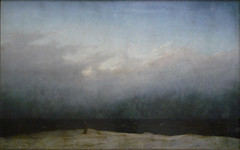
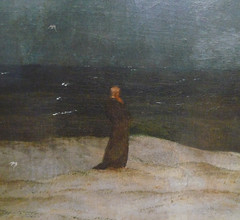
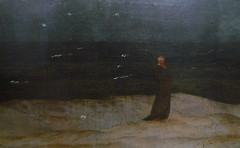
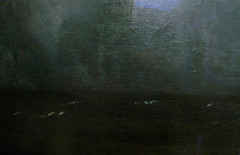
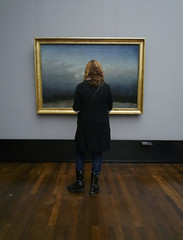
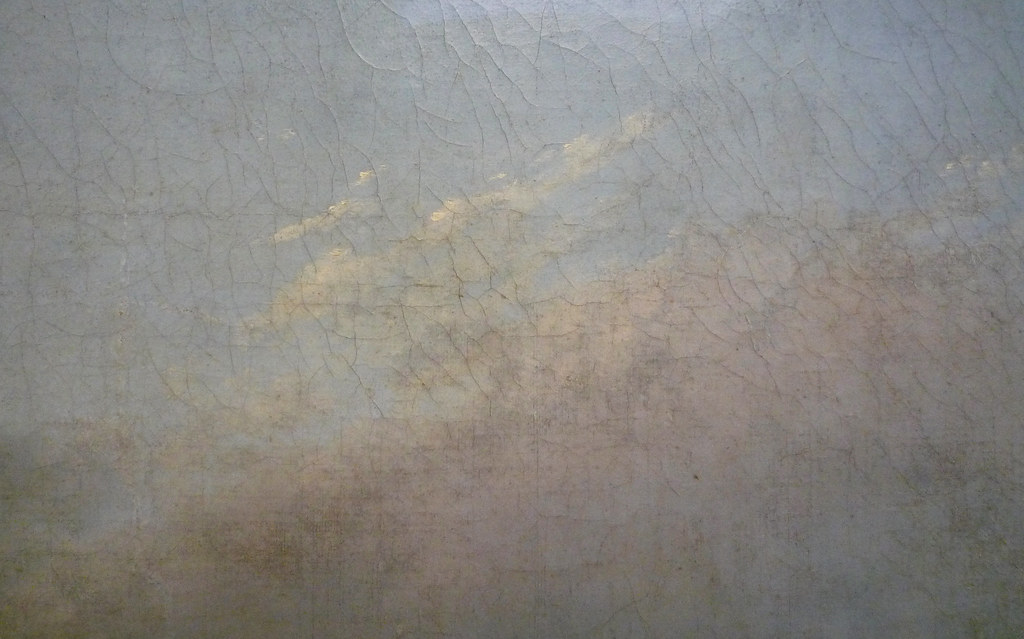
Caspar David Friedrich, Abbey in the Oak Forest
by DR. STEVEN ZUCKER and DR. BETH HARRIS
Video \(\PageIndex{17}\): Caspar David Friedrich, Abbey in the Oak Forest, 1809 or 1810, oil on canvas, 110.4 x 171 cm (Alte Nationalgalerie, Berlin)
Smarthistory images for teaching and learning:
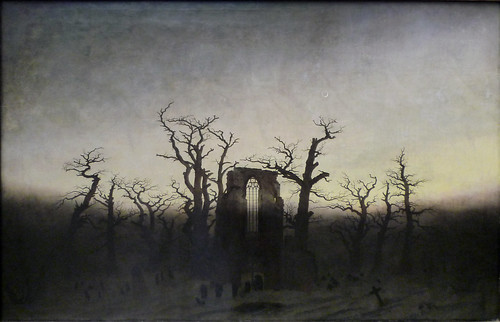

Caspar David Friedrich, Solitary Tree (or Lone Tree)
by DR. STEVEN ZUCKER and DR. BETH HARRIS
Video \(\PageIndex{18}\): Caspar David Friedrich, Solitary Tree (or Lone Tree), 1822, oil on canvas, 55 x 71 cm (Alte Nationalgalerie, Staatliche Museen zu Berlin)
Smarthistory images for teaching and learning:
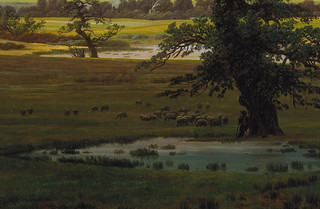
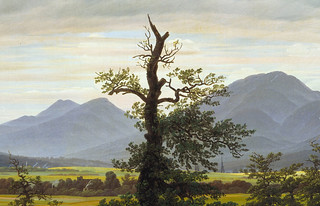

Caspar David Friedrich, Woman at a Window
by DR. STEVEN ZUCKER and DR. BETH HARRIS
Video \(\PageIndex{19}\): Caspar David Friedrich, Woman at a Window, 1822, oil on canvas, 44 x 73 cm (Alte Nationalgalerie, Berlin)
Smarthistory images for teaching and learning:
